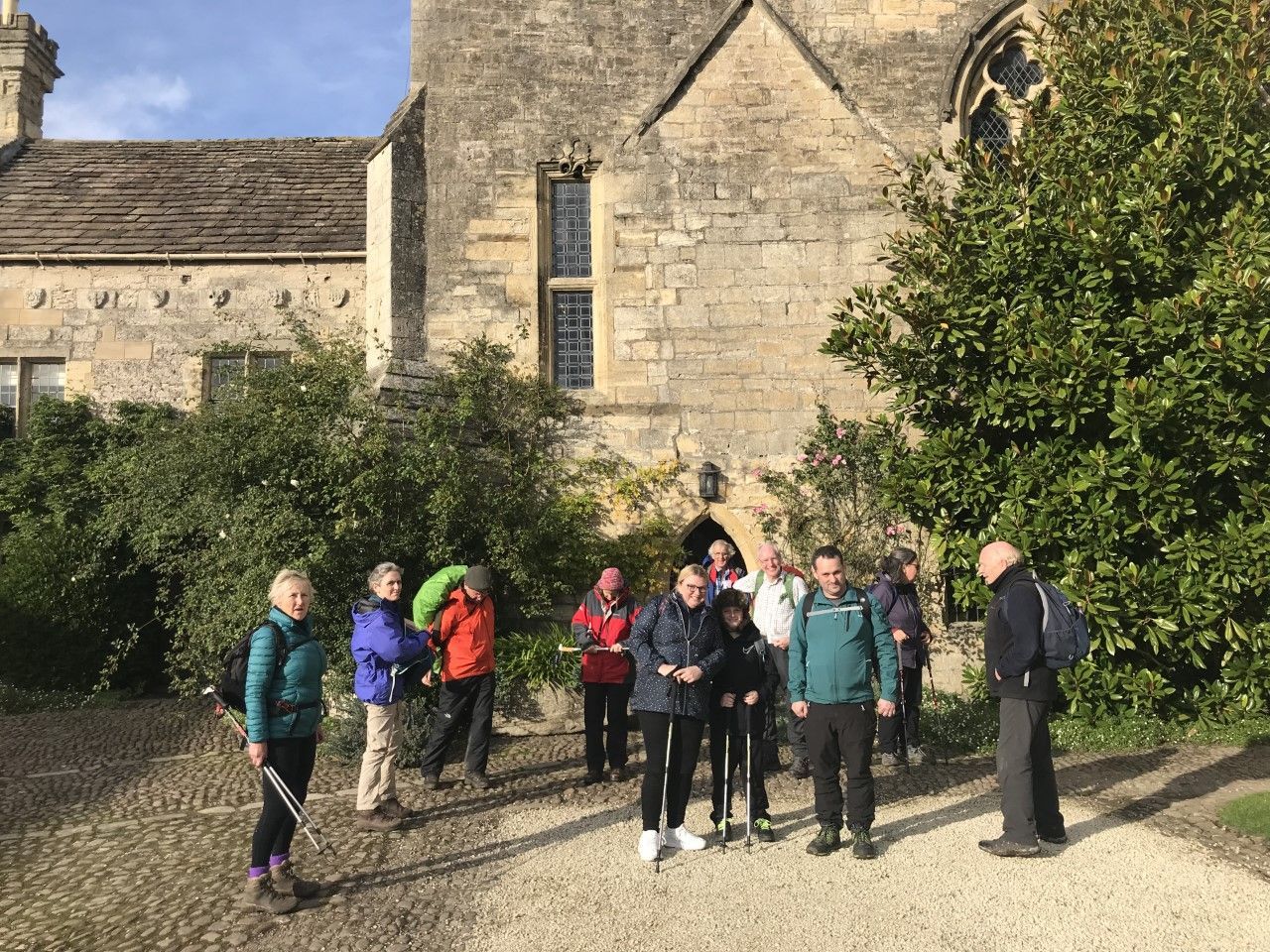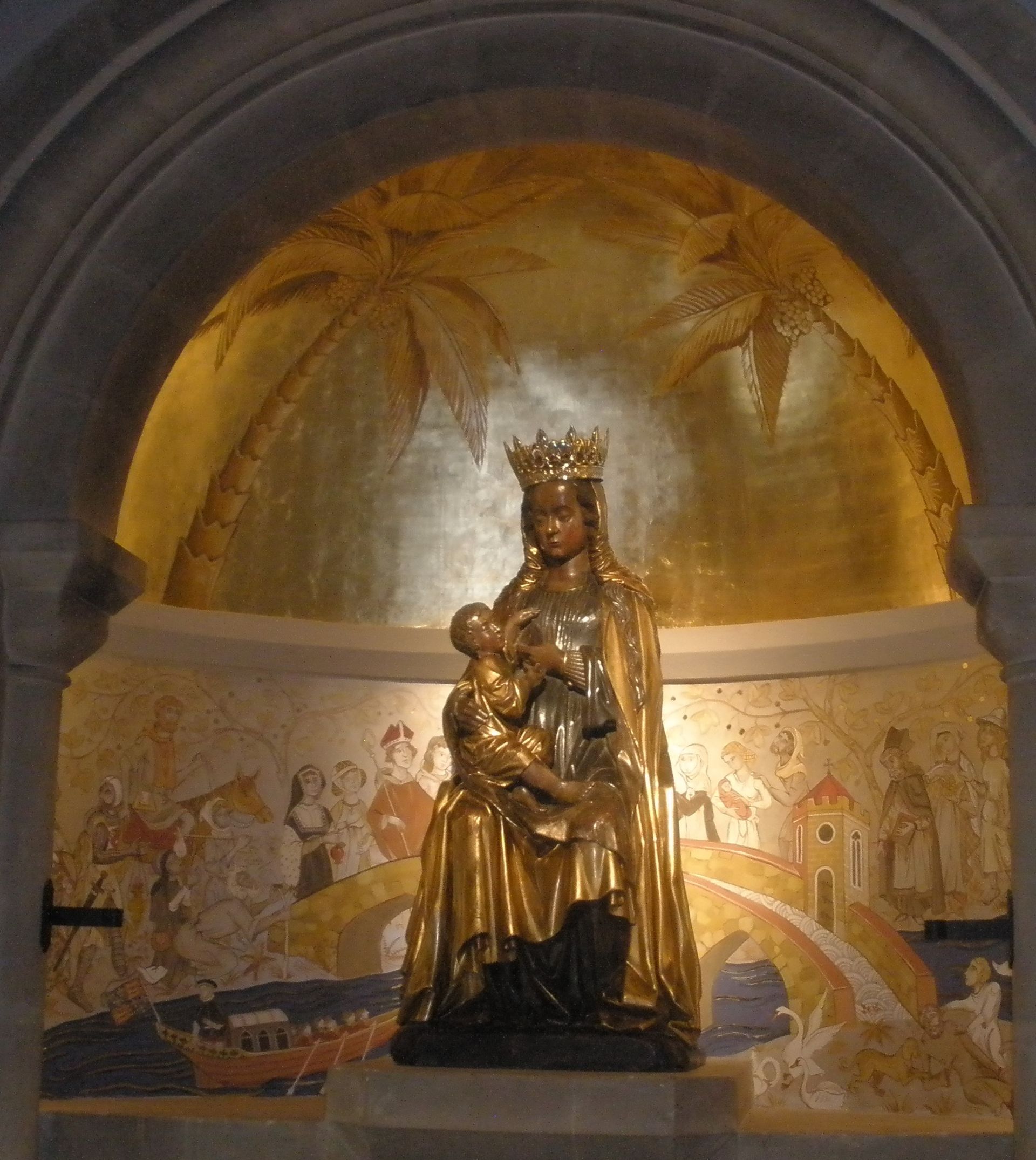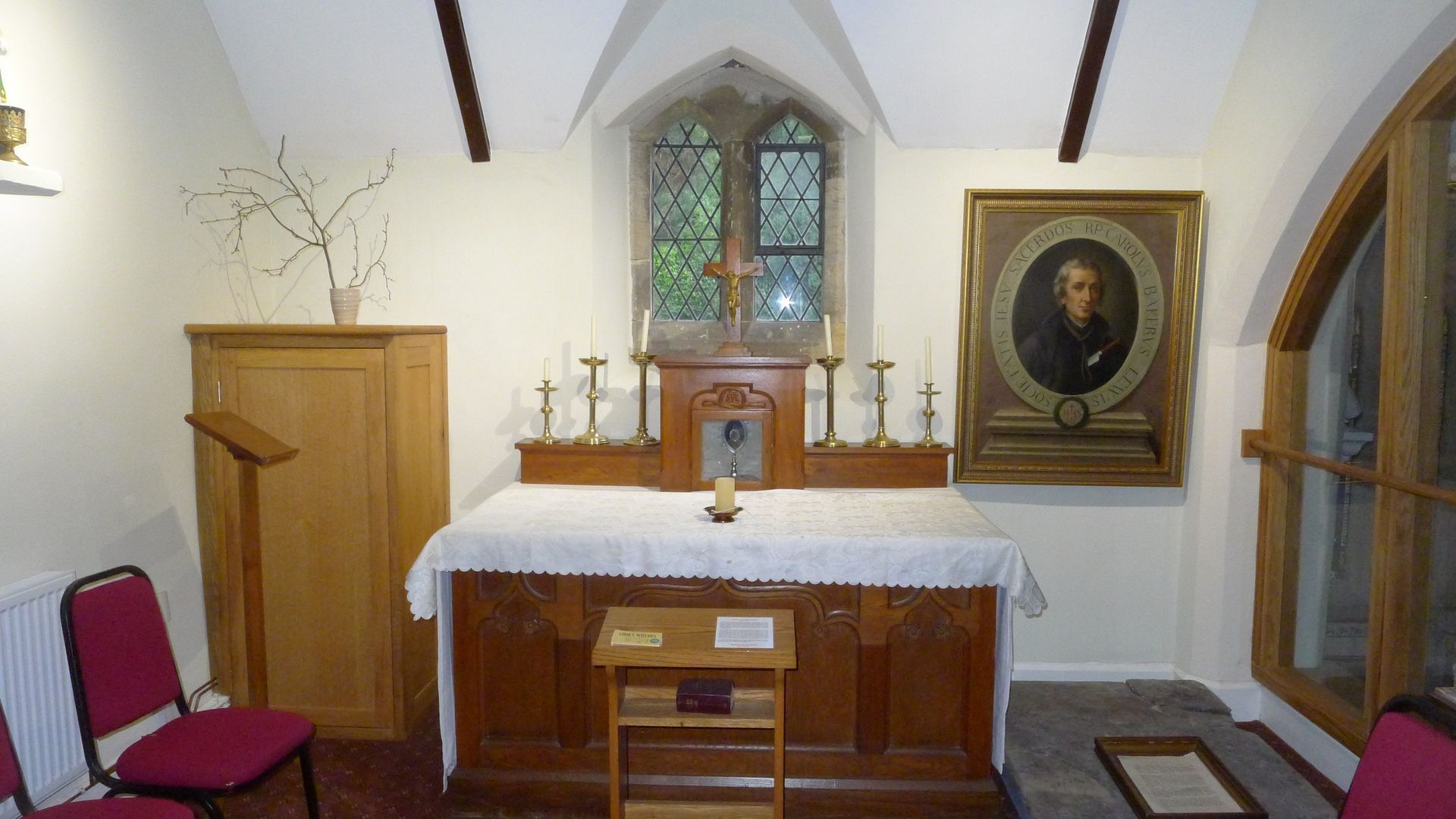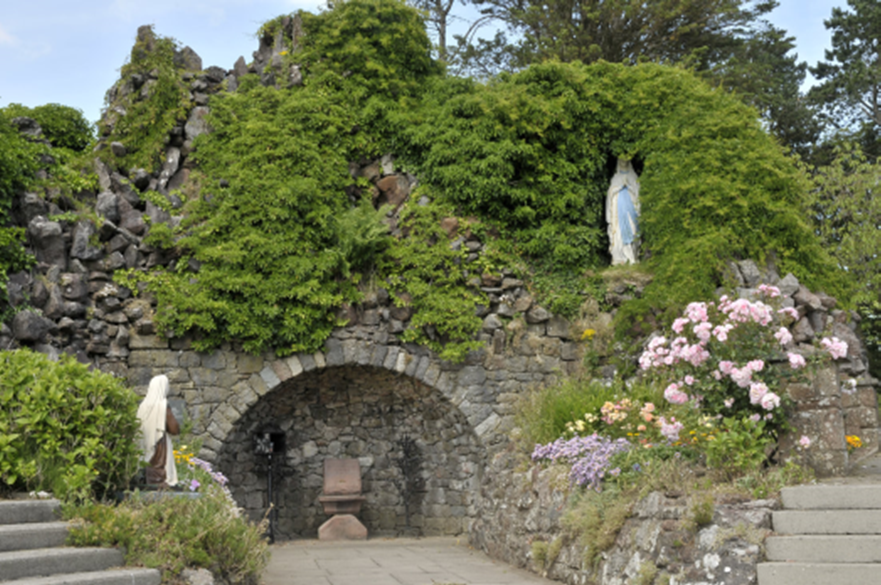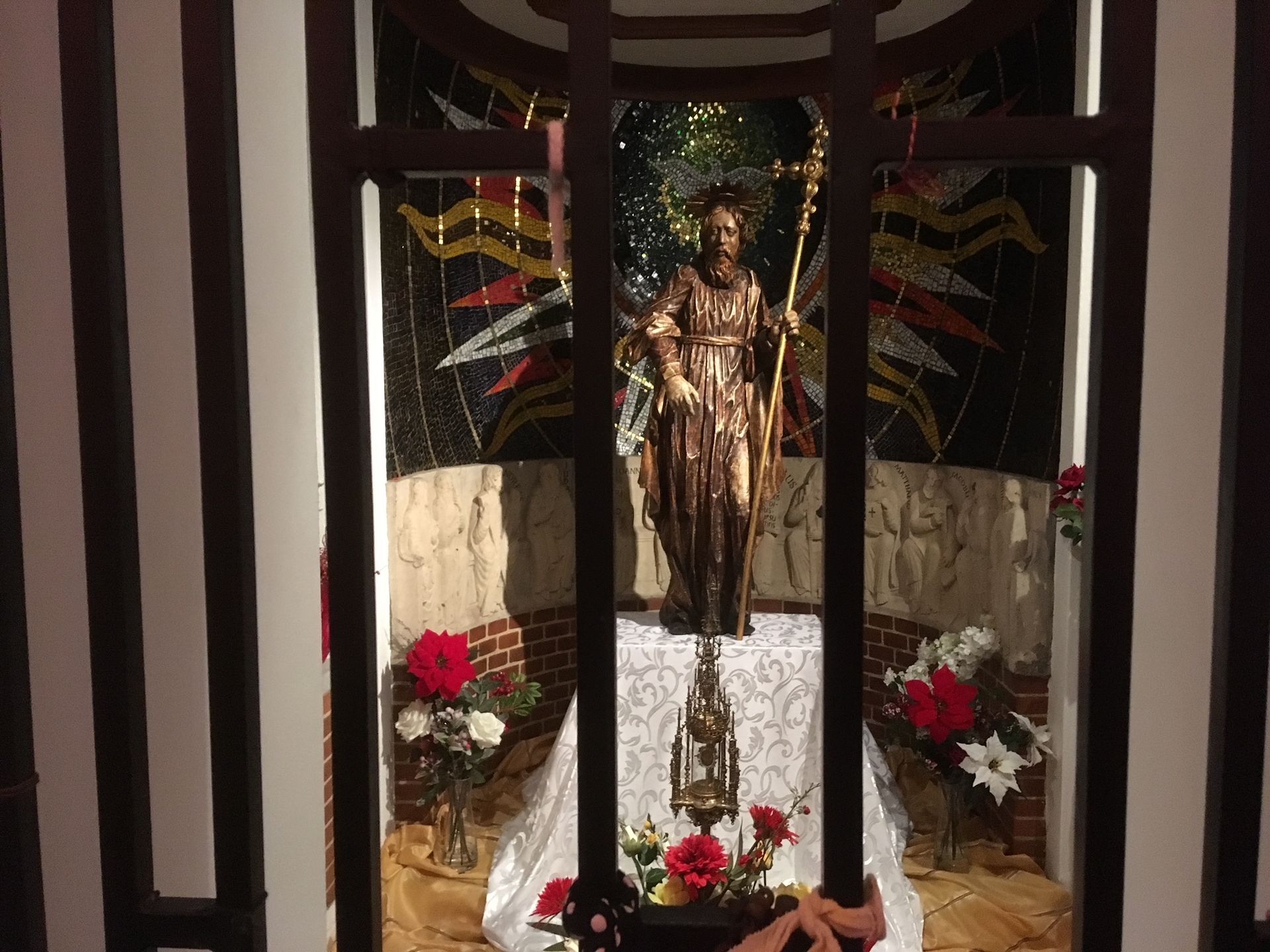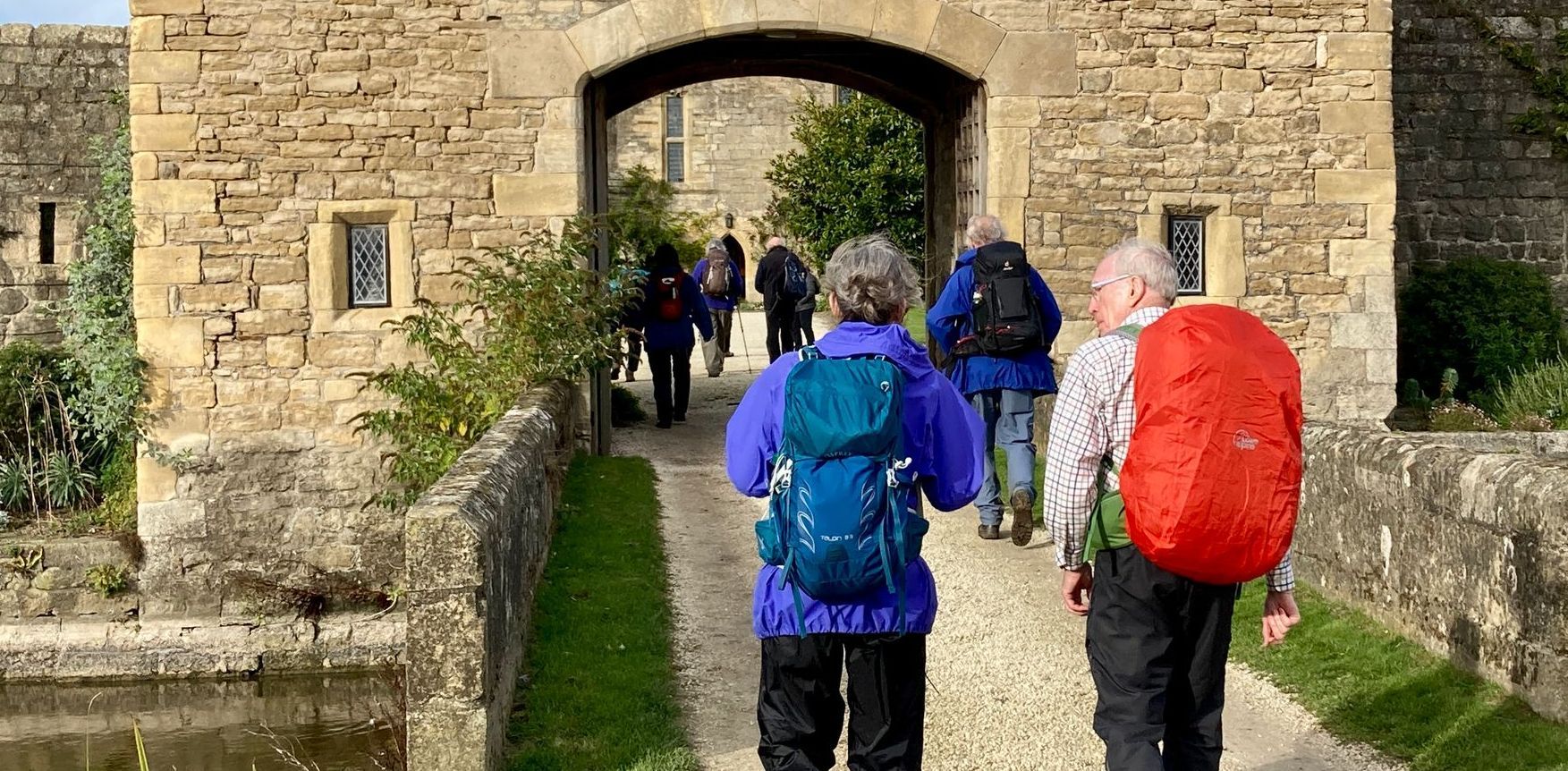CATHOLIC SHRINES OF
ENGLAND & WALES
Image: cbcew/Mazur
“The great stream of pilgrims, the humble and simple prayer of the People of God
alternating with liturgical celebrations,
the fulfilment of so many graces that many believers affirm they have received,
and the natural beauty of these places enable us to see how shrines, in their various forms,
represent an irreplaceable opportunity for evangelization in our time.”
Pope Francis
What is a shrine?
Anyone can set up a shrine in their own home; simply a place for prayer, perhaps with an image or a candle. In Catholic countries wayside shrines are common, such as crosses, calvaries and statues of Our Lady. The Catholic Church recognises a shrine officially if people make pilgrimages to it and it is approved by the local bishop.
There are three main types:
Diocesan shrines which are approved by the bishop of the diocese.
National shrines which are approved by the Bishops' Conference of the Province, in this case England & Wales. NB Some shrines are described as national because they are the only shrine to the saint or devotion in the country. I use lower case 'national' to describe these.
International shrines such as Lourdes which are approved by the Holy See, the Diocese of Rome. There are no international shrines in England & Wales.
In addition there are Pontifical shrines which are established personally by the pope of the time. An example is the Shrine at Kings Lynn in the Diocese of East Anglia.
The details of the shrines listed below come from their websites or that of the local diocese. A number of unclassified
informal shrines are included because they are places of pilgrimage but do not claim any formal status. More information about many of the shrines can be found on the
Taking Stock website.
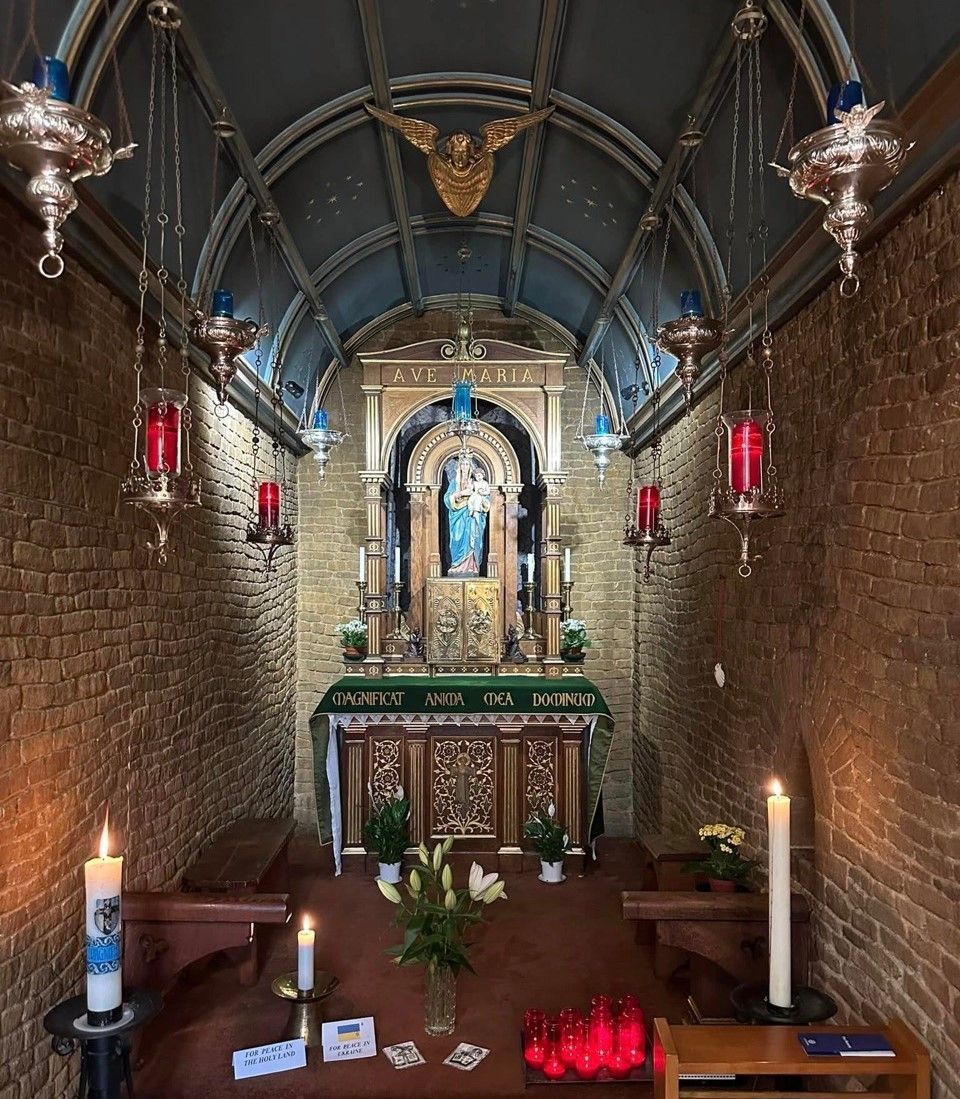
Interactive map of the Catholic Shrines of England & Wales
Details of the Shrines by Diocese
Arundel & Brighton: Our Lady of Consolation
 SHRINE WEBSITE
SHRINE WEBSITEA Diocesan Shrine in the care of the Diocese
The Priest’s House, Park Lane, West Grinstead, Horsham, West Sussex RH13 8LT
Catholic worship was kept alive at West Grinstead after the Reformation by the local Caryll family. The priests’ house, next door to the shrine, contains a chapel in an upper room believed to have been used throughout the centuries of Catholic repression. One such priest was the Franciscan Arthur (aka Francis) Bell, (13 January 1590 – 11 December 1643) who is believed to have lived and worked at West Grinstead. He was found guilty of being a Catholic priest by a court during the English Civil War and was executed by being hanged, drawn and quartered at Tyburn in London. Bell was beatified by Pope John Paul II on 22 November 1987.
There was a shrine in honour of Our Lady at West Grinstead before the Reformation. The Church is impressive for such a rural area and was opened in 1876. The tower was completed in the 1960s as a memorial to the Catholic writer Hilaire Belloc, who is buried here. Our Lady of Consolation is one of the earliest names for Mary and dates from the 2nd century. In the 18th century the custom of asking for the final blessing before death in the name of Our Lady of Consolation was popular. Before you leave the Shrine, you could reflect on where your own life needs healing and consolation.
Shrine prayer
O God, who through the Virgin Mary has willed to give to your people the true consolation, Jesus Christ;
grant to us who venerate her, under the title of Our Lady of Consolation, the grace to co-operate with her in the work of Redemption,
we ask this through Christ Our Lord.
Amen.
Our Lady of Consolation of West Grinstead, Have pity on us.
St Francis of Assisi, Pray for us.
Blessed Francis Bell, Pray for us.
WALKING PILGRIMAGE TO THE SHRINE
The Way of Our Lady of Consolation ends at the Shrine. More details here.
Birmingham: Harvington Hall
 SHRINE WEBSITE
SHRINE WEBSITEA Diocesan Shrine in the care of the Archdiocese.
Harvington Hall Lane, Harvington, Kidderminster, DY10 4LR
Harvington Hall, the seat of the Pakington and Yates families, was a centre for Catholic life in the area during the C16 and C17. The house contained two ‘secret’ chapels and is famous for its unequalled collection of priest holes, probably constructed by St Nicholas Owen. St John Wall (martyred 1679) ministered in the area for twelve years. In 1743 a chapel was constructed in a stable block in the grounds and used until 1823, when it was badly damaged by fire. It later became a school, but in 1986-7 was restored as a chapel.
Today the Hall is owned by the Archdiocese and there is an annual pilgrimage and Mass on the first Sunday of September. The Hall is open to the public.
Shrine prayer
Almighty God, we remember with gratitude and reverence the sacrifice of the English Martyrs who, in their fidelity to the Catholic Faith, endured persecution and death for the sake of Christ. Inspired by their courage and unwavering commitment, we humbly ask for their intercession in our lives.
Grant us the strength to remain steadfast in our faith, even in the face of challenges and adversity. May the example of the English Martyrs inspire us to live our Catholic Faith boldly and joyfully, bearing witness to the Gospel in our time. May their prayers bring comfort, healing, and strength to all who seek their help.
O God, who crowned the English Martyrs with the glory of martyrdom, grant that we may imitate their courage and fidelity. Through their intercession, may we grow in love for You and our neighbours, and may Your Kingdom come in our hearts and in the world.
We ask this through Christ our Lord.
Amen.
St Nicholas Owen, Pray for us
St John Wall, Pray for us
WALKING PILGRIMAGE TO THE SHRINE
The closest diocesan Pilgrim Way is the St Chad's Way, more details here.
Birmingham: Our Lady of Caversham
SHRINE WEBSITEA Diocesan Shrine in the care of the Archdiocese
The Church of Our Lady & St Anne, 2 South View Avenue, Caversham, Reading RG4 5AB
The origins of the Shrine of Our Lady in Caversham are a mystery. By the Norman Conquest there was a shrine chapel beside the River Thames, containing a statue of Our Blessed Lady, and pilgrims came there to pray. On 14th September 1538, Henry VIII's agents arrived at Caversham and, in a single day, closed down the Shrine, The statue was sent to Thomas Cromwell in London where it was burnt.
The revival of devotion to Our Lady of Caversham began in 1897, the year following the foundation of the Parish of Our Lady and St. Anne. In the Marian Year of 1954 a stone chapel was built, and a large oak statue of Our Lady and Child was purchased This statue shows Mary nursing the infant Christ.
The renewed Shrine of Our Lady of Caversham was blessed and dedicated by Archbishop Francis Grimshaw of Birmingham in 1958. To complete the link with the Medieval shrine, in 1996, and to celebrate the centenary of the parish, a gold and silver crown was made for the statue, and blessed by Pope John Paul II during a parish pilgrimage to Rome. The statue was crowned by the Papal Nuncio, Archbishop Barbarito, on 20th July 1996.
The Shrine was renovated in 2017 and a mural reflecting the history of the Shrine was pained on the rear wall. Today groups and individuals come regularly to pray to Our Blessed Mother at her Shrine.
Shrine prayer
All holy Mother of God, who in the ages of faith did receive in this holy place the veneration of our fathers.
Pray for us that we may grow in God's grace, and may be led to the knowledge and love of your Divine Son who, with the Father and the Holy Spirit, lives and reigns, world without end.
Amen.
Our Lady of Caversham, Pray for us.
WALKING PILGRIMAGE TO THE SHRINE
Caversham is near the St James Way. More details here.
Birmingham: Our Lady of Lourdes
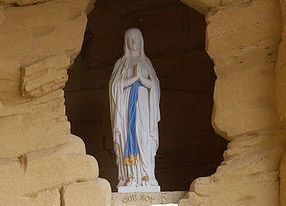 SHRINE WEBSITE
SHRINE WEBSITEA Diocesan Shrine in the care of Archdiocese of Birmingham.
Catholic Church, Uxbridge Street, Hednesford, Staffordshire WS12 1DB
Each year on the first Sunday of July the church holds a pilgrimage in honour of Our Lady of Lourdes. The church is an ambitious and self-confident Gothic design by G. B. Cox, erected between the wars as a replica of the Marian shrine at Lourdes. Next to the church is a Lourdes grotto, formed at about the same time.
A prayer to Our Lady of Lourdes
Oh ever immaculate Virgin, Mother of Mercy, Health of the Sick, Refuge of Sinners, Comfortess of the Afflicted, you know my wants, my troubles, my sufferings. Look upon me with mercy.
When you appeared in the grotto of Lourdes, you made it a privileged sanctuary where you dispense your favors, and where many sufferers have obtained the cure of their infirmities, both spiritual and corporal. I come, therefore, with unbounded confidence to implore your maternal intercession.
My loving Mother, obtain my request. I will try to imitate your virtues so that I may one day share your company and bless you in eternity.
Amen.
Our Lady of Lourdes, Pray for us.
WALKING PILGRIMAGE TO THE SHRINE
The nearest walking pilgrimage route is the Two Saints Way. More details here.
Brentwood: Our Lady of Light
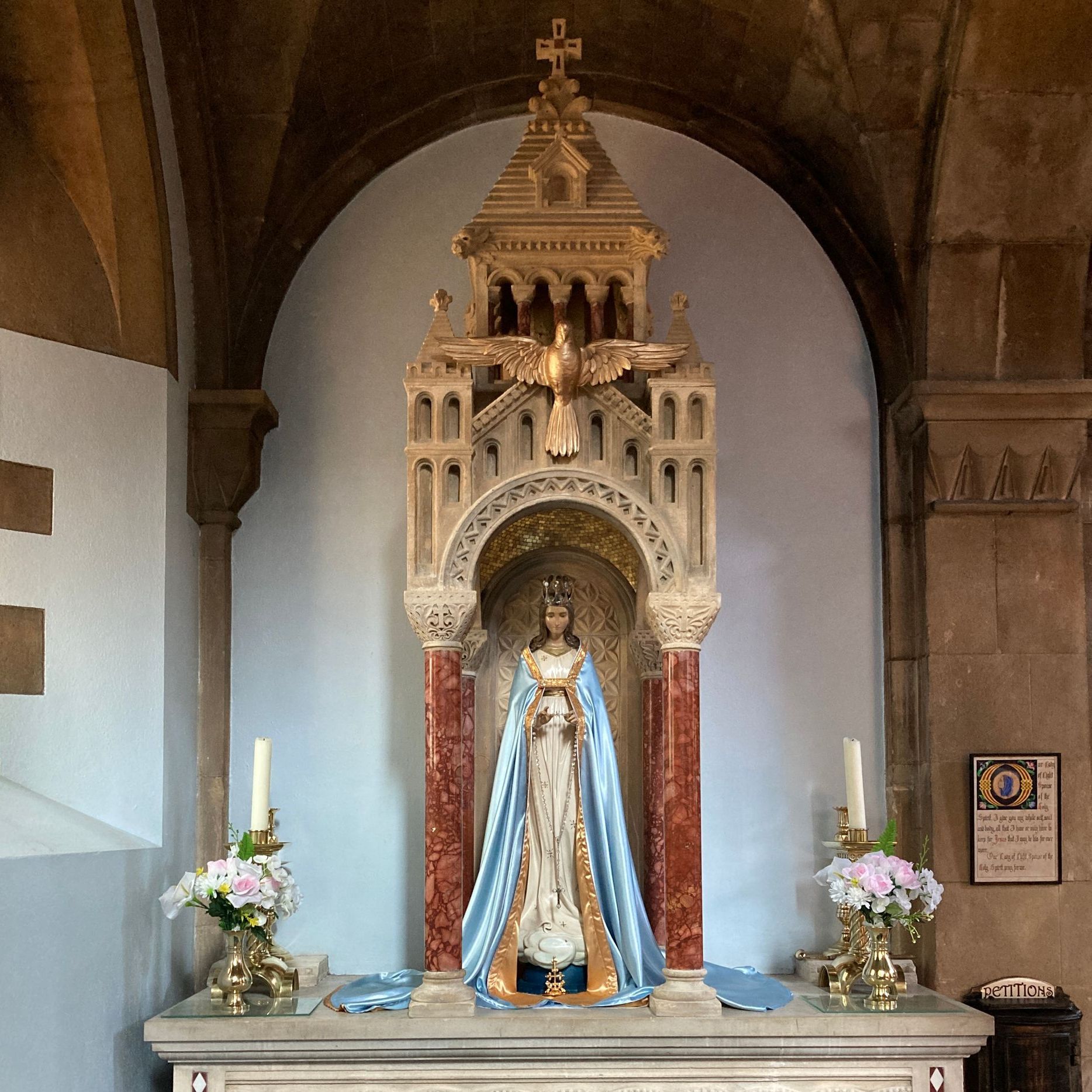 SHRINE WEBSITE
SHRINE WEBSITEA national Shrine in the care of Diocese
1 Church Road, Clacton-on-Sea, Essex CO15 6AG
The English Shrine of Our Lady of Light was founded in Cornwall in 1834, by Miss Ann Letitia Trelawny and her sister Mrs Mary Harding, in accordance with the wish of their father, Sir Henry Trelawny. Sir Henry had been an Anglican clergyman, but he was received into the Catholic Church, and in 1830, at the age of seventy-four, was ordained priest. Sir Henry and his daughters had lived in Brittany and knew of shrines dedicated to Our Lady of Light which were popular with pilgrims suffering from blindness and troubles of the sight, whether physical or spiritual. After their father’s death his daughters built of a chapel on the Trelawne estate dedicated to Our Lady of Light to bring Cornwall to the light of Faith that they had received. The chapel opened in 1843. The estate was renamed Sclerder, the word in Breton and Cornish for light.
The Catholic Trelawnys died out and the estate was bought by the de Bary family. Mrs Pauline de Bary restored the chapel and brought a carved wooden statue of Our Lady depicting her with her hands palms downwards before her, as though bestowing blessings on her children. A golden dove hovers above her, symbol of the Holy Spirit. She asked permission for an Association to be formed and this was granted in 1893. However there were problems in Cornwall, and Mrs de Bary and Mrs St John decided to move the shrine. Cardinal Vaughan suggested Clacton-on-Sea, where there was a need for a mission. The town had grown as a seaside resort from the mid C19, and Mass was said in a variety of locations.
A mission was established in 1894 and Mrs de Bary and Mrs St John acquired the site for a church. In 1895 the Oblates of St Charles at Bayswater were invited to take over the running of the shrine, and Cardinal Vaughan undertook to erect the Confraternity of Our Lady of Light there.
In 1902 work started on a large church in Norman style, dedicated to Our Lady of Light and St Osyth, the Saxon abbess of a nearby convent. Various additions and re-orderings have taken place over the years, and the Church was finally consecrated by Bishop McMahon on 15 October 2004, 101 years to the day after its official opening.
Shrine prayer
Our Lady of Light, Spouse of the Holy Spirit, I give thee my whole self, soul and body, all that I have or may have, to keep for Jesus, that I may be His for evermore.
Amen.
Our Lady of Light, Pray for us.
WALKING PILGRIMAGE TO THE SHRINE
The Way of Our Lady of Light ends at the Shrine. More details here.
Brentwood: The Chapel of St Peter-on-the-Wall
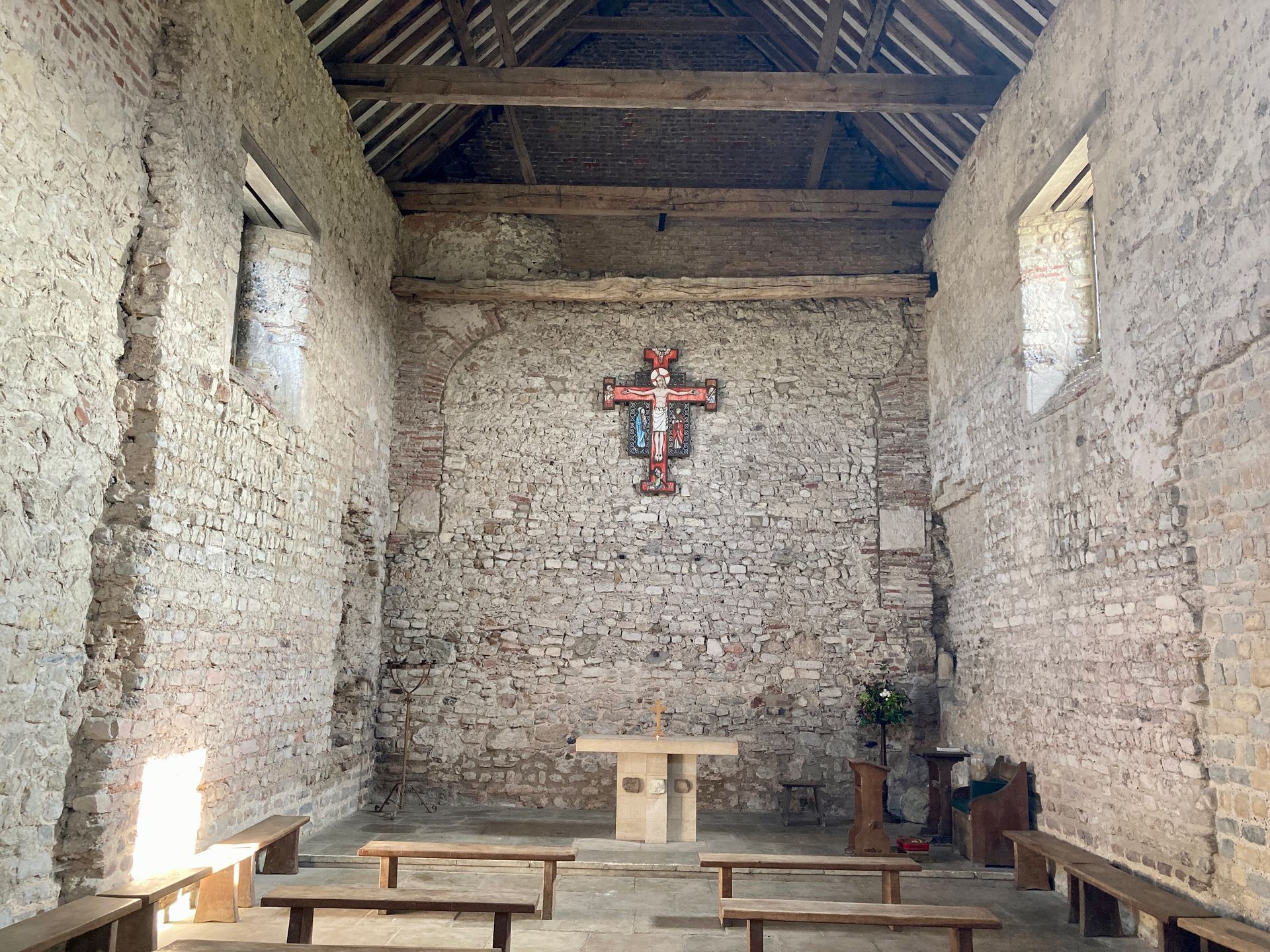 SHRINE WEBSITE
SHRINE WEBSITEAn Informal Shrine in the care of the Church of England.
St Peter's-on-the Wall East End Road, Bradwell-on-Sea, Essex CM0 7PN
The Chapel is one of the oldest largely intact churches in England. In 653 Cedd travelled south from Lindisfarne to spread Christianity amongst the East Saxons, and, having been ordained as a bishop, returned the next year to build the chapel, amid the ruins of the abandoned Roman fort of Othona. In 1442, local clergy reported to the Bishop of London that it had been expanded slightly, with a small tower above the porch with a bell in it. It was repaired and returned to regular use alongside the parish church in Bradwell-on-Sea until the Reformation after which it was used as a barn.
In 1920 it was restored and reconsecrated as an Anglican church of the Diocese of Chelmsford and part of the parish of St Thomas, Bradwell-on-Sea. Regular services are held, especially in the summer. It is open every day of the year and can only be reached on foot, the nearest car park being 850m away.
The Chapel and adjacent field are the home of the ecumenical Bradwell Pilgrimage, held on the first Saturday in July. The procession starts at the Parish Church of St Thomas and the pilgrims walk to the Chapel, where services and events are held. The Pilgrimage is supported by many Christian communities including the Othona Community, the Salvation Army, the Religious Society of Friends, the Catholic Diocese of Brentwood, the Anglican Diocese of Chelmsford, the United Reformed Church and the Eastern Baptist Association.
Shrine prayer
O Almighty God, who willed to be glorified in thy Saints and raised up your servants Cedd and the Saints of Essex to shine as lights in the world.
Shine we pray, in our hearts, that we also in our generation may show forth thy praises, who has called us out of darkness into thy marvelous light; through Jesus.
Amen
St Peter, Pray for us.
St Cedd, Pray for us.
WALKING PILGRIMAGE TO THE SHRINE
The St Peter's Way ends at the Shrine. More details here.
Cardiff-Menevia: Divine Mercy
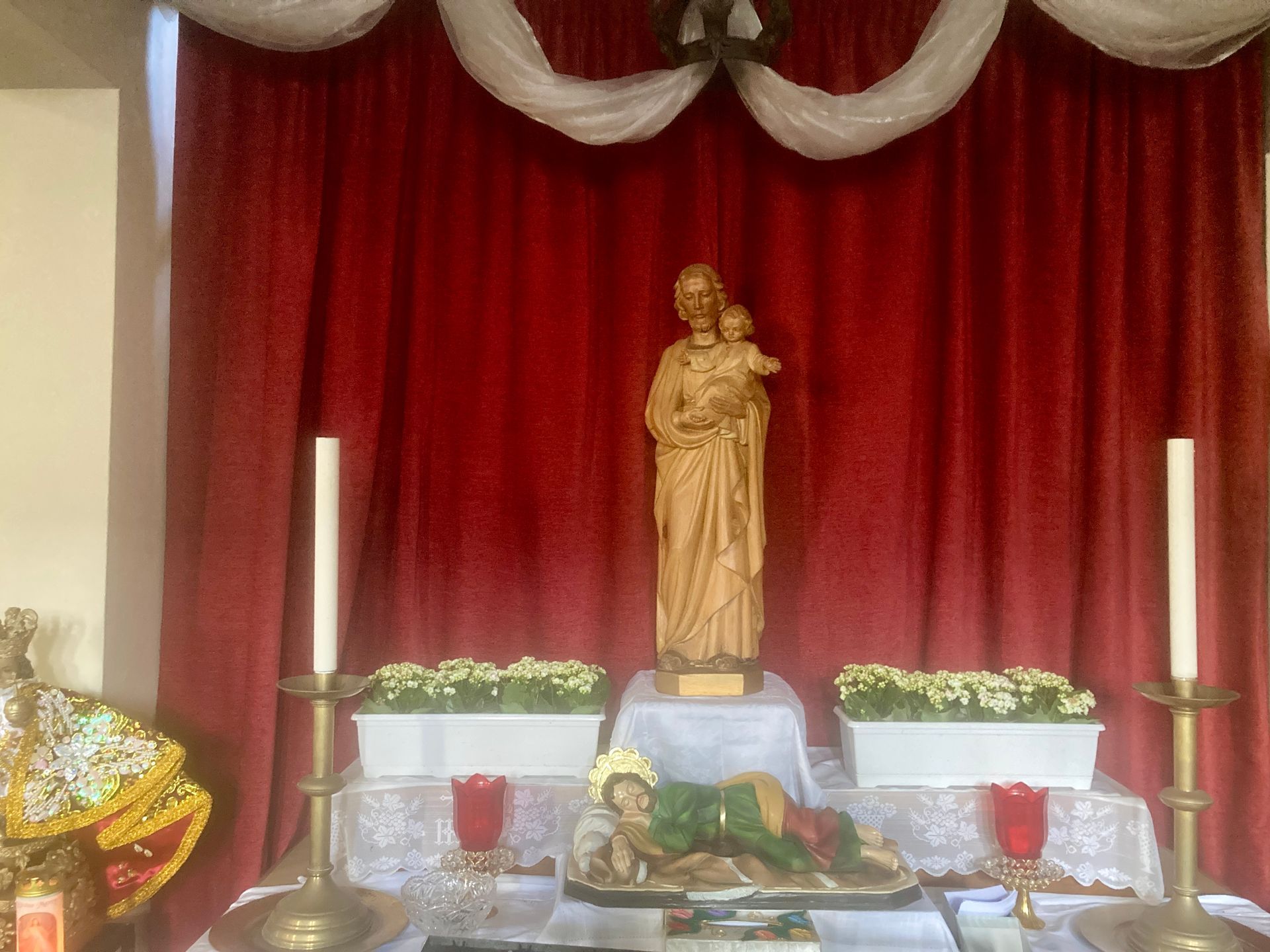 SHRINE WEBSITE
SHRINE WEBSITEA Diocesan Shrine in the care of the Archdiocese.
The Church of the Sacred Heart, School Road Morriston SA6 6HZ
In 1899 the Benedictines purchased a former Baptist chapel in Morriston. Morriston became an independent parish in 1922, administered by the Benedictines until 1932, when the parish was handed to the Diocese of Cardiff. The old, corrugated iron church was destroyed by fire on Holy Saturday 1952. A building fund was set up and a new church was opened on 14 April 1955. During the late 1950s and early 60s new residential estates in the parish meant more space was needed. The building was re-orientated, and the enlarged church was opened in 1964. In 2017 the church was inaugurated as a diocesan shrine of Divine Mercy, and new stained-glass windows were installed in the nave.
In 1931, in Płock, Poland, Faustina Kowalska, a religious sister and mystic, had a vision of Jesus who tasked her with spreading devotion to his Divine Mercy. The two main themes of the devotion are to trust in Christ's endless goodness, and to show mercy to others, acting as a conduit for God's love towards them. The feast of Divine Mercy was instituted by St Pope John Paul II in 2000 and is celebrated on the Sunday after Easter.
Shrine prayer
O God, whose mercies are without number and whose treasure of goodness is infinite, graciously increase the faith of the people consecrated to you, that all may grasp and rightly understand by whose love they have been created, through whose Blood they have been redeemed, and by whose Spirit they have been reborn.
Through Christ our Lord.
Amen.
St Anthony of Egypt, Pray for us.
WALKING PILGRIMAGE TO THE SHRINE
The Shrine is on the Way of St Anthony's Well. More details here.
Cardiff-Menevia: Our Lady of Lourdes
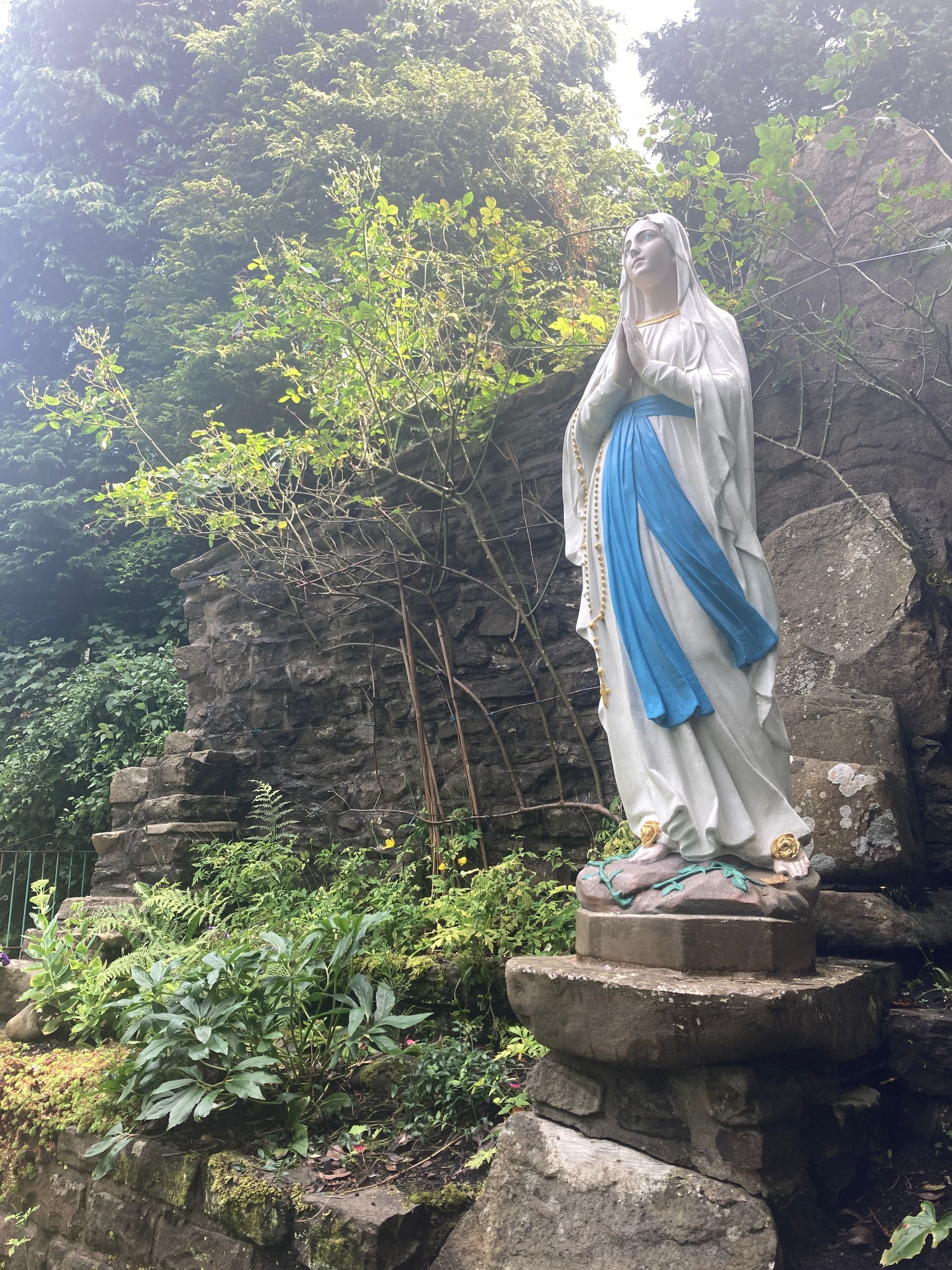 SHRINE WEBSITE
SHRINE WEBSITEAn Informal Shrine in the care of Archdiocese
St Thomas' Church, Cardiff Road, Abercynon CF45 4RR
In 1926 a 3-year-old local boy called Gerald O’Shea fell into the River Taff. On returning home he told his mother that he had been rescued by a lady in blue, the same lady that was shown on his religious medallion. The boy stuck firmly to his story and the tale of the Virgin Mary rescuing a boy from drowning began to spread.
It was the Great Depression and a time of mass local unemployment. The parish priest Fr Carroll-Baillie organised a group of volunteers, including many unemployed miners, to build a Lourdes grotto and shrine at the rear of the site, overlooking the confluence of the Rivers Cynon and Taff. Three local wells were diverted into one and were dedicated as a Holy Well. Following stories of cures and blessings the site became a popular place of pilgrimage, known as ‘the Welsh Lourdes’.
At the peak of its popularity around 10,000 pilgrims a year visited but in later decades the grotto fell into disrepair. Following a fundraising campaign launched in 2011 it is once again restored.
Shrine prayer
Oh ever immaculate Virgin, Mother of Mercy, Health of the Sick, Refuge of Sinners, Comfortess of the Afflicted, you know my wants, my troubles, my sufferings. Look upon me with mercy.
When you appeared in the grotto of Lourdes, you made it a privileged sanctuary where you dispense your favors, and where many sufferers have obtained the cure of their infirmities, both spiritual and corporal. I come, therefore, with unbounded confidence to implore your maternal intercession.
My loving Mother, obtain my request. I will try to imitate your virtues so that I may one day share your company and bless you in eternity.
Amen.
Our Lady of Lourdes, Pray for us.
WALKING PILGRIMAGE TO THE SHRINE
The Way of Our Lady of the Valleys ends at the Shrine. More details here.
Cardiff-Menevia: Our Lady of Penrhys
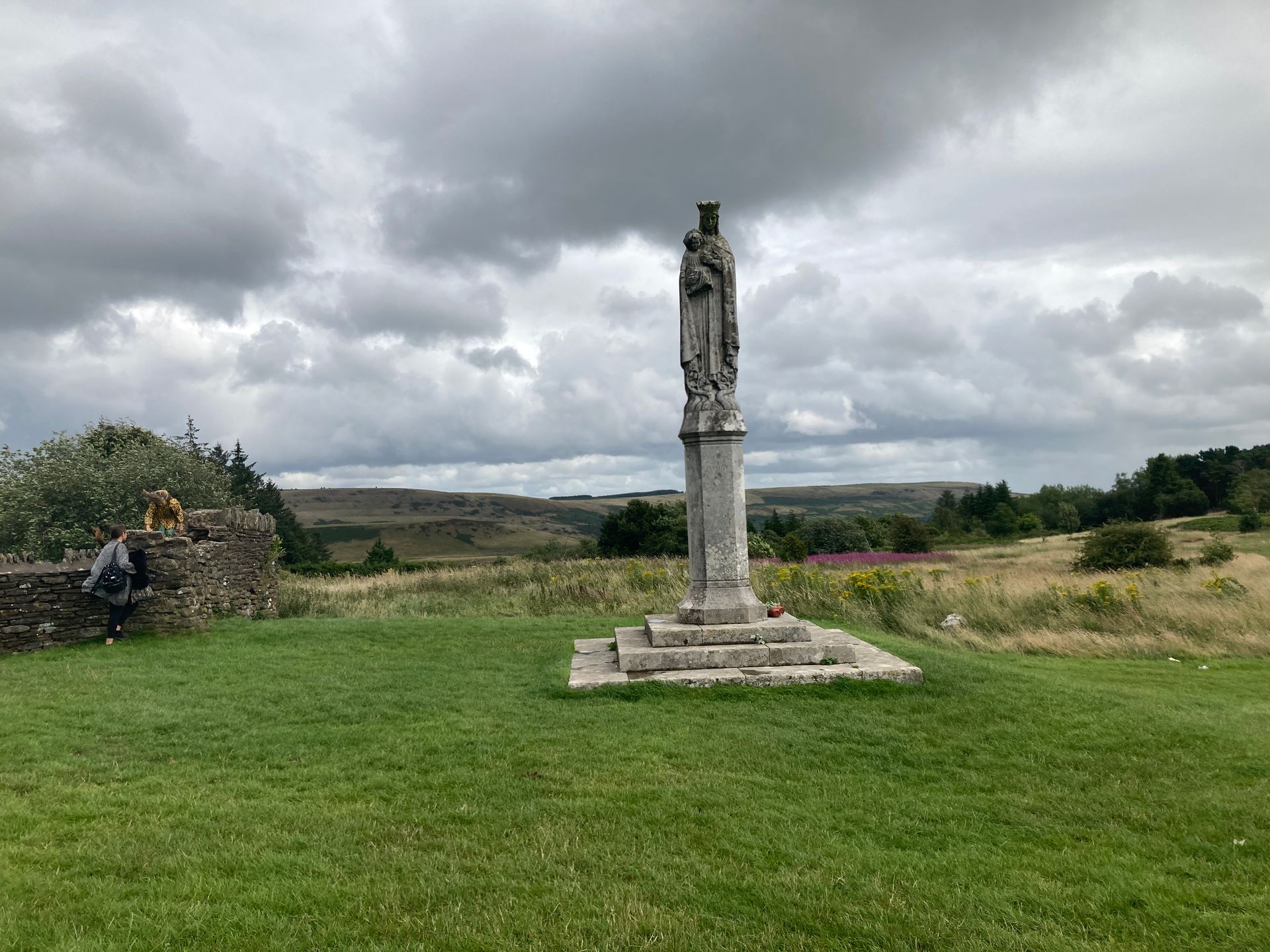 PILGRIM HANDBOOK
PILGRIM HANDBOOKAn Informal Shrine in the care of Rhondda Borough Council
Penrhys Rd, Tylorstown, Ferndale, Rhondda, South Wales CF43 3PT
By the C15, the most popular pilgrimage site in south-east Wales was Penrhys where a statue of the Virgin Mary is said to have appeared in the branches of an oak tree near a holy well called Ffynnon Mair (St Mary’s Well). The Shrine chapel was in the care of the Cistercian Abbey of Llantarnam, which benefited from pilgrim offerings. Stone crosses marked the pilgrim route to the Shine and several Welsh poets composed works praising the Virgin and her Shrine at Penrhys.
By 1538 the Shrine was so popular that Thomas Cromwell ordered that the statue be secretly removed, taken to London and burned with the statues of Our Lady of Walsingham and Our Lady of Ipswich. Although the practice of pilgrimage was banned after the Reformation, the footpaths between Cardiff and Penrhys survived, as did the holy well.
In 1953, the Catholic Archdiocese of Cardiff installed a new statue of Mary on the site of the Cistercian chapel carved from Portland stone. Pilgrimages and open-air Masses are held. The ecumenical Penrhys Pilgrimage Way has done much to revive interest in the shrine.
A pilgrim handbook has been produced by the Cardiff Oratory, which can be downloaded below.
Shrine prayer
O Lord our God,
Who were pleased to bring joy to the world through the Incarnation of Your Son:
grant that we who honour His Mother, the cause of our joy, may always walk in the way of Your commandments with our hearts set on true and lasting joy.
All-holy Father, eternal God, in Your goodness You prepared a royal throne for Your Wisdom in the womb of the Blessed Virgin Mary;
bathe Your Church in the radiance of Your life-giving Word, that, pressing forward on its pilgrim way in the light of Your truth, we may come to the joy of a perfect knowledge of Your love.
Through our Lord Jesus Christ, your Son, who lives and reigns with you in the unity of the Holy Spirit, God, for ever and ever.
Amen
Our Lady of Penrhys, Pray for us.
WALKING PILGRIMAGE TO THE SHRINE
The Shrine is on the route of the Way of Our Lady of the Valleys. More details here.
Cardiff-Menevia: Our Lady of the Taper
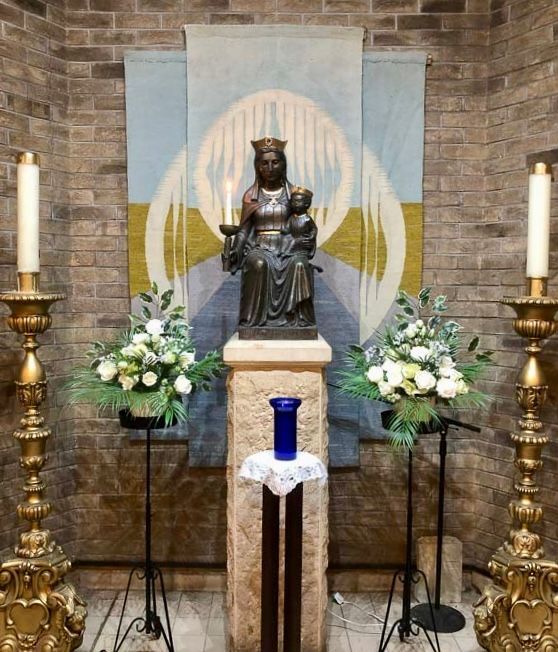 SHRINE WEBSITE
SHRINE WEBSITEA Welsh National Shrine in the care of Archdiocese
North Rd, Cardigan, Wales. SA43 1LT
During the middle ages there was a pilgrimage in honour of Our Lady in Cardigan. A legend describes how a statue of Mary was found by the side of the river Teifi, “and her sonne upon her lappe, and the taper bernynge in her hande”. It was taken to the parish church but would not remain there, returning three or four times to “the place where now is buyIded the church of our Lady”, the present St. Mary’s church. St. Mary’s dates from 1158. Outside town, on the old pilgrim track, lie the ruins of a building by a stream. It is called Capel Bach (Little Chapel), and may have been an oratory where travellers prayed before walking the last mile to the shrine. St. Mary’s was a priory church of Chertsey Abbey.
Benedictine monks cared for it until 1538, when they were expelled and the shrine destroyed. In 1904 Breton monks, in exile near Cardigan, revived the devotion, giving the title Our Lady of Cardigan to their abbey church and also to the little church they opened in town in 1912. They left in 1916, and another generation passed before the name was heard again.
In 1952 Martin Gillett, who later was to found the Ecumenical Society of the Blessed Virgin Mary, told Bishop Petit that Cardigan had once possessed a famous shrine. The Bishop decided to restore it. In 1956 a new statue was blessed by Cardinal Griffin in Westminster Cathedral and then taken to every parish in the diocese of Menevia before arriving in Cardigan. On 27 May 1956, a great concourse from all parts of Britain bore it to the little church of Our Lady of Sorrows.
On 23 July 1970 Bishops Petit and Fox consecrated the new church of Our Lady of the Taper, named after the shrine. Three days later pilgrims transferred the statue there. The original statue did not prove durable, and Mother Concordia, O.S.B., was asked to make another one in bronze. It was blessed in Cardiff Metropolitan Cathedral and brought all over Wales before, on Pentecost Sunday, 18 May 1986, it was solemnly installed in the presence of 4,500 pilgrims. Its beauty catches the imagination and arouses devotion. St Pope John Paul II wrote a message for the occasion, and a taper he blessed in Rome was placed in the hand of the statue and lit.
Shrine prayer
My soul glorifies the Lord,
Henceforth all ages will call me Blessed.
The Almighty works marvels for me:
Holy His name.
Behold the handmaid of the Lord.
Be it done unto me according to your word.
Father, Your Son Jesus born of the Virgin Mary by the power of the Holy Spirit is the Light of the world. May the same Spirit lead us to imitate Mary’s faith love and humility, that, guided by her example, we may follow the light of her Son on our Journey through life and come at last to see you as you are, and praise you in the everlasting kingdom of heaven.
Amen
Holy Mary Mother of God, you offer your Son for our adoration
May we too treasure His word in our hearts and help bring His light to the world.
Our Lady of Cardigan Pray for Wales
Our Lady of Cardigan Pray for us
WALKING PILGRIMAGE TO THE SHRINE
Cardigan is on the Teifi River Pilgrimage. More details here.
Cardiff-Menevia: St Anthony's Well
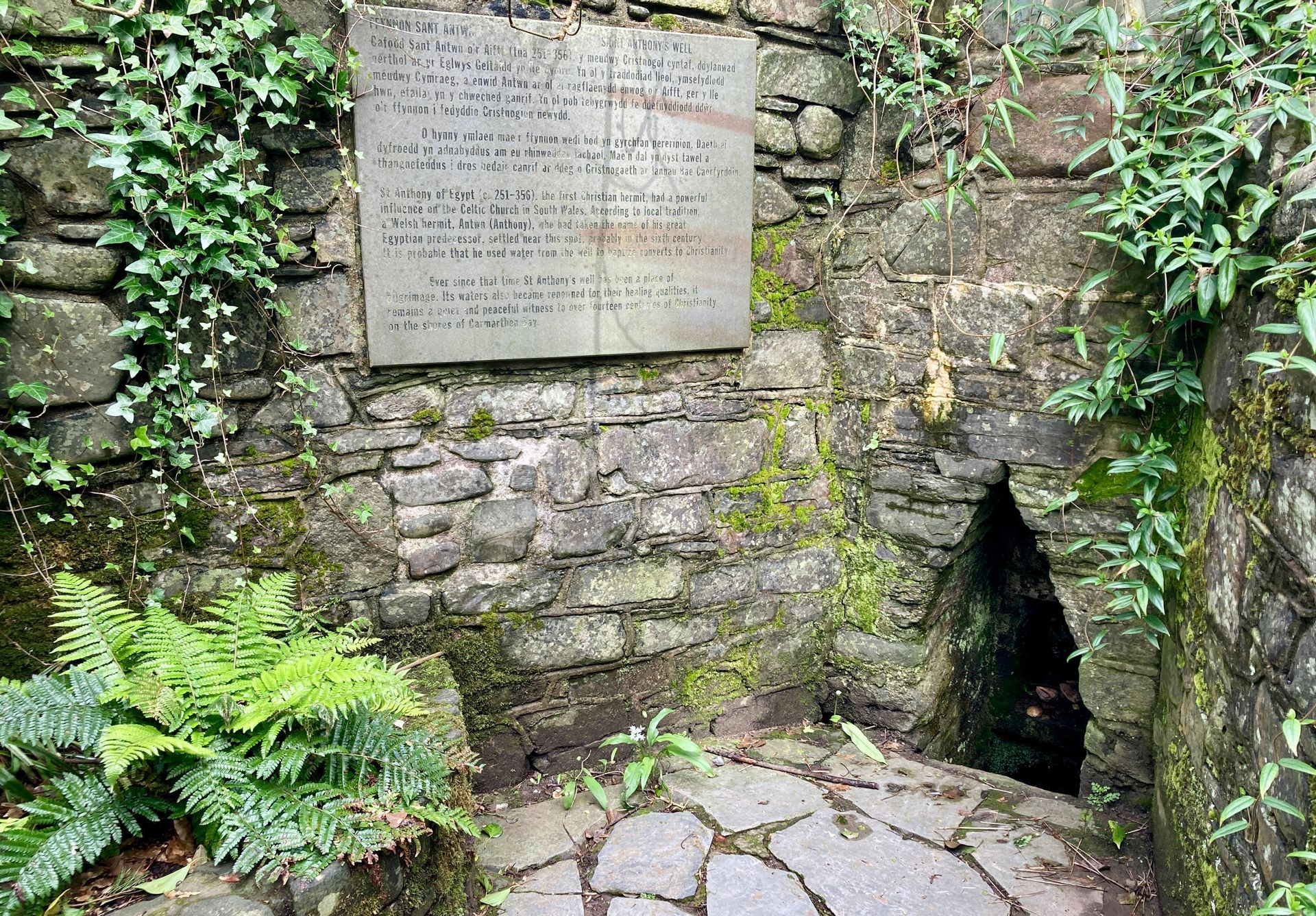 MORE INFORMATION
MORE INFORMATIONAn Informal Shrine in private ownership
Located within a modern walled enclosure on the West side of a narrow access lane leading to St Anthony's Cottage. St Anthony's Cottage address: Llansteffan Carmarthenshire SA33 5JX
The stone plaque alongside the arched opening reads: ‘St Anthony of Egypt (c 251 - 356), the first Christian hermit, had a powerful influence on the Celtic Church in South Wales. According to local tradition a Welsh hermit, Antwn (Anthony), who had taken the name of his great Egyptian predecessor, settled near this spot, probably in the C6. It is probable that he used water from the well to baptize converts to Christianity. Ever since that time St Anthony's well has been a place of pilgrimage. Its waters also became renowned for their healing qualities. It remains a quiet and peaceful witness to over fourteen centuries of Christianity on the shores of Carmarthen Bay.’
It is possible that a hermitage once existed where St Anthony's Cottage stands. Holy wells were a source of water for baptism, but they evolved a secondary function as pilgrim waypoints.
In 1123, Pope Callixtus II recognised the Shrine of St David as a place of pilgrimage. Pilgrims used the holy wells across South Wales as a route to reach St David's, and Sant Antwn's may have been one of these.
Shrine prayer
God our Father,
You gave St Anthony of Egypt the courage and belief of an apostle to give up his wealth, living a life of poverty and solitude,
and to found monasteries.
Help us to be zealous in imitating his virtues
and to follow in the footsteps of Our Lord Jesus Christ.
Grant this through the same Christ Our Lord who lives and reigns with You and the Holy Spirit,
one God, for ever and ever.
Amen.
St Anthony of Egypt, Pray for us.
WALKING PILGRIMAGE TO THE SHRINE
The Way of St Anthony's Well ends at the
God oShrine. More details here.
Cardiff-Menevia: St David Lewis
SHRINE WEBSITEA Diocesan Shrine in the care of Archdiocese
St David Lewis & St Francis Xavier Church, 26 Porthycarne Street, Usk NP15 1RZ
A new shrine was dedicated to the martyr Saint David Lewis at the church of SS David Lewis & Francis Xavier, in Usk, Wales in 2019. David Lewis was born in Abergavenny in 1616. He was brought up as a Protestant but later became a Catholic. Both his parents died in 1638 and that same year, David set off for Rome. He entered the Venerable English College on 6th. November 1638 to prepare for ordination to the priesthood. He assumed the name of Charles Baker (A common practice in those days of persecution). He was ordained on 20th July 1642.
Fr David Lewis entered the Jesuit Novitiate at Sant’ Andrea in Rome on 19th April 1645. After Profession, his superiors sent him to Wales. He was recalled to Rome after only a short stay, to take up the role of Spiritual Director at his old College. This lasted one year, as the Mission in South Wales, which had been founded in 1620, petitioned for Father David’s return to his homeland. Fr David was sent back to Wales, to the Jesuit Mission of St. Francis Xavier at a place called ‘The Cwm’ in 1648, where he was to work for the next thirty years.
On Sunday 17th November 1678 he was arrested at Llantarnam as he was preparing to say Mass. At his trial, he was condemned as a Roman Catholic Priest who said Mass, which was considered high treason against the Crown. For this, he was executed at Usk on Wednesday 27th August 1679. He is bured in the graveyard of St Mary's Church, Usk.
David Lewis was canonised in 1970 by Pope Paul VI.
Shrine prayer
Lord, we thank you for the gift of St David Lewis Saint & Martyr.
He was faithful to Christ even to accepting Martyrdom.
Increase our own faith, strengthen our fidelity to you and to the church which you founded upon Peter, and grant us the courage to follow St David’s example of love, and the grace of conversion for all who seek the Truth.
We make our prayer through Christ our Lord,
Amen.
St David Lewis, Pray for us.
St Francis Xavier, Pray for us.
The website of the Friends of St David Lewis can be found here. The website includes details of his last words.
Clifton: Our Lady of Glastonbury
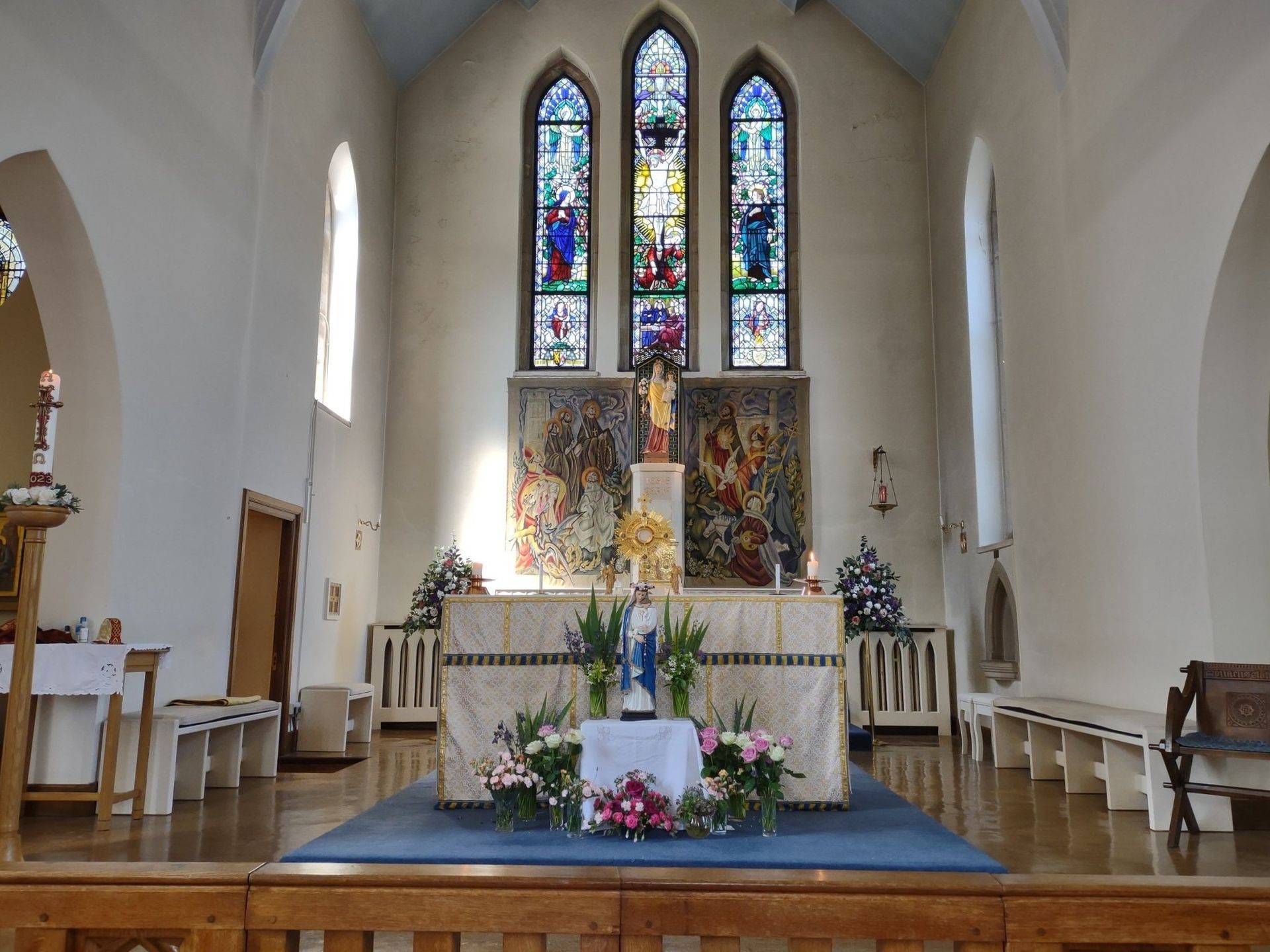 SHRINE WEBSITE
SHRINE WEBSITEA Diocesan Shrine in the care of Diocese
St Mary's Church, Magdalene Street, Glastonbury, Somerset BA6 9EJ
There is evidence that Our Lady continued to be venerated at Glastonbury during penal times, but in 1925, a small church was built. In 1939 the foundations of a new church were laid, dedicated to Our Lady and across the road from the ruined Abbey.
In 1955, a statue of Our Lady was blessed by the Apostolic Delegate, and the Shrine of Our Lady St Mary of Glastonbury was restored. In 1965 the statue was crowned, a mark of the special importance of Our Lady of Glastonbury. Today the shrine is well visited and there is the Annual Diocesan Pilgrimage.
Shrine prayer
Hail, Holy Queen, Mother of Mercy,
our life, our sweetness and our hope.
To you do we cry,
poor banished children of Eve.
To you do we send up our sighs,
mourning and weeping in this valley of tears
Turn then, most gracious advocate,
your eyes of mercy toward us,
and after this exile show unto us the blessed fruit of thy womb, Jesus.
O clement, O loving, O sweet Virgin Mary,
Pray for us, O Holy Mother of God, that we may be made worthy of the promises of Christ.
Amen
Our Lady of Glastonbury, Pray for us.
WALKING PILGRIMAGE TO THE SHRINE
The Whiting Way ends at the Shrine. More details here.
East Anglia: National Shrine of Our Lady
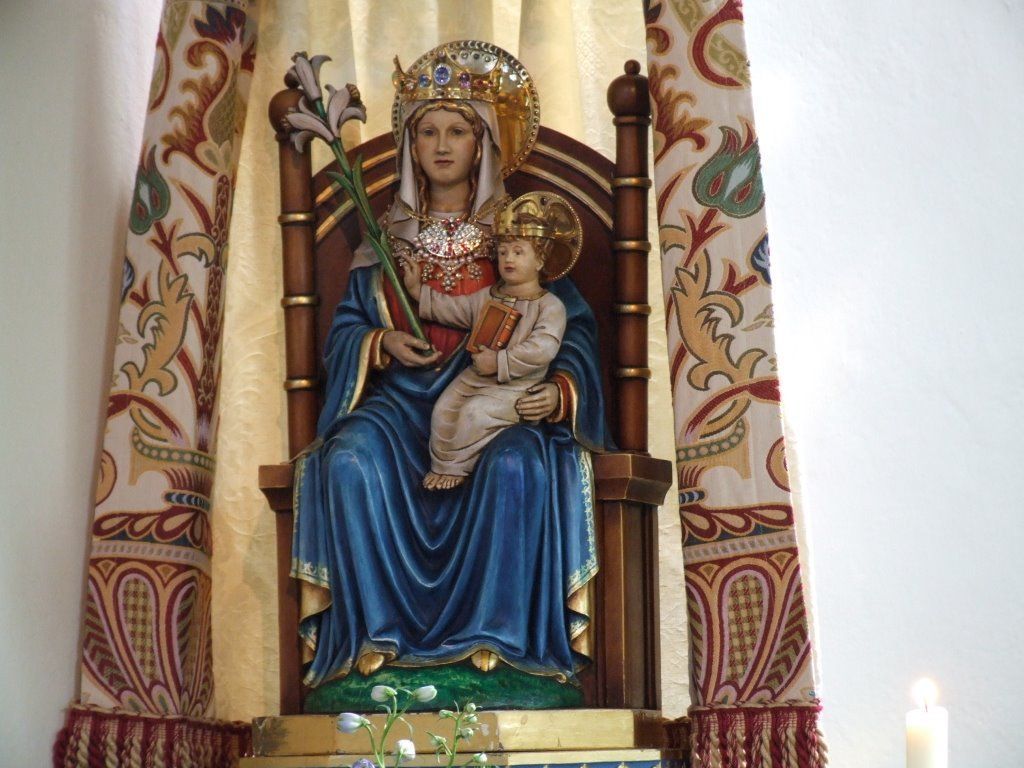 SHRINE WEBSITE
SHRINE WEBSITEA National Shrine in the care of Diocese
The Chapel of Reconciliation, Houghton St Giles, Walsingham, Norfolk NR22 6AL
The Slipper Chapel was built in the mid C14 to serve pilgrims approaching the end of their journey to the Shrine of Our Lady of Walsingham. Traditionally pilgrims would take off their footwear and walk the last mile barefoot. In 1511 Henry VIII and Catherine of Aragon, did so, but at the Reformation Henry had the shrine destroyed.
The Slipper Chapel became successively a poor house, a forge, a barn and a cowshed. In 1896 Miss Charlotte Boyd, a Catholic convert, bought and restored the Chapel. She had the idea of reviving the chapel as a place of pilgrimage and the Guild of Our Lady of Ransom brought the first public pilgrimage to Walsingham on 20th August 1897.
As the years passed devotion to Our Lady at Walsingham grew and the number of pilgrimages increased. In 1933, prompted by the growth of the Anglican shrine at Walsingham, Cardinal Bourne created a new Shrine to Our Lady at the Slipper Chapel. In 1934 the Cardinal led 12,000 people on a pilgrimage to the chapel, re-enthroning an image of Our Lady which had been designed from a late medieval priory seal. In the same year the bishops of England & Wales declared the Chapel a National Shrine to Our Lady.
After WW2 there were increasing numbers of pilgrims to the Shrine, so Mass was often said in the open air beside the Slipper Chapel. In the late 1960s the Diocese of Northampton began to improve the facilities and work began on a large open-sided structure on a concrete dais, with a granite altar and timber roof, providing a more permanent covered outdoor sanctuary.
In the 1970s it was decided to construct a large chapel over the dais in the shape of a Norfolk barn, seating 350 with a sanctuary which could be opened in summertime for larger outside congregations. Building began in 1980 and the completed building was consecrated in May 1982. From 1968 to 2014 the shrine was run by priests of the Society of Mary (Marists). In 2015 Pope Francis conferred the title of minor basilica on the Shrine, one of only three in England.
The Shrine attracts some 150,000 pilgrims annually with about 35 major pilgrimages. The largest are those of the Tamil community who bring about 6,000 pilgrims each May and July, some being Christian and some Hindus.
Shrine prayer
Hail, Mary, full of grace, the Lord is with thee.
Blessed art thou amongst women
and blessed is the fruit of thy womb, Jesus.
Holy Mary, Mother of God, pray for us sinners, now and at the hour of our death.
Amen.
Our Lady of Walsingham, Pray for us.
WALKING PILGRIMAGE TO THE SHRINE
The Shrine is on the Way of the Annunciation. More details here.
East Anglia: Pontifical Shrine of Our Lady of Walsingham
 SHRINE WEBSITE
SHRINE WEBSITEA Pontifical Shrine in the care of the Diocese
The Church of Our Lady of the Annunciation London Road, King's Lynn, PE30 5HQ
A Gothic Revival design church of 1897 incorporating elements from an earlier (1845) church on the same site by A.W.N. Pugin. The Pontifical Shrine of Our Lady of Walsingham was established here in 1897. It remains the official shrine of Our Lady of Walsingham.
In 1934 the Shrine at the Slipper Chapel at Houghton St Giles was established as the National Shrine to Our Lady. The pilgrimages which had been made to Kings Lynn transferred there, but the Shrine to Our Lady of Walsingham remained in Kings Lynn.
Shrine prayer
O Mary, recall the solemn moment when Jesus, your divine son, dying on the cross, confided us to your maternal care.
You are our mother, we desire ever to remain your devout children.
Let us therefore feel the effects of your powerful intercession with Jesus Christ.
Make your name again glorious in the shrine once renowned throughout England by your visits, favours, and many miracles.
Pray, O holy mother of God, for the conversion of England, restoration of the sick, consolation for the afflicted, repentance of sinners, peace to the departed.
O blessed Mary, Mother of God, our Lady of Walsingham, Pray for us.
Amen.
WALKING PILGRIMAGE TO THE SHRINE
A pilgrim way from Kings Lynn to Walsingham is under development. More details here.
East Anglia: St Ethelreda
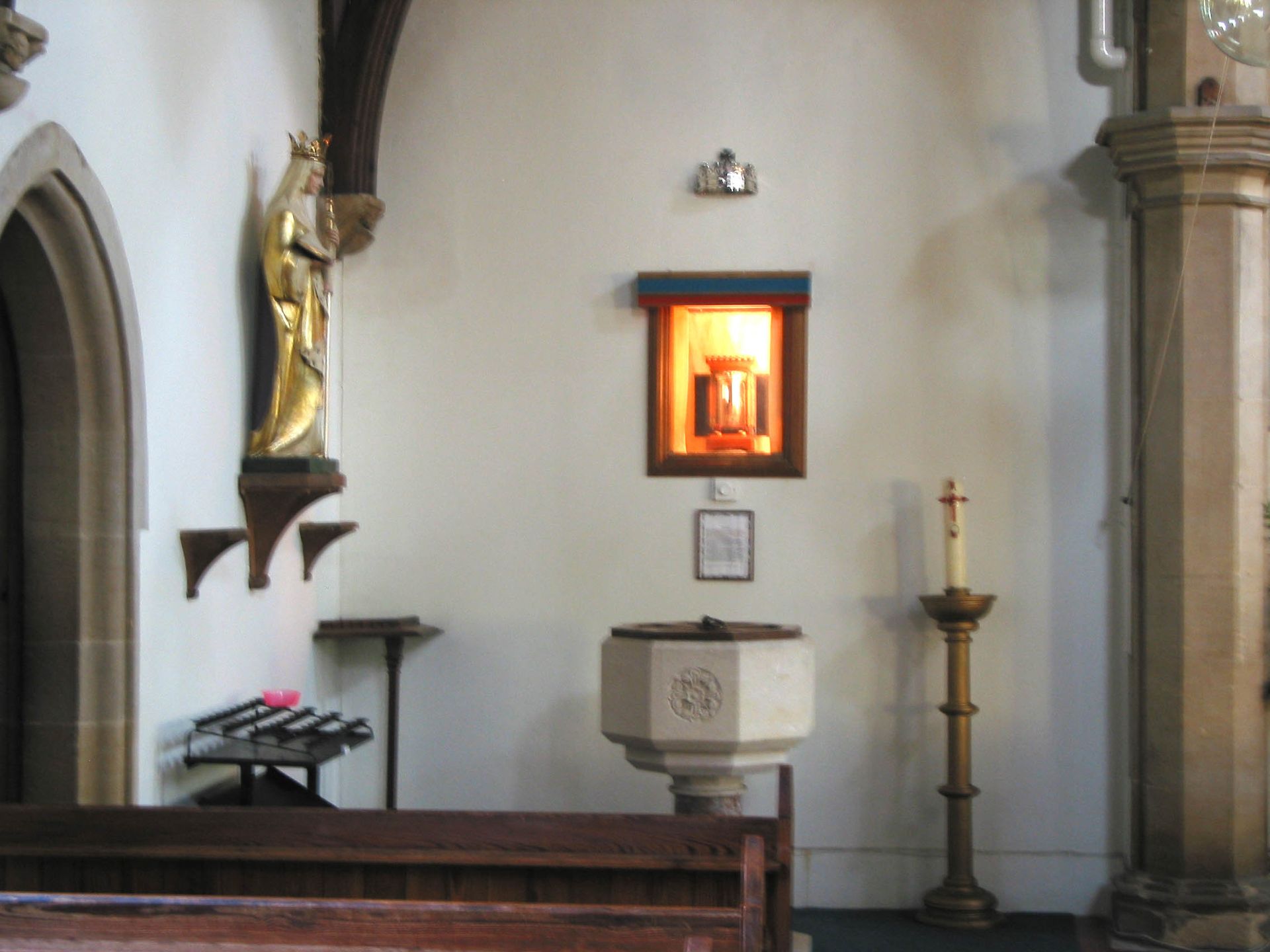 SHRINE WEBSITE
SHRINE WEBSITEA Diocesan Shrine in the care of the Diocese
The Church of St Ethelreda, 19 Egremont St, Ely CB6 1AE
At the Reformation the shrine of St. Etheldreda was destroyed and the cult ended. Fragments of the shrine are thought to have survived in various locations around the town of Ely. The exact date of the destruction of the medieval shrine cannot be pinpointed with accuracy, but it probably took place following Thomas Goodrich’s instruction to the clergy of Ely diocese on 21 October 1541, commanding that “all images, relicks, table monuments of miracles and shrines” should be demolished and obliterated. Reference to the actual destruction of the shrine was made by Dr. John Caius as he records his surprise at finding that it was built out of stone, not marble, as might have been expected. Nevertheless, official records show that some 361 ounces of gold and 5040 ounces of gold and white plate were looted from the shrine into the royal treasury.
The modern relic of Saint Etheldreda, consisting of her left hand, was found preserved in a separate reliquary, hidden in a priest’s hiding hole in a house in Sussex in about 1811. It was presented to the Duke of Norfolk and passed down to the community of Dominican Sisters at Stone. The hand was found on an engraved silver plate on which was written ‘Manus Sanctae Etheldredae DCLXXIII.’ The plate itself was of a tenth-century style, suggesting that the hand had been separated from the rest of St. Etheldreda’s body at around the time of the tenth century.
It was reported in 1876 that when the hand was found it was “perfectly entire and quite white (but) exposure to the air has now changed it to a dark brown and the skin has cracked and disappeared in several places”. A small part of the hand of St. Etheldreda was returned to the parish in 1950, given from St Etheldreda’s Church in Ely Place, London where it had been honoured. But the main relic had remained with the Dominican sisters at Stone and they donated it to the parish in June 1953, where it has remained ever since.
The modern day shrine is a relatively simple construction, displaying St. Etheldreda’s hand in a glass reliquary. Until the late 1960s there was a small altar dedicated to St. Etheldreda, immediately in front of where the relics are displayed, but the liturgical changes which followed the Second Vatican Council led to the altar being removed, to be replaced by the parish font in 1975, which was moved from the back of the church where it had previously been.
Modern Pilgrims continue to visit the shrine of St. Etheldreda often combining it with a visit to Ely Cathedral, where the medieval shrine was located before the Reformation.
Shrine prayer
Eternal God, who bestowed such grace upon your servant Etheldreda that she gave herself wholly to the life of prayer
and to the service of your true religion:
grant that we, like her, may so live our lives on earth seeking your kingdom that by your guiding we may be joined to the glorious fellowship of your saints;
through Jesus Christ your Son our Lord,
who is alive and reigns with you,
in the unity of the Holy Spirit
one God now and for ever.
Amen.
St Ethelreda, Pray for us.
WALKING PILGRIMAGE TO THE SHRINE
Ely is the start of the Ely to Wheeting Pilgrim Way to Walsingham. More details here.
Hallam: Our Lady of Doncaster
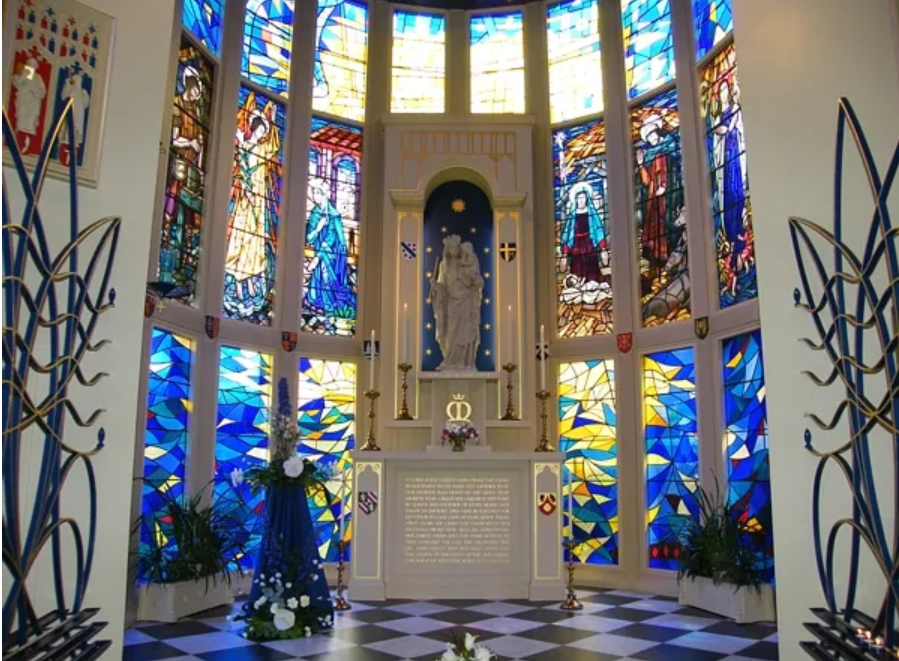 SHRINE WEBSITE
SHRINE WEBSITEA Diocesan Shrine in the care of Diocese
Church of St Peter-in-Chains, Chequer Road, Doncaster DN1 2AA
Our Lady of Doncaster is a Marian shrine located in Doncaster, South Yorkshire. The original statue in the Carmelite friary was destroyed during the English Reformation. A modern shrine was erected in St Peter-in-Chains Church, Doncaster in 1973. The feast day of Our Lady of Doncaster is 4 June.
Shrine prayer
Hail, Holy Queen, Mother of Mercy,
our life, our sweetness and our hope.
To you do we cry,
poor banished children of Eve.
To you do we send up our sighs,
mourning and weeping in this valley of tears
Turn then, most gracious advocate,
your eyes of mercy toward us,
and after this exile show unto us the blessed fruit of thy womb, Jesus.
O clement, O loving, O sweet Virgin Mary, Pray for us, O holy Mother of God, that we may be made worthy of the promises of Christ.
Our Lady of Doncaster, pray for us.
WALKING PILGRIMAGE TO THE SHRINE
There are as yet no nearby pilgrim ways.
Hallam: The Padley Martyrs
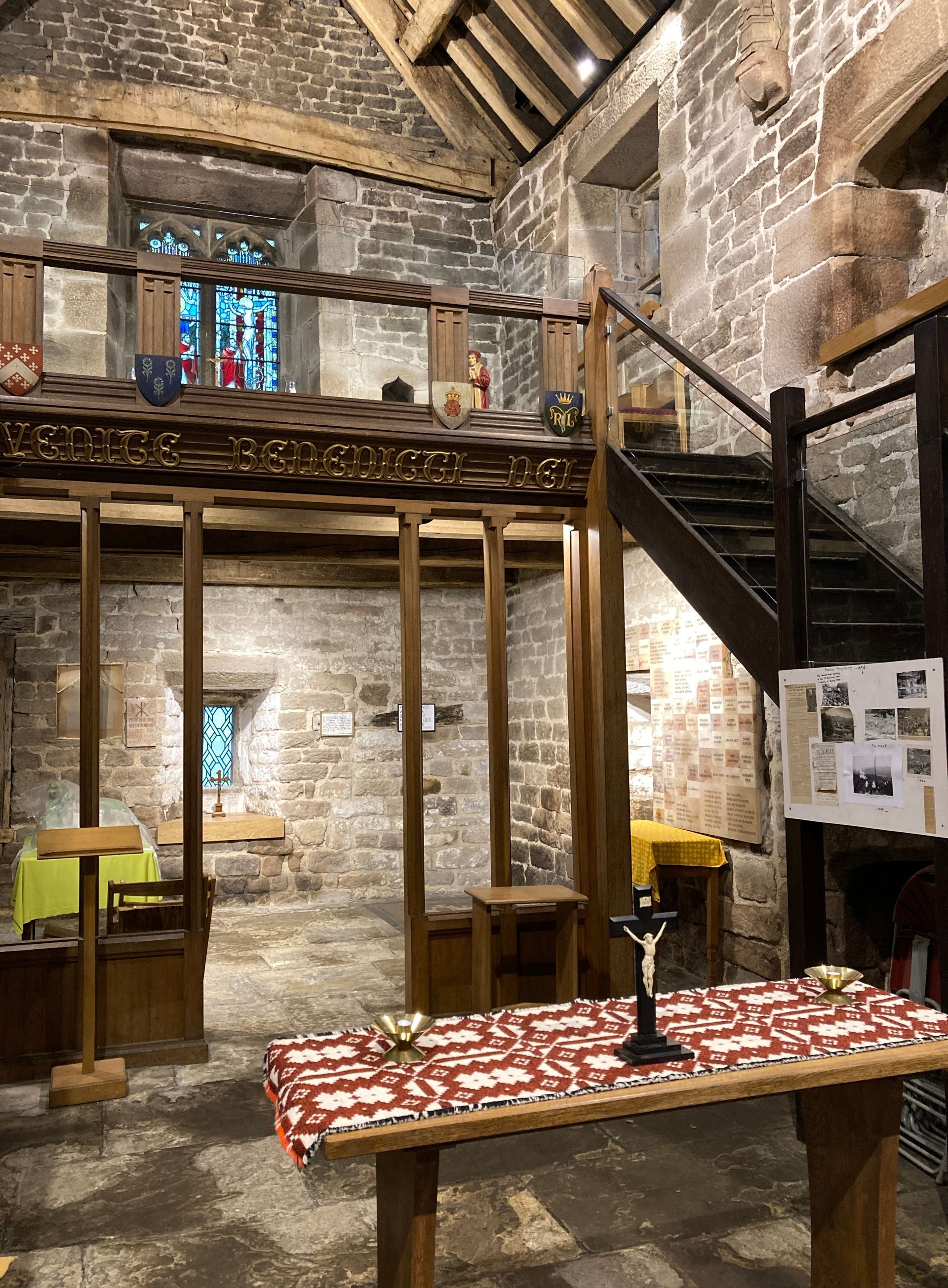 SHRINE WEBSITE
SHRINE WEBSITEA Diocesan Shrine in the care of Diocese
Midland Cottages, Upper Padley, Grindleford, Hope Valley, Derbyshire S32 2JA
It is thought that Padley Hall has Anglo-Saxon origins but was wholly or partially rebuilt in the early C15. The estate passed by marriage to the recusant Fitzherbert family and in 1588, while in the ownership of John Fitzherbert, the house was raided by the Earl of Shrewsbury supported by Richard Topcliffe, a notorious priest hunter and torturer.
Frs. Nicholas Garlick and Robert Ludlum were arrested on the charge of being Catholic priests. They were taken to Derby and executed there in July 1588. John Fitzherbert was imprisoned until his death in 1590.
The house passed through various hands, and was mostly pulled down in the late 1650s, although the entrance range was retained as a farmhouse and then adapted for agricultural purposes in the 18th Century.
It may be that the chapel in the upper floor remained in use for clandestine religious services, but there is no direct evidence for this. In 1898 annual pilgrimages were started by local clergy with the support of the Guild of Our Lady of Ransom, in honour of the martyred priests. After 1894 a local rail service helped to popularise the pilgrimage.
The site was bought by the Diocese of Nottingham in 1933 and during excavations an altar slab was discovered and repositioned within the building. The first Mass held within it in July 1933. The Chapel is now owned by the Diocese of Hallam and annual pilgrimages continue from the Dioceses of Hallam and Nottingham with outdoor Masses celebrated amongst the ruins of the Hall. The Chapel is generally closed but if you wish to visit more information can be found on the Hallam Diocesan website.
Shrine prayer
O God, in whom there is no change or shadow of alteration, you gave courage to the Holy Martyrs.
Grant unto us, we beseech you, through their intercession, the grace to always value the Holy Mass. May we be strengthened to serve you in imitation of the courage of these Holy Martyrs.
We ask this through Jesus Christ, Your Son, who lives and reigns with You in the unity of the Holy Spirit, forever.
Amen
All martyrs of Padley, Pray for us.
WALKING PILGRIMAGE TO THE SHRINE
The Padley Martyrs Way ends at the Shrine. More details here.
Hexham & Newcastle: Our Lady's Chapel, Jesmond
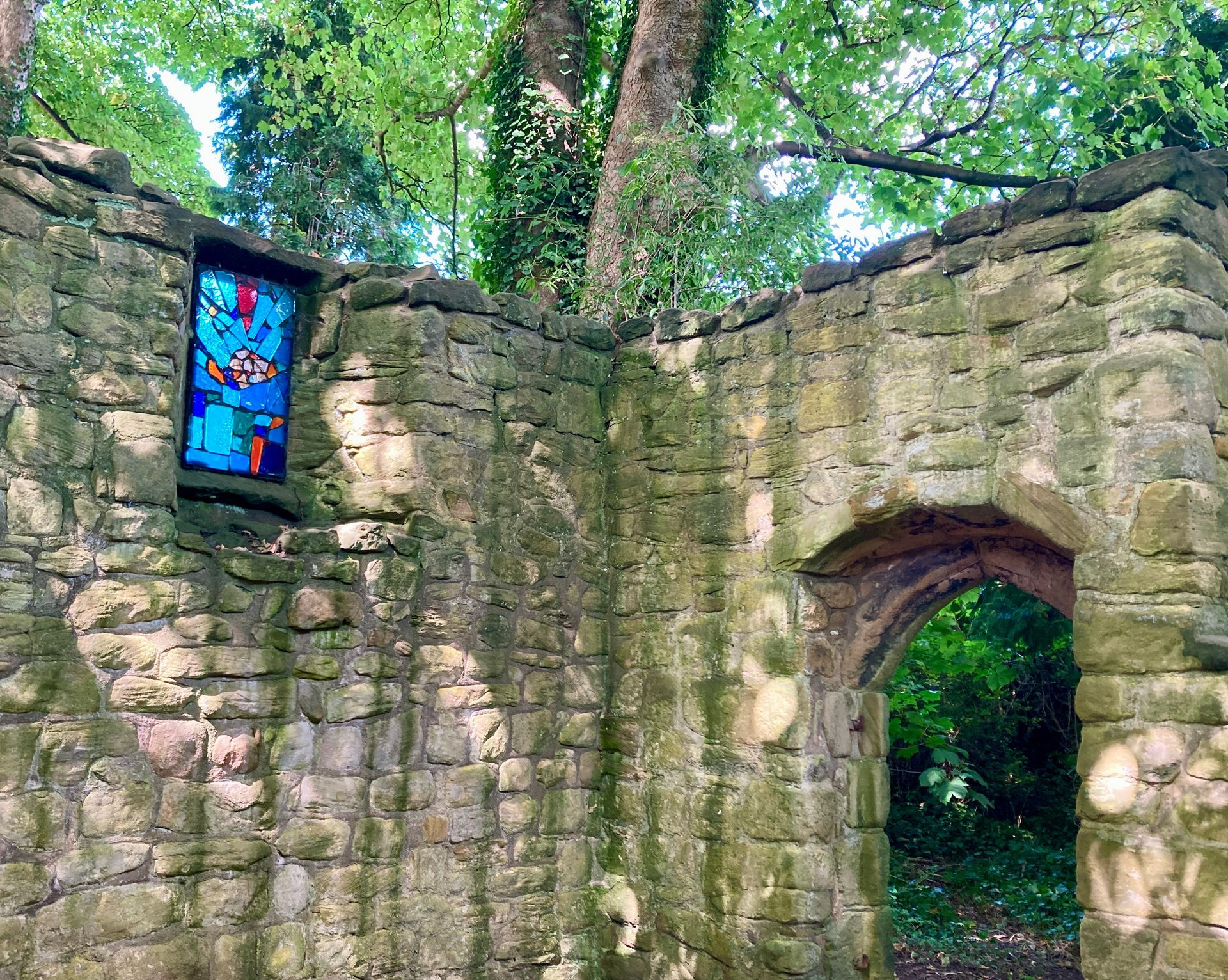 MORE INFORMATION
MORE INFORMATIONAn Informal Shrine in the care of the City of Newcastle upon Tyne
61 Reid Park Rd, Jesmond, Newcastle upon Tyne NE2 2ER
The remains of the Chapel of Our Lady of Jesmond or St. Mary's Chapel is the oldest church or chapel in Newcastle. It was probably built by the Grenville family, one-time Lords of Jesmond. The chapel is first mentioned in 1272 in an Assize Roll which records how five clerics helped a criminal escape from Newcastle Gaol - first to Jesmond Chapel and then to sanctuary at Tynemouth.
Although the chapel was at one time in the possession of the Priors of Tynemouth, division of the manor between three sisters in 1333 led to confusion as to rights over the chapel and, at one time, three separate Chantries were maintained by their descendants. This resulted in much scandal and damage, including stolen jewellery and chalices and in 1364, Edward III took claim.
In 1549 the Mayor and Burgesses of Newcastle paid £144.13.4d to Edward VI to purchase the chapel and adjoining Hospice and in turn sold them to Sir Robert Brandling.
The Chapel has been a place of pilgrimage for centuries because of the miracles reputed to have taken place among the sick who attended the Chapel and the neighbouring Holy Well. Pilgrim street, in the centre of Newcastle, probably derives its name from being the route the pilgrims took on their journey to the Chapel.
Following the Reformation and dissolution of the monasteries, the building thought to have been a hospital was rebuilt as a house, and the Chapel became a barn and stable; it passed through several hands until bought by Lord Armstrong who gifted it to the City.
Today there is an organised pilgrimage to the Chapel every year when a service is held in the ruins.
Shrine prayer
Hail, Holy Queen, Mother of Mercy,
our life, our sweetness and our hope.
To you do we cry, poor banished children of Eve.
To you do we send up our sighs, mourning and weeping in this valley of tears
Turn then, most gracious advocate,
your eyes of mercy toward us,
and after this exile show unto us the blessed fruit of thy womb, Jesus.
O clement, O loving, O sweet Virgin Mary. Pray for us, O holy Mother of God, that we may be made worthy of the promises of Christ,
Amen.
WALKING PILGRIMAGE TO THE SHRINE
The Shrine is on the Holystone Way. More details here.
Hexham & Newcastle: The Lady's Well, Holystone
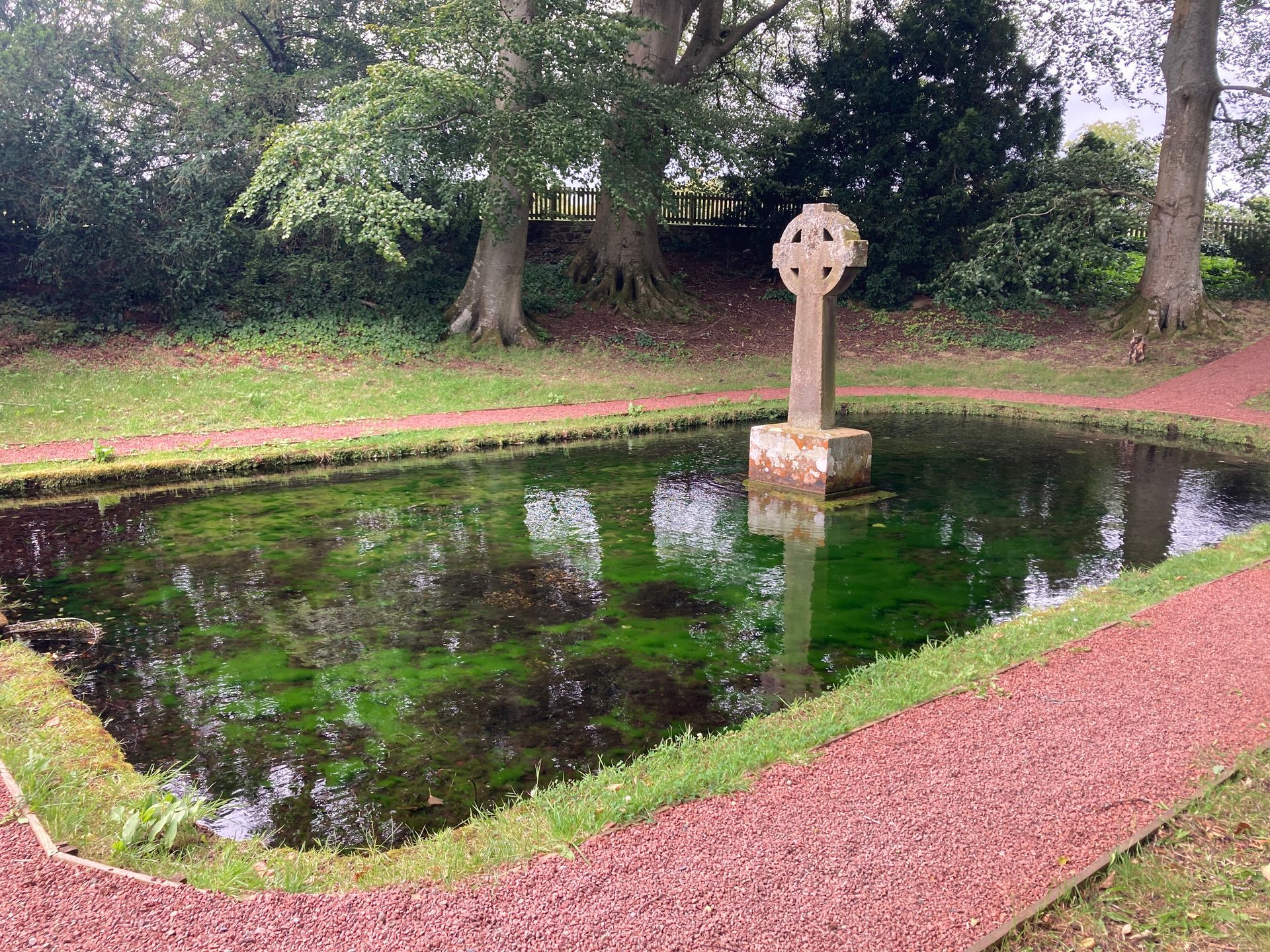 MORE INFORMATION
MORE INFORMATIONAn Informal Shrine in the care of the National Trust
Harbottle, Warburth, Northumberland NE65 7AJ
The well was once a watering place beside the Roman road from Bremenium in Redesdale to the coast. It was probably the Romans who built a low stone wall around a spring's outflow to create a rectangular pool.
The C5 St Ninian, known as the Apostle to the Southern Picts, is said to have baptised many early Christians in its water. Bede recorded the tradition that Ninian was a Briton who had studied in Rome, established an episcopal see at the Candida Casa in Whithorn, Galloway, named after Saint Martin of Tours, and that he is buried at Whithorn. St Paulinus (d. 644) is said to have baptised over 3000 Northumbrians in Lady's Well during Easter week of AD 627. He is said to have knelt on a flat stone now known as the Holy Stone, from which the village takes its name.
In medieval times the well was dedicated to the Virgin Mary and in the early C12 a community of Augustinian canonesses settled in Holystone. Their Priory was immediately to the south of the current church. It was destroyed at the Reformation, but the well survived.
A stone cross was placed in the centre of the pool during the C19, and a statue of St Paulinus was brought from Alnwick. The spring was the source of the village’s water supply until 1998.
Today the Lady’s Well is in the care of the National Trust and is a wonderful place for quiet reflection and prayer. There are many pilgrims and occasionally Mass is celebrated.
Shrine prayer
Saint Ninian, first to preach the Good News of Christ in our land, hear our prayers and present them to the Lord, whom you served so faithfully.
Gain for us a new outpouring of the Holy Spirit, abundant vocations to the priesthood and religious life, deeper faith in God’s merciful love, stronger love for God and for our neighbour, a renewal of Christian life in our nation.
May we imitate your fidelity to the call of Christ and your passion to share the truth He brought us, and also be found worthy to share the heavenly reward.
Amen.
St Ninian, Pray for us.
WALKING PILGRIMAGE TO THE SHRINE
The Shrine is on the Holystone Way. More details here.
Lancaster: Our Lady of Fernyhalgh
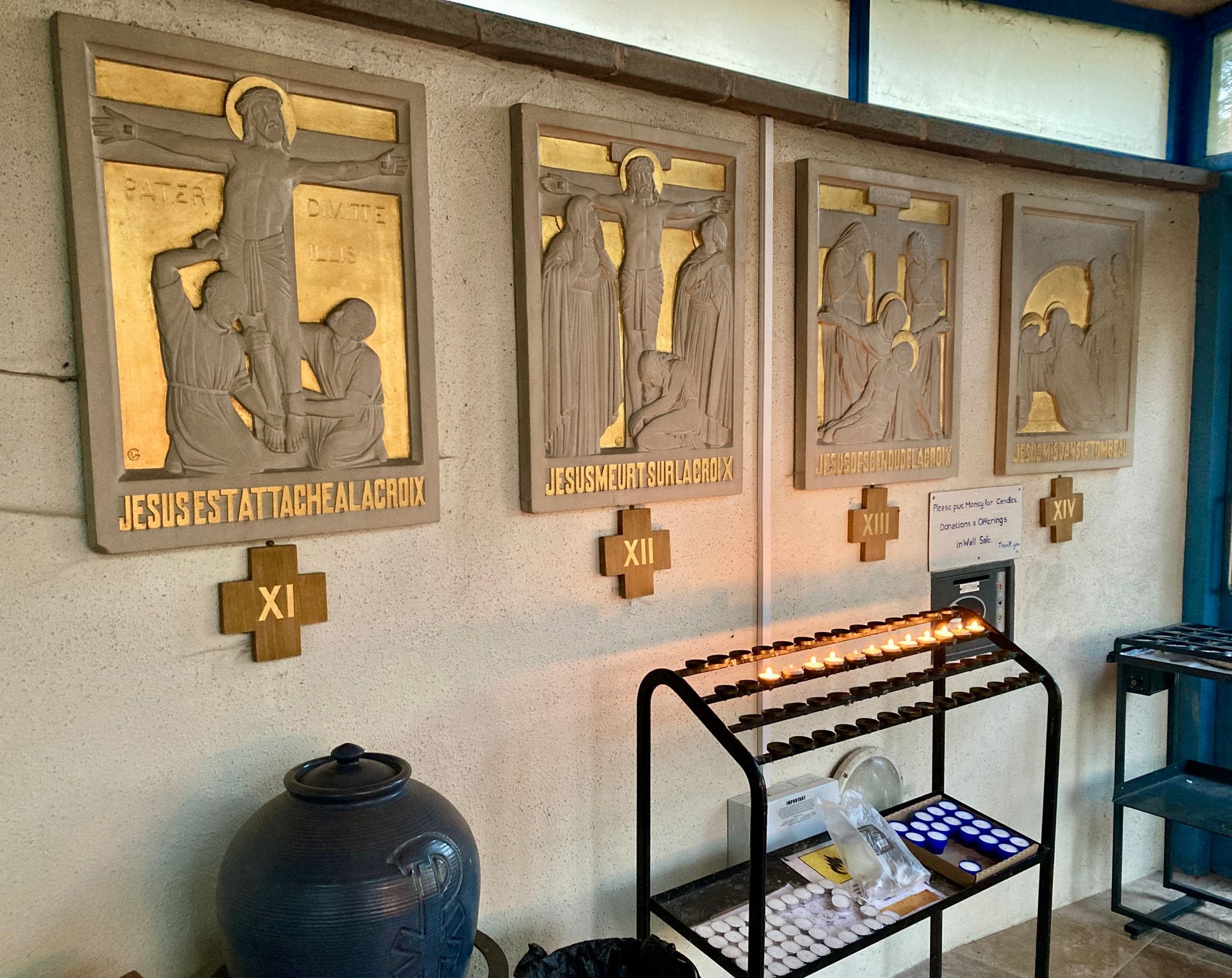 SHRINE WEBSITE
SHRINE WEBSITEA Diocesan Shrine in the care of the Diocese
Ladyewell House, Fernyhalgh Lane, Fernyhalgh, Preston, Lancashire PR2 5ST
The Holy Well shrine is in the grounds of Ladyewell House. Since the Reformation, devotion to Our Lady as Queen of Martyrs has developed, and this is reflected at Ladyewell in the reliquary, the Burgess Altar and the chapel of the English Martyrs. There has never been an apparition of Our Blessed Lady at Fernyhalgh, just continued prayer and petition over 7 centuries.
Apart from 5 years during penal times, the shrine has attracted pilgrims and been the focus of Catholic prayer. Between May and October the dioceses of Lancaster, Liverpool and Salford hold their annual pilgrimages. Syro-Malabar Catholics and Irish travellers visit throughout the year, and devotion at Ladyewell is ecumenical, attracting Anglican and Orthodox Christians, as well as people of other faiths.
Shrine prayer
Hail, Holy Queen, Mother of Mercy,
our life, our sweetness and our hope.
To you do we cry, poor banished children of Eve.
To you do we send up our sighs, mourning and weeping in this valley of tears
Turn then, most gracious advocate,
your eyes of mercy toward us, and after this exile show unto us the blessed fruit of thy womb, Jesus.
O clement, O loving, O sweet Virgin Mary, pray for us, O holy Mother of God, that we may be made worthy of the promises of Christ.
Amen,
Our Lady of Fernyhalgh, Pray for us.
WALKING PILGRIMAGE TO THE SHRINE
The Shrine is on the Way of Our Lady of Fernyhalgh and St Alphonsa. More details here.
Lancaster: Our Lady of Lourdes
SHRINE WEBSITEA Diocesan Shrine in the care of the Diocese
St. Mary's Priory, Cleator, Cumbria CA23 3AB
Cleator boomed as a mining town in the nineteenth century, bringing many Irish workers. A Benedictine mission was established in 1853. A stone church was built with seating for 600. This building later became part of St Mary’s School when the present church was built in the 1870s. It is a good example of an E. W. Pugin church and retains much of its original character and furnishings. It was reordered in the 1970s.
The Grotto was built in 1927, when international travel was difficult for most people, as a shrine to Our Lady. It was built with stone from the local mine pit banks and made to represent the Grotto at Lourdes. It became a place of pilgrimage for people from Lancashire and Cumbria and was dedicated by Cardinal Basil Hume in 1980.
Shrine prayer
Ever immaculate Virgin, Mother of Mercy, Health of the Sick, Refuge of Sinners, Comfortess of the Afflicted, you know my wants, my troubles, my sufferings. Look upon me with mercy.
When you appeared in the grotto of Lourdes, you made it a privileged sanctuary where you dispense your favors, and where many sufferers have obtained the cure of their infirmities, both spiritual and corporal. I come, therefore, with unbounded confidence to implore your maternal intercession.
My loving Mother, obtain my request. I will try to imitate your virtues so that I may one day share your company and bless you in eternity.
Amen.
Our Lady of Lourdes, Pray for us.
WALKING PILGRIMAGE TO THE SHRINE
The St Mary's Way ends at the Shrine. More details here.
Leeds: Catholic Women's League Wayside Calvary
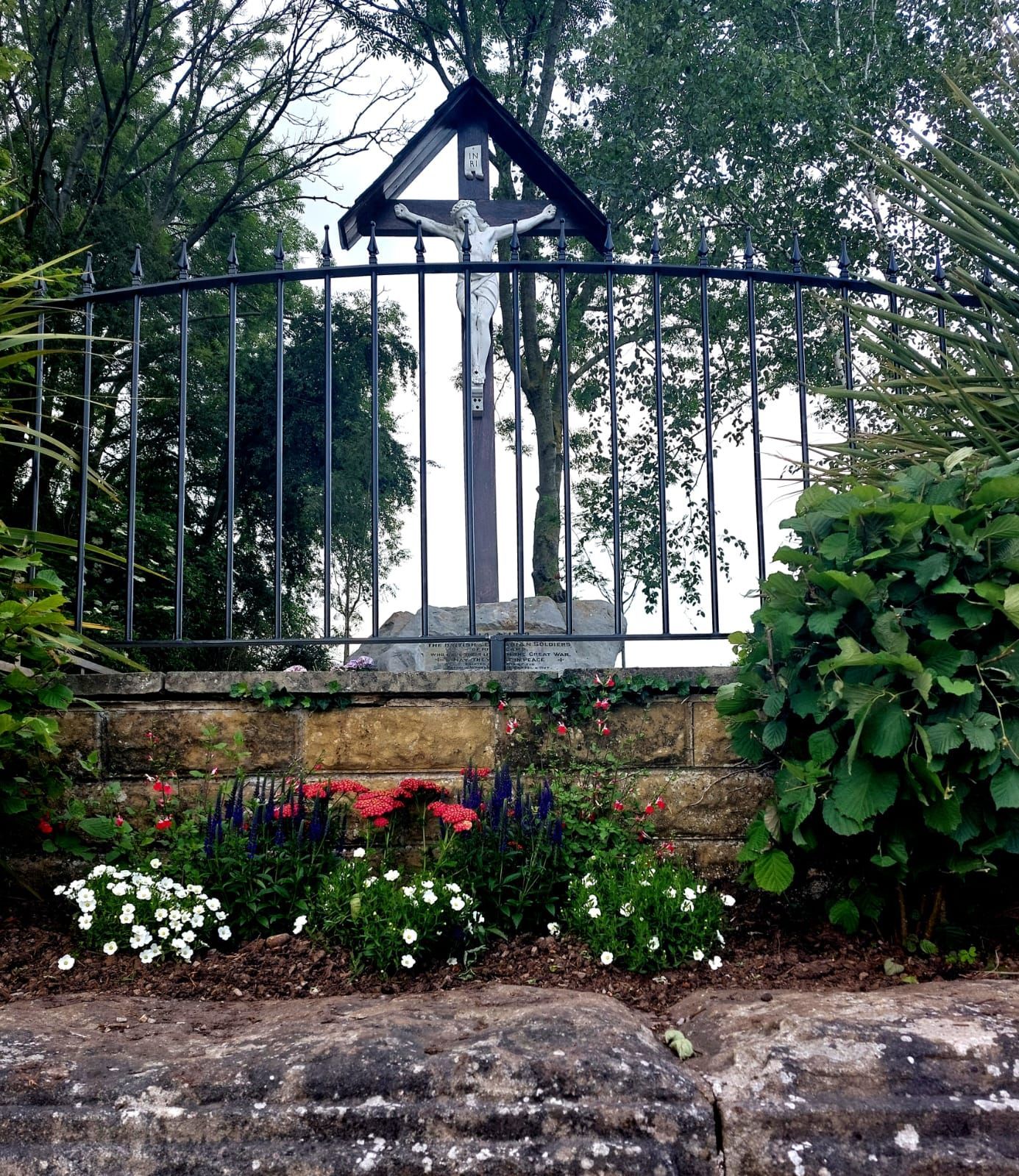 MORE INFORMATION
MORE INFORMATIONAn Informal Shrine in the care of the Trustees of the Catholic Women's League
Located at the junction of Studley Lane on the B6265 Limekiln Bank Studley Roger Ripon OS Grid Ref: SE 28935 70599
The memorial, which stands on the site of the Catholic Women's League Chapel and Canteen at Ripon Camp, commemorates the British and Canadian servicemen of the camp who lost their lives in World War I. It is in an elevated position to the north side of the B6265 road immediately opposite the end of Studley Lane. It stands within its own small garden reached by steps on the Ripon side of the enclosure.
A wooden cross is set into a rough hewn rock on which the 2 inscriptions have been carved.. The carved figure of Christ sits under a narrow tiled roof and appears to be painted white with black nails. The garden is mainly gravelled and provided with 6 seats marking various anniversaries of the Catholic Women's League and a number of decorative trees. On the wall facing the road there is a more modern cast metal plaque with a futher similar inscription.
Every year members of Leeds Branch of the Catholic Women’s League gather at St Wilfrid’s Catholic Church, Ripon for Mass before making a pilgrimage to the Wayside Shrine. More information about the war work of the CWL and the Ripon Shrine can be found by clicking the button below.
Shrine prayer
Eternal rest grant unto them, O Lord, and let perpetual light shine upon them.
May their souls and the souls of all the faithful departed, through the mercy of God, rest in peace.
Amen
St Margaret Clitherow, Pray for us.
WALKING PILGRIMAGE TO THE SHRINE
The nearest Pilgrim Way is the St Wilfrid's Way from Leeds to Ripon. More details here.
Leeds: Our Lady of the Crag
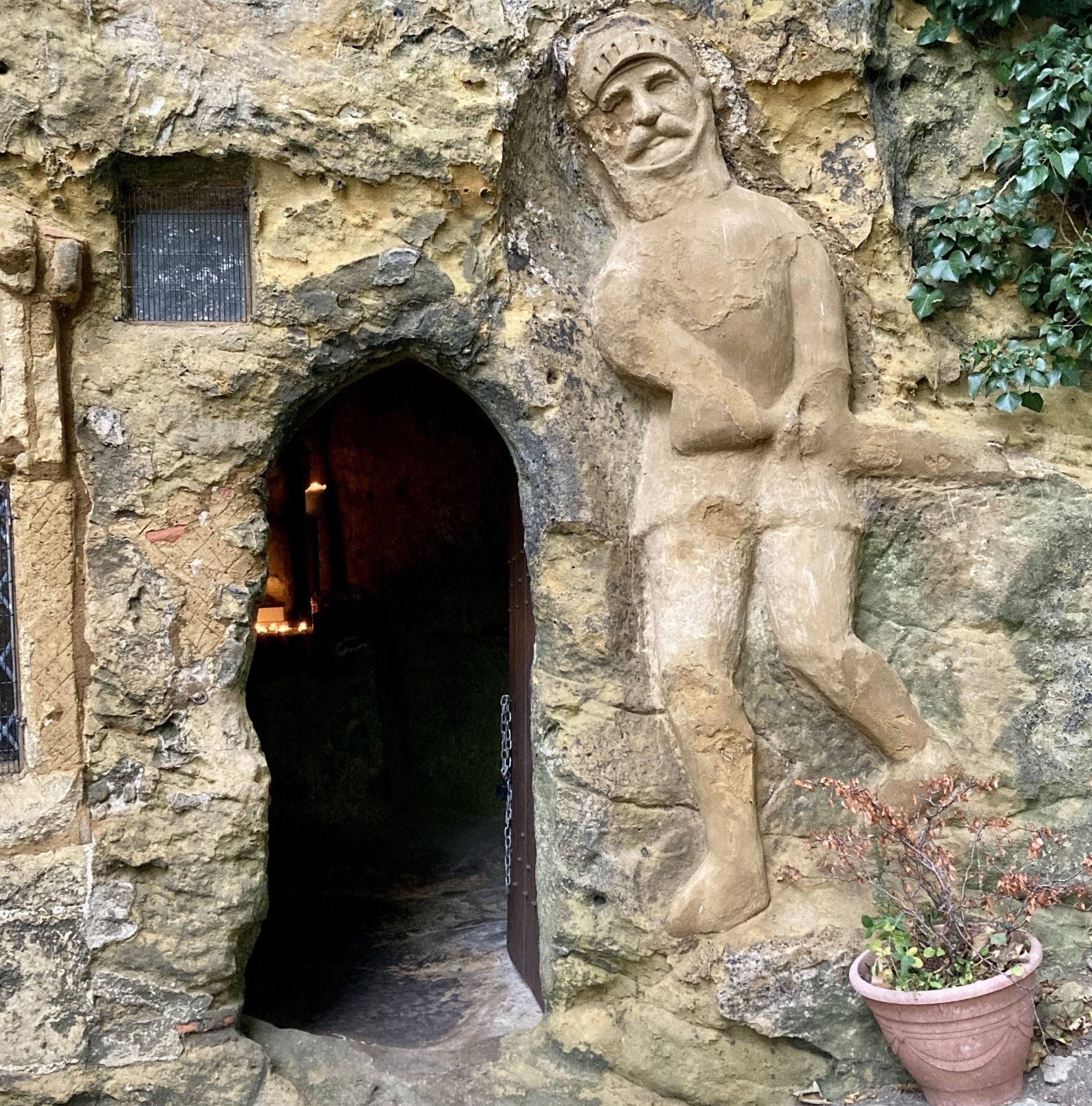 SHRINE WEBSITE
SHRINE WEBSITEAn Informal Shrine in the care of the Chapel of Our Lady of the Crag Trust
Abbey Road, Knaresborough HG5 8HY
This tiny medieval Chapel was carved from the cliff face by John the Mason in 1408. It was probably built as a wayside shrine for pilgrims and as a place of quiet and prayer for the quarrymen from the nearby quarry.
The legend is that John the Mason was working in the quarry when he saw that a rock fall was about to kill his son. Unable to reach him, John prayed to the Virgin Mary, the stones changed direction and his son was saved. John pledged to create a chapel in thanks for the miracle.
The Chapel ceased to function at the Reformation, but in 1916 it was reconsecrated as a Catholic place of worship after its acquisition by Ampleforth Abbey. The windows have been conserved and a figure of a medieval knight restored. In 2000 a modern statue of the Madonna and Child placed in the shrine.
Since 2017 the site has been in the care of the Chapel of Our Lady of the Crag Trust.
Shrine prayer
Hail, Mary, full of grace, the Lord is with thee.
Blessed art thou amongst women and blessed is the fruit of thy womb, Jesus.
Holy Mary, Mother of God, pray for us sinners,
now and at the hour of our death.
Amen.
Our Lady of the Crag, pray for us.
WALKING PILGRIMAGE TO THE SHRINE
The Shrine is on the St Wilfrid's Way. More details here.
Liverpool: Blessed Dominic Barberi
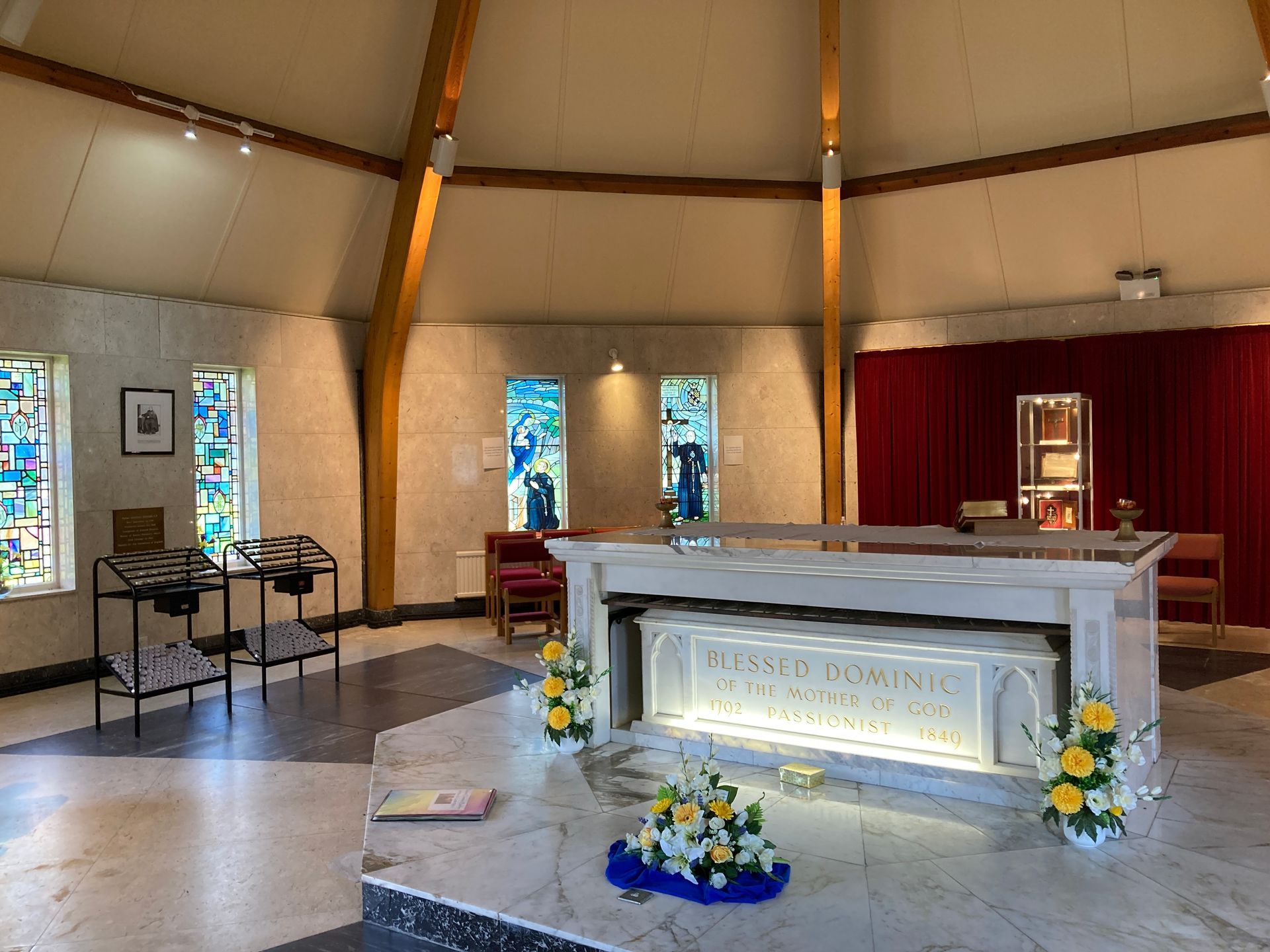 SHRINE WEBSITE
SHRINE WEBSITEA Diocesan Shrine in the care of the Passionist Order
St Anne and Blessed Dominic, Monastery Road, St Helens WA9 3ZD
The parish originated in 1849 and was in the care of Passionist priests based in an adjacent monastery until 2004. The old church and monastery were demolished due to mining subsidence and much of the site sold to build a new parish centre.
The new polygonal Church dates from 1973 and is the burial place and shrine to three notable figures from the Catholic ‘Second Spring’: Blessed Dominic Barberi (1792-1849), who established the Passionist congregation in England and was instrumental in the conversion of John Henry Newman; the Venerable George (Ignatius) Spencer (1799-1864), Passionist priest and the convert son of the second Earl Spencer and the Venerable Elizabeth Prout (1820-64), founder of the Sisters of the Cross & Passion.
Annual Pilgrimage Days are held on the Anniversaries of these three holy people whose Causes for Canonisation are making gradual progress. The pilgrimages are held on or around these dates each year:
- Elizabeth Prout 28th May
- Blessed Dominic Barberi 28th August
- Ignatius Spencer 1st October
Shrine prayer
O God, who so lovingly raised Blessed Dominic to the heights of holiness, learning and apostolic zeal and made him a powerful minister of your mercy, listen to our humble request.
We pray that you will in your goodness, grant a miracle through the intercession of Blessed Dominic, so that the Church may further honour him on earth and that many more people will come to know and invoke the help of this faithful servant of the Church.
We ask this through Christ Our Lord.
Amen.
Mary, Mother of Holy Hope, Pray for Us.
St Anne, Pray for us,
Saint John Henry Newman, Pray for Us.
Blessed Dominic Barberi, Pray for Us.
WALKING PILGRIMAGE TO THE SHRINE
The Shrine is on the Way of Blessed Dominic Barberi & St Edmund Arrowsmith. More details here.
Liverpool: Blessed Sacrament
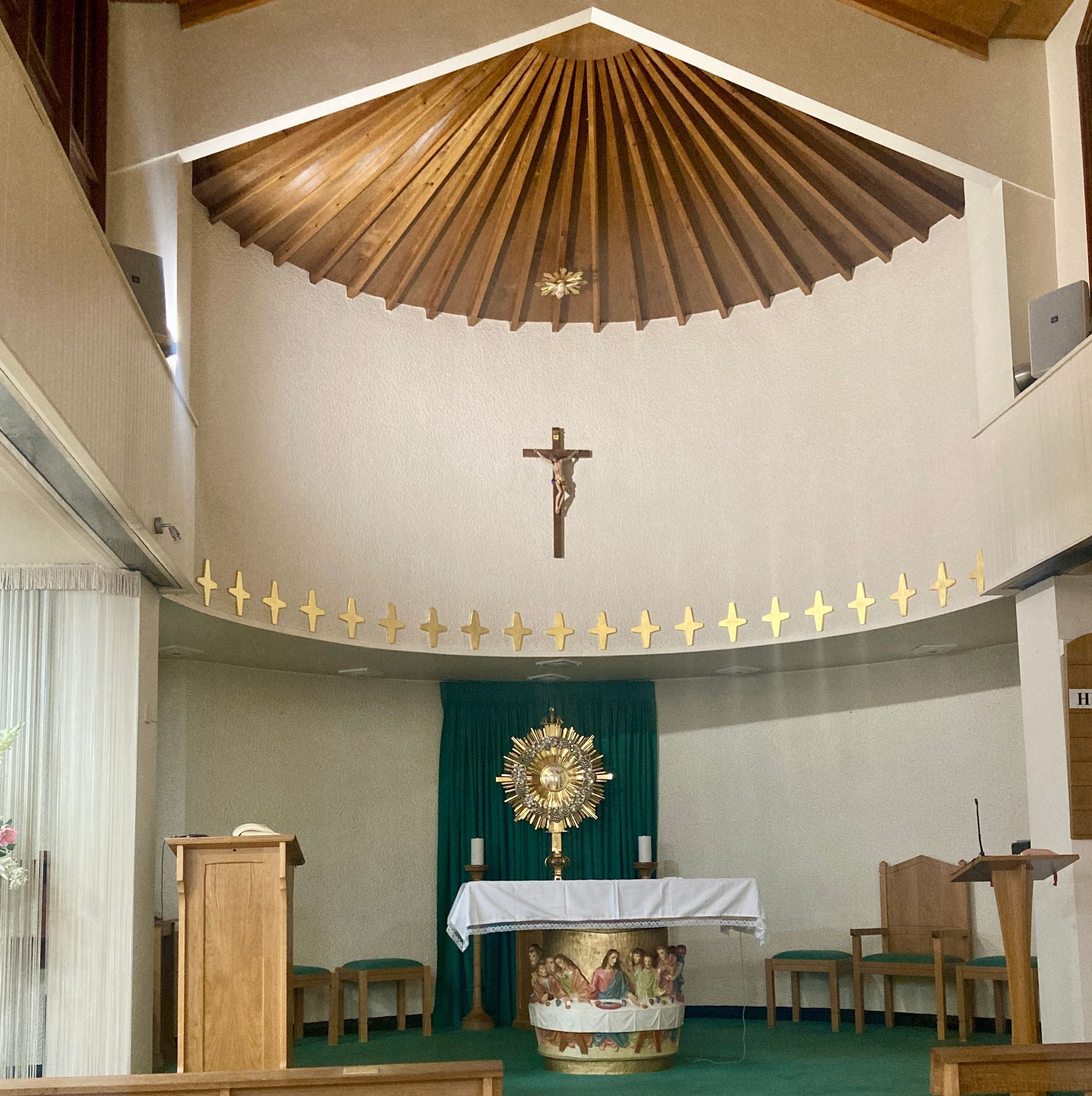 SHRINE WEBSITE
SHRINE WEBSITEA Diocesan Shrine in the care of the Congregation of Blessed Sacrament
4 Dawson Street, Liverpool, Merseyside L1 1LE
The Congregation of the Blessed Sacrament is an apostolic group of men who assist the Church to form Christian communities centred on the Eucharist.
In 1970 the Congregation made a Foundation of St. Augustine’s Oratory, Great Howard Street, Liverpool and started to search for a base in the city centre. A site was found in Clayton Square, and a shrine was inaugurated in November 1972. After 12 successful years the community relocated to Dawson Street.
Today the Shrine is a centre for evangelisation, Eucharistic adoration, celebration of the sacraments and an oasis of peace in the heart of the city.
Shrine prayer
Lord Jesus Christ, you gave us the Eucharist
as a memorial of your suffering and death.
May our worship of this Sacrament of your body and blood help us to experience the salvation you won for us and the peace of the kingdom where you live with the Father and the Holy Spirit, one God, for ever and ever.
Amen
WALKING PILGRIMAGE TO THE SHRINE
The Shrine is on the Way of Blessed Dominic Barberi & St Edmund Arrowsmith. More details here.
Liverpool: Our Lady of Perpetual Succour
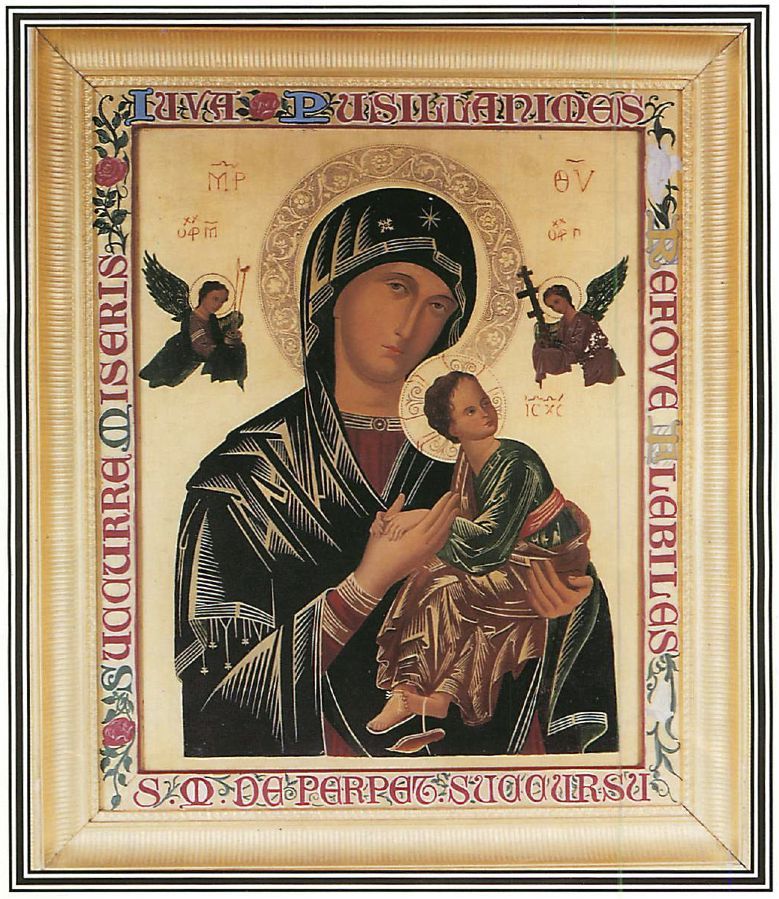
A Diocesan Shrine in the care of the Redemptorist Order
Our Lady of the Annunciation, Bishop Eton, Woolton Road, Liverpool L16 8NQ
The Church of Our Lady of the Annunciation at Bishop Eton is served by The Redemptorists. This fine church, designed by A.W.N. Pugin and with furnishings by J. F Bentley, opened in 1858.
Bishop Eton has additional significance in that it holds the first copy outside of Rome of the famous icon of Our Lady of Perpetual Succour (1866). The Shrine is open daily and provides a place of prayer for pilgrims, together with an active lay-led Shrine Ministry.
Shrine Prayer
O Mother of Perpetual Help, with great confidence we come before your holy icon to be inspired by the example of your life.
We think of you at that moment, when, full of faith and trust, you accepted God's call to be the mother of his Son.
Help us your children, to accept with joy our calling in life. When you learned that your cousin Elizabeth was in need, you immediately went to serve her and offer your help. Make us, like you, to be concerned for others.
We think of you, Mother, at the foot of the cross. Your heart must have bled to see your Son in agony. But your joy was great when he rose from the dead, victorious over the power of evil. Mother of Sorrows, help us through our trials and disappointments. Help us not to lose heart.
May we share with you and your Son the joy of having courageously faced up to all the challenges of life.
Amen
Our Lady of Perpetual Succour, Pray for us.
WALKING PILGRIMAGE TO THE SHRINE
The Shrine is on the Way of Blessed Dominic Barberi & St Edmund Arrowsmith. More details here.
Liverpool: St Edmund Arrowsmith
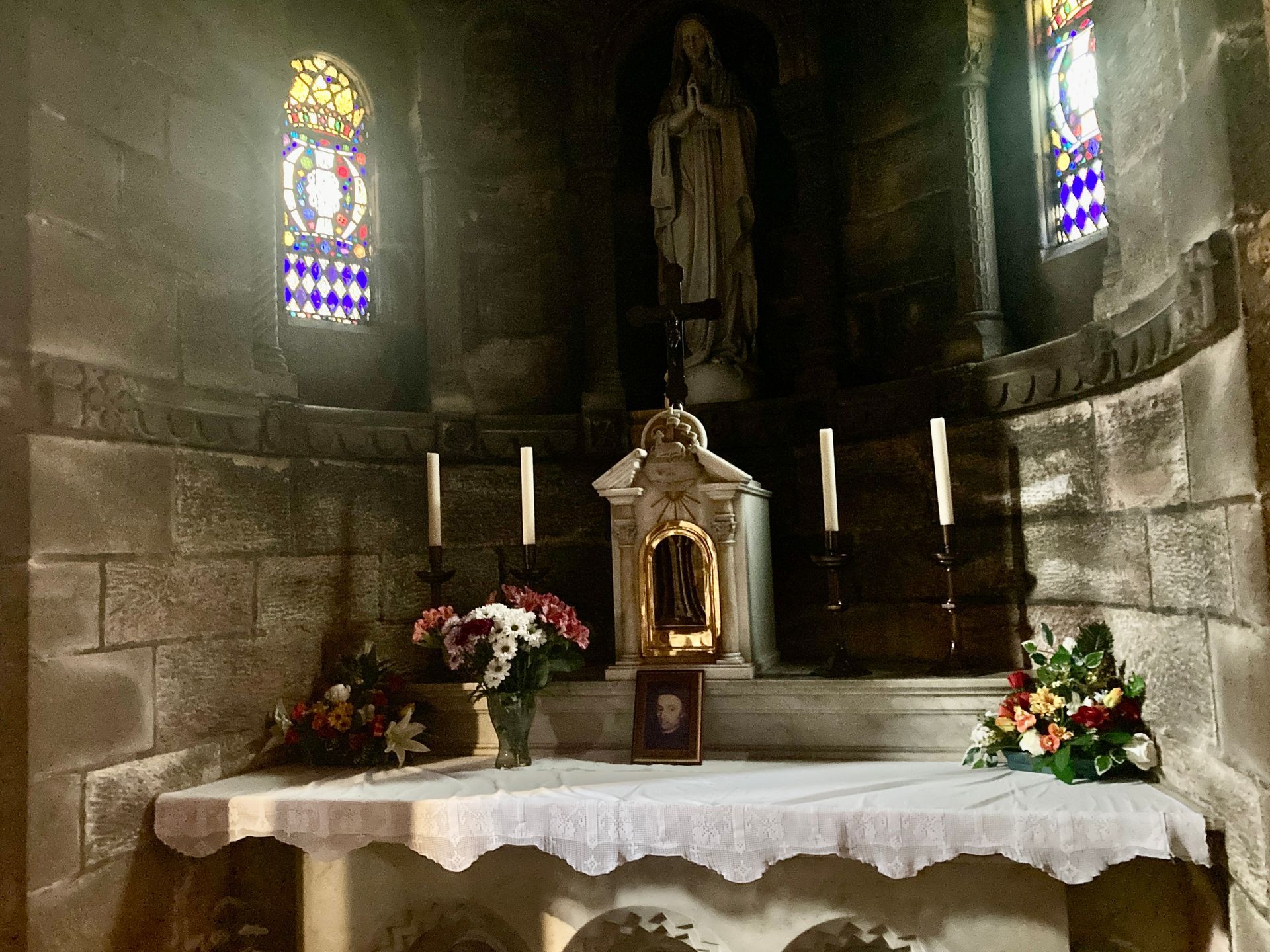 SHRINE WEBSITE
SHRINE WEBSITEA Diocesan Shrine in the care of the Archdiocese
The Church of SS Oswald & Edmund Arrowsmith, Liverpool Road, Ashton-in-Makerfield, Wigan WN4 9NP
The first Catholic chapel was built in 1822, and the cast-iron entrance gates to the churchyard and the presbytery date from that time. The present Church was built on the same site and was opened in 1930. The design was inspired by the Romanesque churches of southern France. It is embellished by fine stone carving and Arts & Crafts stained glass. It is said that the church was built using local labour to provide relief during the Depression. St Edmund Arrowsmith was added to the dedication on his canonisation. Lord Joe Gormley, former President of the NUM who grew up nearby, is commemorated in the churchyard.
St Oswald c 604–642 was King of Northumbria and did much to spread the faith throughout his Kingdom.
Brian Arrowsmith (1585-1628) was born at nearby Haydock into a recusant family. He left England at age 21 to attend the English College at Douai, (today France, but then in Flanders), where he was confirmed, taking the name Edmund.
He was ordained priest in 1612 and in 1613 he returned to Lancashire. He was arrested about 10 years after his return and imprisoned but was freed when King James I pardoned all Catholic priests. In 1624 he joined the Society of Jesus (Jesuits). In 1628 he was captured by priest-hunters, convicted of being a priest, then a crime of high treason, and a few days later, hanged, disembowelled and quartered. He is one of the 40 English Martyrs canonised in 1970.
After his execution his right hand was cut off and came into the care of a local recusant family. It is preserved in a glass and silver casket and has been venerated in the Church for over two centuries.
Shrine prayer
Lord, you gave St Edmund Arrowsmith the courage to live out his faith in a time of persecution.
Help us to practice the virtue of Justice and to stand for truth and dignity.
Amen.
St Edmund Arrowsmith; Pray for us.
WALKING PILGRIMAGE TO THE SHRINE
The Shrine is on the Way of Blessed Dominic Barberi & St Edmund Arrowsmith. More details here.
Middlesbrough: Our Lady of Mount Grace
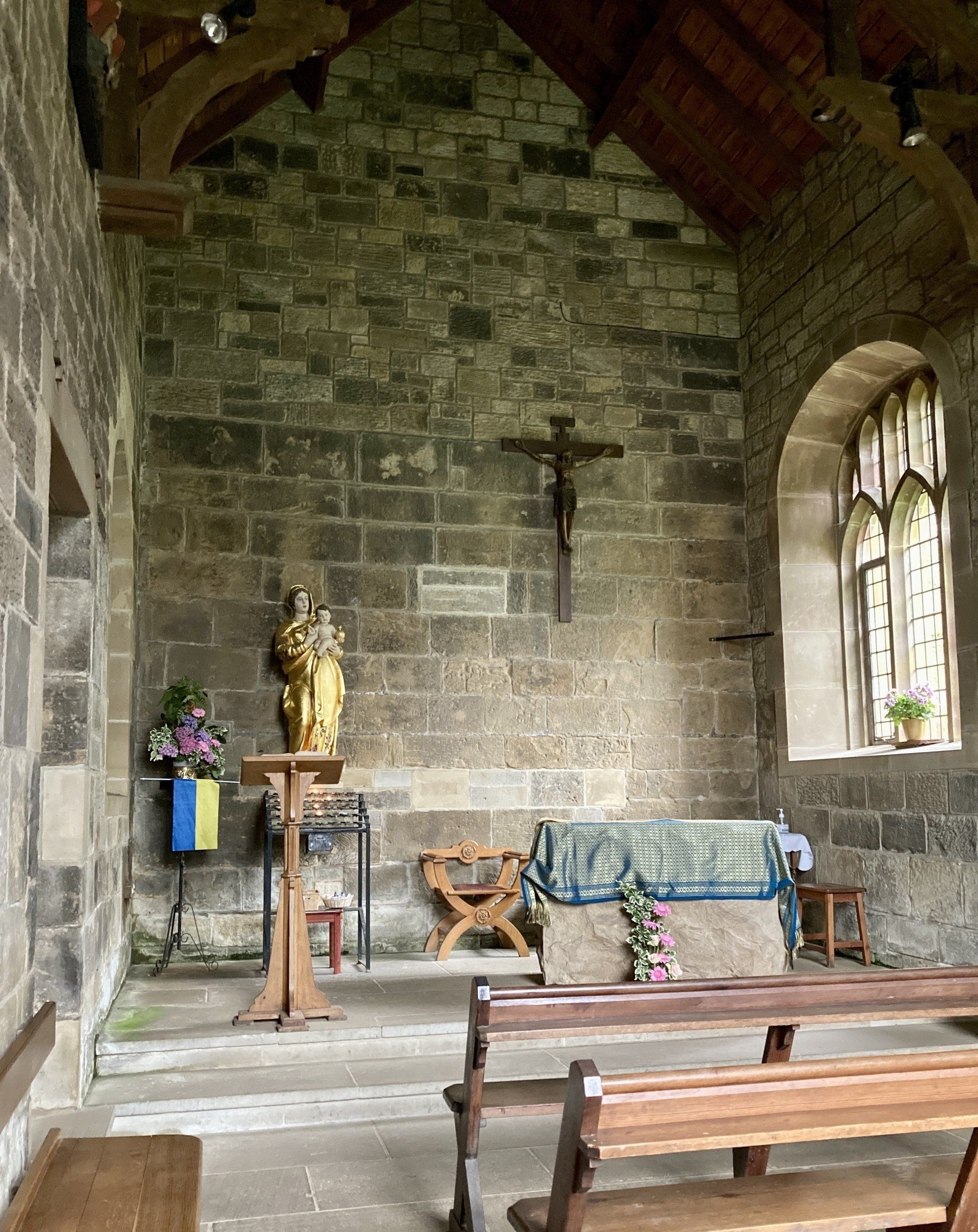 SHRINE WEBSITE
SHRINE WEBSITEA Diocesan Shrine in the care of Diocese
The Lady Chapel Ruebury Lane Osmotherley DL6 3AP
The chapel seems to have been built at the same time as Mount Grace Priory and may have been an associated hermitage until the Reformation. It fell to ruin but remained a place of pilgrimage and prayer.
In 1614, on the eve of Little Lady Day, September 7th, sixteen people were arrested and later confessed to having prayed at the chapel. The Chapel was restored in the mid-20th Century and now it is open 24 hours a day, and Mass is celebrated every week.
Shrine prayer
Hail, Mary, full of grace, the Lord is with thee.
Blessed art thou amongst women
and blessed is the fruit of thy womb, Jesus.
Holy Mary, Mother of God, pray for us sinners, now and at the hour of our death.
Amen.
Our Lady of Mount Grace; pray for us
WALKING PILGRIMAGE TO THE SHRINE
The Way of Our Lady of Mount Grace ends at the Shrine. More details here.
Northampton: Our Lady of Guadalupe
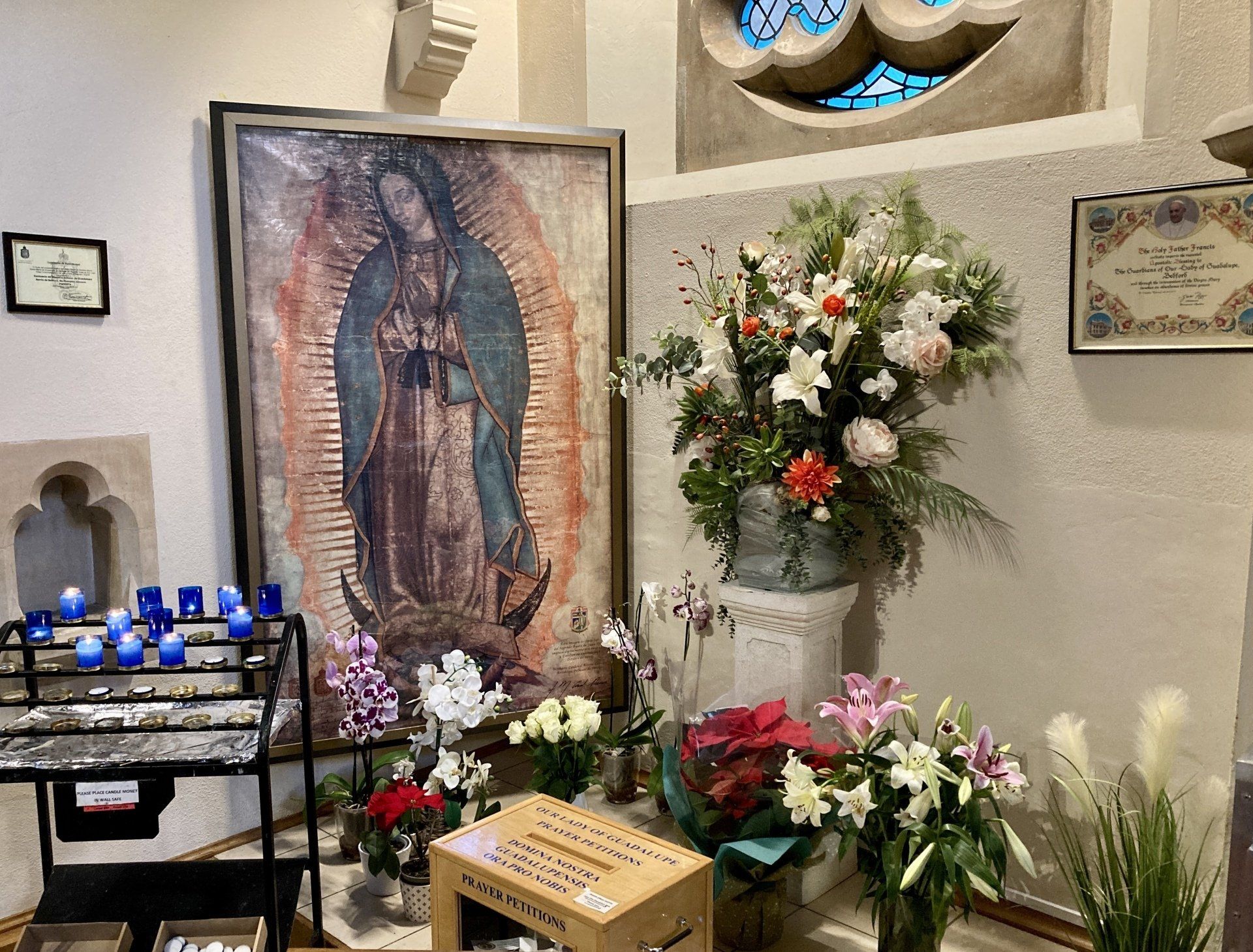 SHRINE WEBSITE
SHRINE WEBSITEA Diocesan Shrine in the care of Diocese
Holy Child & St Joseph Catholic Church, 2 Brereton Rd, Bedford MK40 1HU
The Shrine is in the Church of the Holy Child & St Joseph in central Bedford. It is an impressive stone-built Church, begun in the 1870s and completed in 1911. The interior is notable for the richness and quality of its stone and other furnishings.
In 1531, Our Lady is said to have appeared in Guadalupe, Mexico as the pregnant Mother of God to a humble peasant named Juan Diego. She left an image of her appearance on his cloak (tilma), which still exists in the Basilica of Our Lady of Guadalupe in Mexico City.
St Pope John Paul II authorised the creation of 220 replicas of this image for worldwide distribution, one of which is venerated in this Church. Each of these images were touched to the original at the International Life & Mercy Crusade in 2004. The Church has decreed that these replicas bear the same grace as the original.
Many people of Mexican origin visit the Bedford shrine. In Mexico this icon is a symbol of justice and is especially venerated by poor and marginalized people. Our Lady of Guadalupe represents people who stand against oppression and she is known as the Protectoress of the Unborn.
The feast day of Our Lady of Guadelupe is the 12th December.
Shrine prayer
O Virgin of Guadalupe,
Mother of the Americas,
grant to our homes the grace of loving
and respecting life in its beginnings,
with the same love with which
you conceived in your womb
the life of the Son of God.
Blessed Virgin Mary,
Mother of Fair Love,
protect our families so that
they may always be united
and bless the upbringing of our children.
Amen.
Our Lady of Guadalupe; pray for us.
WALKING PILGRIMAGE TO THE SHRINE
The Way of Our Lady of Guadalupe ends at the Shrine. More details here.
Northampton: Our Lady of Perpetual Succour
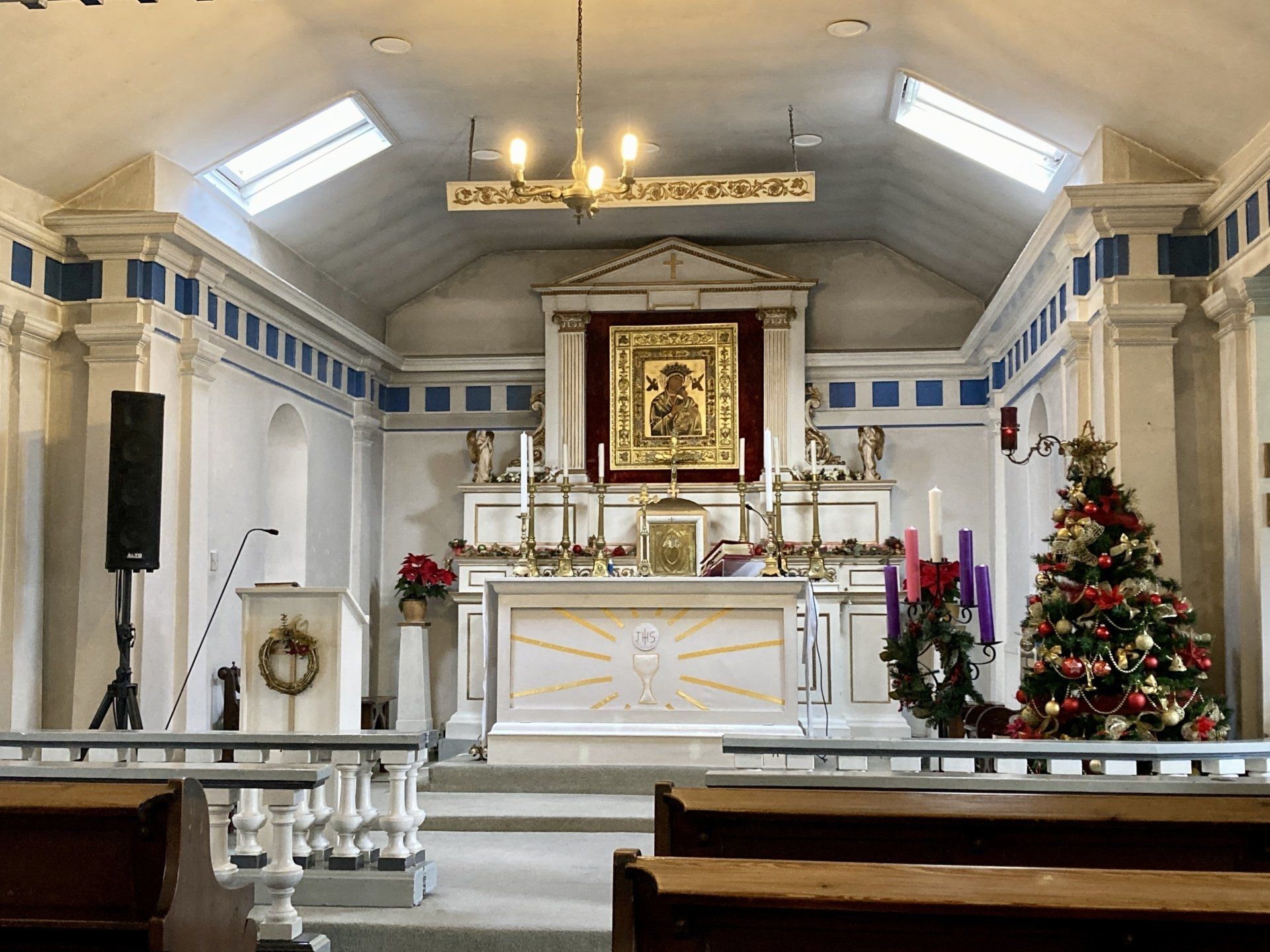 SHRINE WEBSITE
SHRINE WEBSITEA Diocesan Shrine in the care of the Diocese.
The Church and Shrine of Our Lady of Perpetual Succour, Elwes Way, Great Billing, Northampton NN3 9EA
This Church owes its existence to the Elwes family of the now-demolished Billing Hall. In 1866 Valentine Cary Elwes inherited the estate. When he and his family converted to Catholicism in 1874 a chapel was set up in the Hall, which was replaced in 1878 by this church in the village. Its white walls and tower give it a Mediterranean character and inside it is charmingly neo-classical.
As the Shrine of Our Lady of Perpetual Succour the altar incorporates a copy of this famous icon of Mary.
Shrine prayer
O Mother of Perpetual Help,
with great confidence we come before your holy icon to be inspired by the example of your life.
We think of you at that moment, when, full of faith and trust, you accepted God's call to be the mother of his Son.
Help us your children, to accept with joy our calling in life.
When you learned that your cousin Elizabeth was in need, you immediately went to serve her and offer your help.
Make us, like you, to be concerned for others.
We think of you, Mother, at the foot of the cross.
Your heart must have bled to see your Son in agony.
But your joy was great when he rose from the dead, victorious over the power of evil.
Mother of Sorrows, help us through our trials and disappointments.
Help us not to lose heart.
May we share with you and your Son the joy of having courageously faced up to all the challenges of life.
Amen.
Our Lady of Perpetual Succour, Pray for us.
WALKING PILGRIMAGE TO THE SHRINE
The Shrine is on the Way of Our Lady of Guadalupe. More details here.
Nottingham: Blessed Cyprian Tansi
 SHRINE WEBSITE
SHRINE WEBSITEAn Informal Shrine in the care of the Cisterian Order
Mount St Bernard Abbey, Oaks Rd, Coalville, Leicestershire LE67 5UL
Cyprian Michael Iwene Tansi (1903–1964) was an Igbo Nigerian priest who became a monk of Mount St Bernard Monastery. He was beatified in 1998.
Mount St Bernard Abbey is a Cistercian (Trappist) monastery founded in 1835. The Cistercian order dates to the C12. Trappist communities are dedicated to strict observance of the Cistercian rule and date to the mid C17.
Following the suppression of monasteries in France, a small colony of dispossessed Trappist monks arrived in London in 1794, with the intention of moving on to found a monastery in Canada. Thomas Weld, a Catholic recusant and philanthropist, provided them with land on his estate at East Lulworth. The monks remained at Lulworth until 1817, when following the Bourbon Restoration they returned to France to re-establish the ancient Melleray Abbey in Brittany. Following the 1830 July Revolution the monks were again persecuted and left to found Mount Melleray Abbey in Ireland (1833). From here a small community of monks was sent to found Mount St Bernard in 1835.
The Abbey was the first permanent monastery founded in England since the Reformation. The monks live a contemplative life of work, prayer, radical discipleship and fidelity to the Gospel. Mount St Bernard is the only Trappist house in England and the monks brew the only Trappist beer in Britain.
Shrine prayer
Blessed Cyprian,
during your life on earth
you showed your great faith and love
in giving yourself to your people
and by the hidden life
of prayer and contemplation.
Look upon us now in our needs,
and intercede for us with the Lord.
May he grant us the favour we ask
through our prayers.
Amen.
St Bernard, Pray for us.
WALKING PILGRIMAGE TO THE SHRINE
The Way of the Blessed Cyprian Tansi ends at the Shrine. More details here.
Plymouth: St Boniface
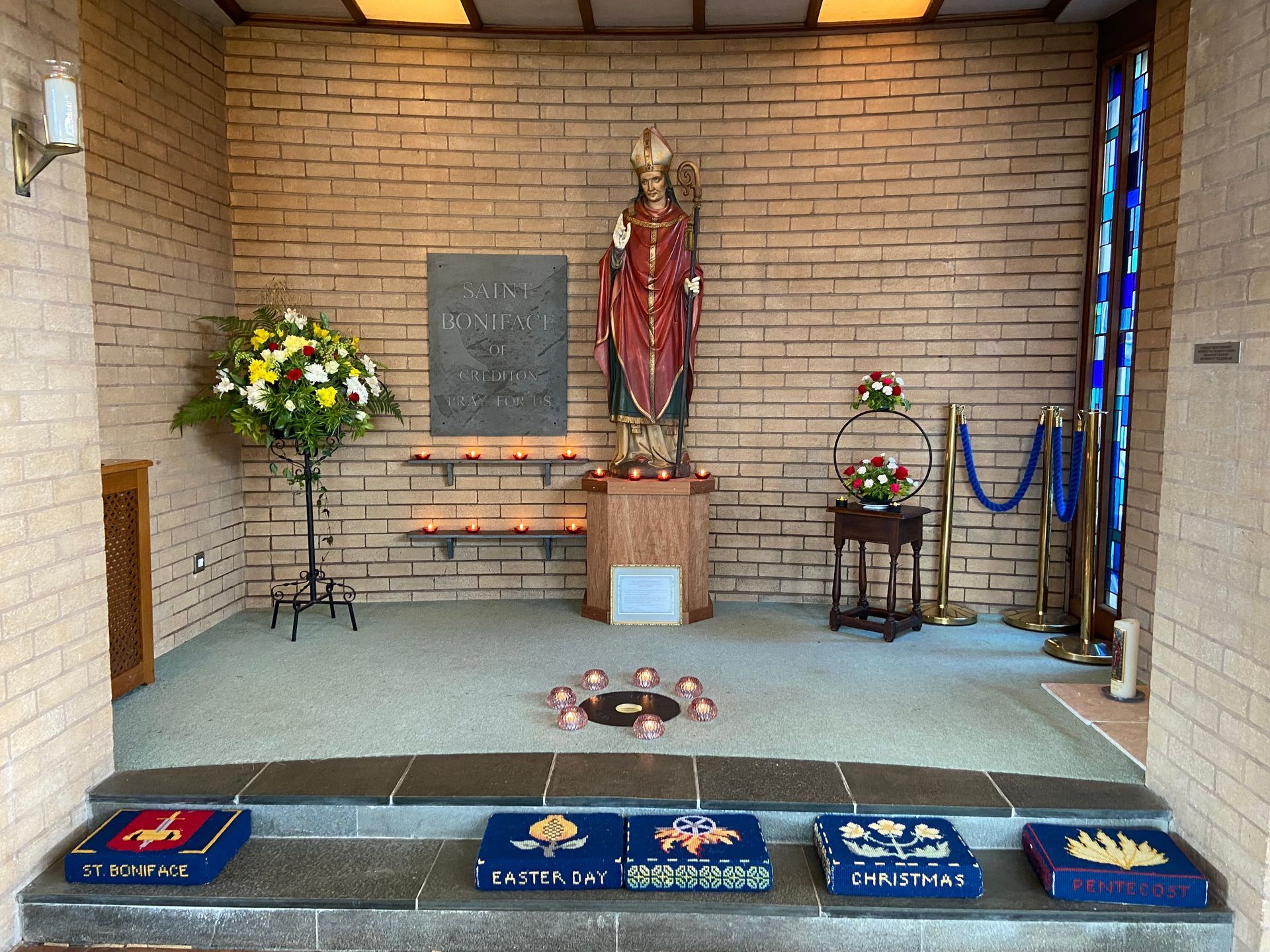 SHRINE WEBSITE
SHRINE WEBSITEA national Shrine in the care of the Diocese
St Boniface Catholic Church, 3 Park Rd, Crediton, Devon EX17 3ES
The church houses the National Shrine of St. Boniface and attracts many pilgrims and visitors from its sister churches in Germany and Holland.
St Boniface is the evangelist of Germany because he led a huge Anglo-Saxon mission sponsored by Pope Gregory II and King Ina of Wessex.
Shrine prayer written by St. Boniface (ca. 672-754)
Eternal God, the refuge and help of all your children,
we praise you for all you have given us,
for all you have done for us,
for all that you are to us.
In our weakness, you are strength,
in our darkness, you are light,
in our sorrow, you are comfort and peace.
We cannot number your blessings,
we cannot declare your love:
For all your blessings we bless you.
May we live as in your presence,
and love the things that you love,
and serve you in our daily lives;
through Jesus Christ our Lord.
Amen.
St Boniface, Pray for us.
WALKING PILGRIMAGE TO THE SHRINE
The Mary & Michael Way passes through Crediton. More details here.
Plymouth: St Cuthbert Mayne
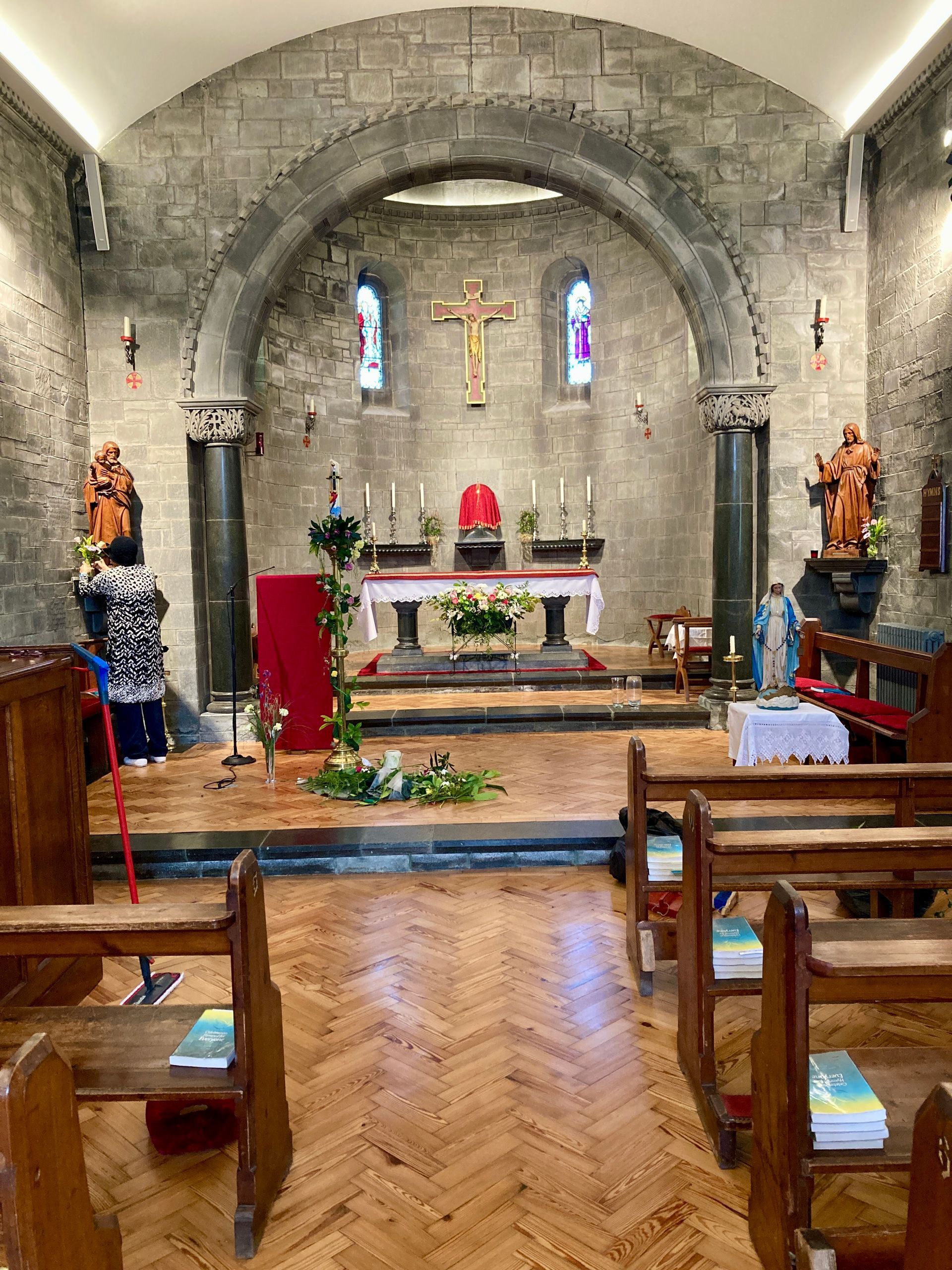 SHRINE WEBSITE
SHRINE WEBSITEA national Shrine in the care of the Diocese
St Cuthbert Mayne Church, 21 Mayne Close, St Stephen's Hill, Launceston, Cornwall PL15 8XQ
Cuthbert Mayne was born in 1543 near Barnstaple. He became an Anglican clergyman but converted to Catholicism at Oxford University under the influence of Edmund Campion. He fled to Douai and became one of the first priests to train abroad for the English mission. He returned in 1576 but was captured after only 3 months and imprisoned at Launceston Castle. The trial judge directed the jury to return a verdict of guilty, stating that, "where plain proofs were wanting, strong presumptions ought to take place". Mayne was convicted and sentenced to death. He was offered his life in return for a renunciation of his faith and an acknowledgement of the queen as head of the church. He kissed a copy of the Bible, declaring that "the queen neither ever was, nor is, nor ever shall be, the head of the church of England". He was hanged, drawn and quartered in the marketplace at Launceston on 29 November 1577.
The mission at Launceston was established in 1886 in the present presbytery by the Rev Charles Baskerville Langdon, an Anglican curate before his conversion. In 1887 a temporary iron church was built next door to the presbytery. The permanent church was built in 1911 in the Byzantine Romanesque style. In 1921 Fr Richard McElroy organised the first national pilgrimage in honour of Blessed Cuthbert Mayne as part of a campaign for the martyr’s canonisation. Fr McElroy provided a shrine in a chapel on the north side of the church. It holds a relic of the martyr’s skull and the ‘Inspeximus’ issued by the Crown giving details of the charges against Mayne.
In 1935 the church was consecrated and dedicated to the newly canonised SS John Fisher and Thomas More, and to the Blessed English Martyrs. In 1970, Pope Paul VI canonised the 40 English martyrs, including Mayne. The church was rededicated to St Cuthbert Mayne in 1977.
Shrine prayer
Oh God, in whom there is no change or shadow of alteration, you gave courage to the St Cuthbert Mayne.
Grant unto us, we beseech you, through their intercession, the grace to always value the Holy Mass.
May we be strengthened to serve you in imitation of the courage of these Holy Martyrs.
We ask this through Jesus Christ, Your Son, who lives and reigns with You in the unity of the Holy Spirit, forever.
Amen.
St Cuthbert Mayne, Pray for us.
WALKING PILGRIMAGE TO THE SHRINE
The Way of St Cuthbert Mayne ends at the Shrine. More details here.
Plymouth: The Chideok Martyrs
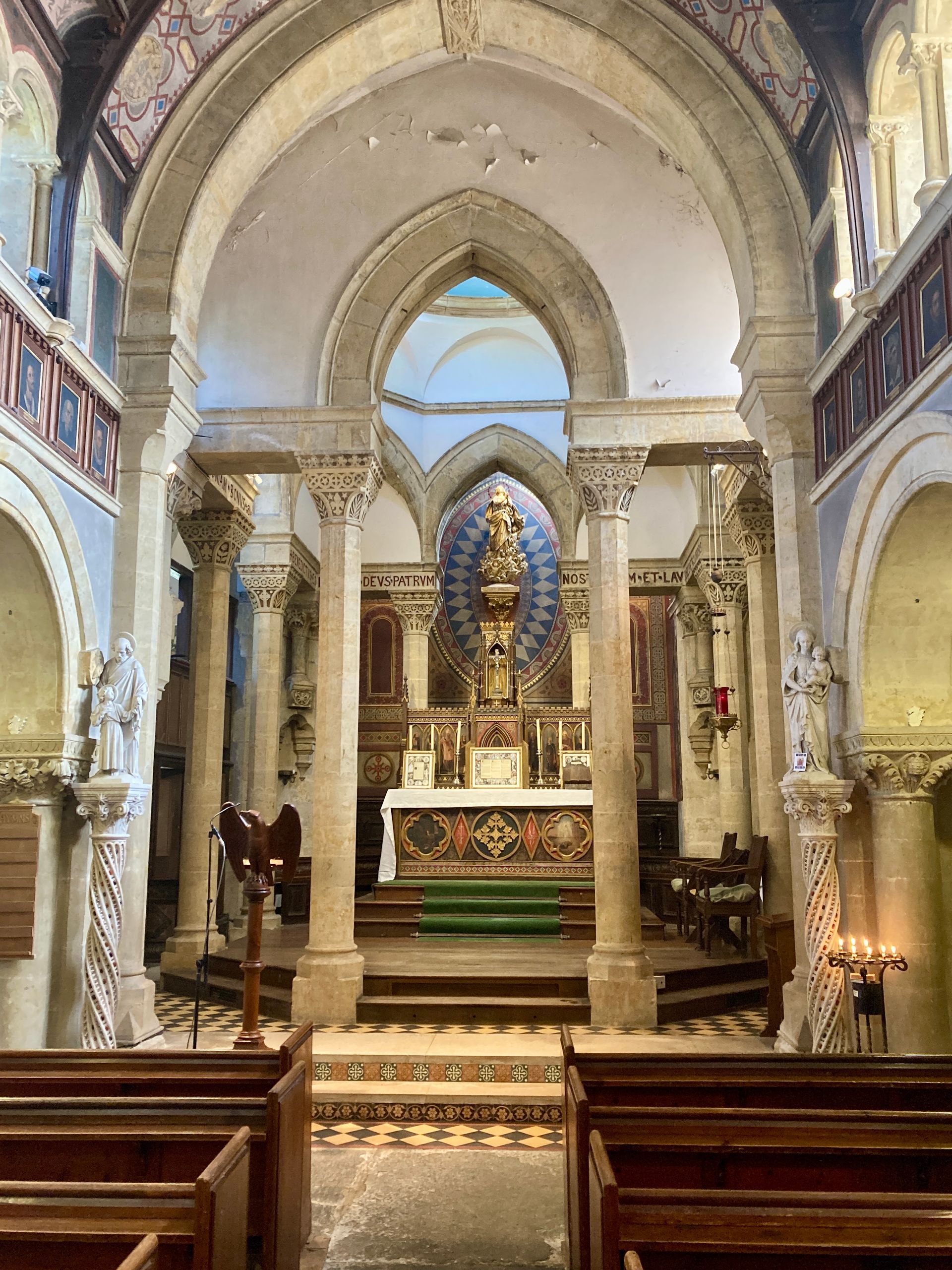 SHRINE WEBSITE
SHRINE WEBSITEA Diocesan Shrine in the care of the Diocese
Our Lady, Queen of Martyrs & St Ignatius Church, North Rd, Chideock, Dorset DT6 6LF
360 men and women are known to have died in England for their Catholic Faith between 1535 and 1681. Of these, eight are associated with Chideock. Seven were put to death and are known as the Chideock Martyrs. The eighth, John Jessop, died in prison. The eight brave men who died for their Catholic Faith:
- Father Thomas Pilchard: Was a Jesuit and despite being banished, in 1586 he returned to England and became Chaplain at Chideock Castle where he was concealed. While he was there, he made many converts.
- Blessed John Cornelius: Was a friend and Chaplain to the Arundells at Chideock Castle. Around Easter 1594, a servant betrayed his presence and he was arrested along with Thomas Bosgrave, a nephew of Lady Arundell, and two servants, John Carey and Patrick Salmon, all of whom had tried to save Fr. Cornelius. All four were executed at Dorchester on 4th July 1594 and beatified in 1929.
- Blessed Hugh Green: also became Chaplain to the Arundell family and was martyred in 1642 after being arrested at Lyme Regis as he tried to escape to France. He was beatified in 1929.
- William Pike: A carpenter in Chideock. Was put to death in Dorchester and beatified, together with Jessop, in 1987.
- Thomas Bosgrave: Nephew of Lady Arundell. Died trying to save Father Cornelius.
- John Carey: Servant of Lady Arundell. Died trying to save Father Cornelius.
- Patrick Salmon: Servant of Lady Arundell. Died trying to save Father Cornelius.
- John Jessop: Put in prison for his faith and died there.
Pilgrim groups are welcome. An annual pilgrimage is organised by the Latin Mass Society in September.
Shrine prayer
Oh God, in whom there is no change or shadow of alteration, you gave courage to the Chideock Martyrs.
Grant unto us, we beseech you, through their intercession, the grace to always value the Holy Mass.
May we be strengthened to serve you in imitation of the courage of these Holy Martyrs.
We ask this through Jesus Christ, Your Son, who lives and reigns with You in the unity of the Holy Spirit, forever.
Amen.
All martyrs of Chideok, Pray for us.
WALKING PILGRIMAGE TO THE SHRINE
Chideock is on the route of the Ways to Whitchurch Canonicorum. More details here.
Portsmouth: St Joseph
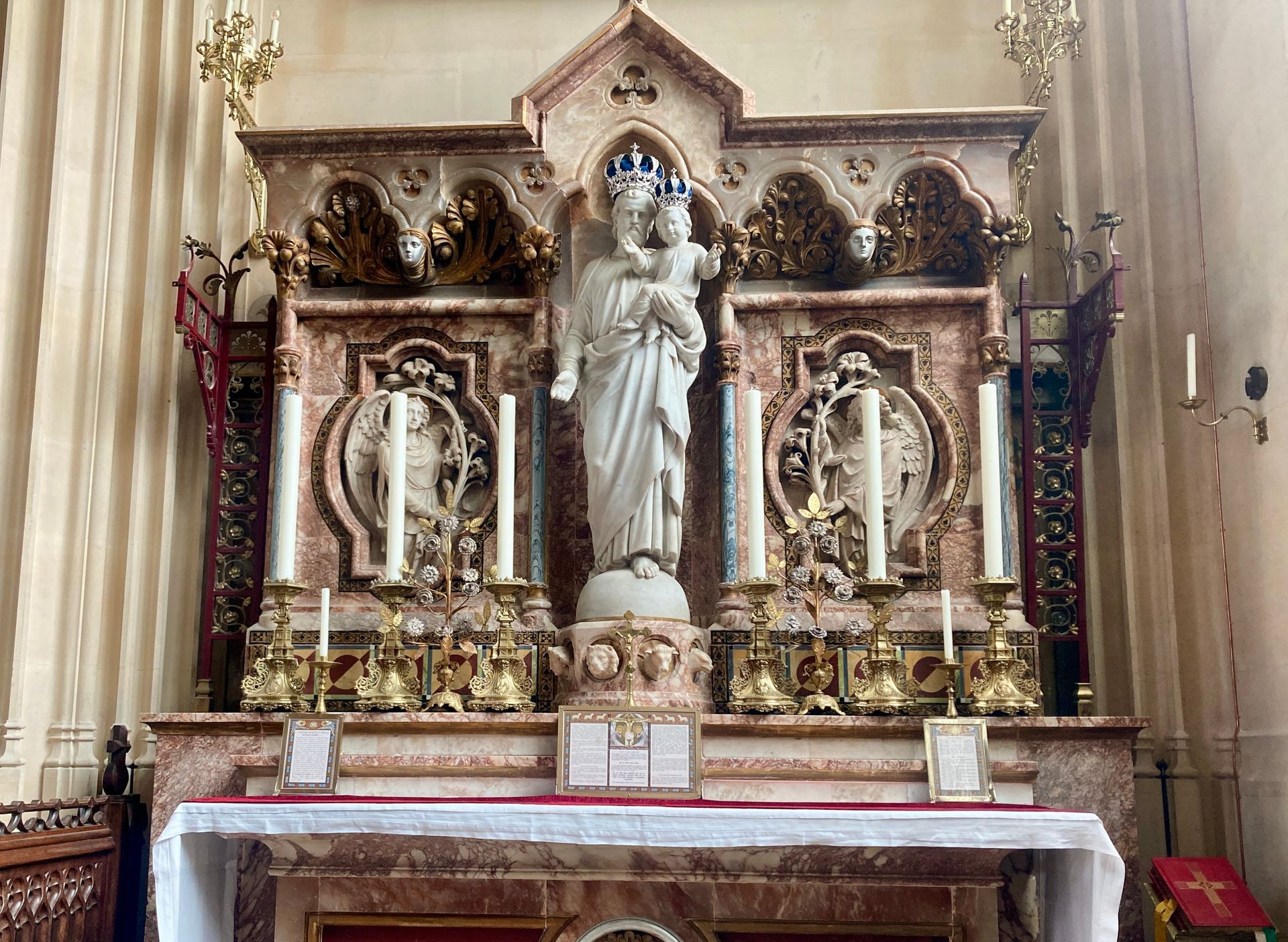 SHRINE WEBSITE
SHRINE WEBSITEA National Shrine in the care of the Benedictine community of Farnborough Abbey
St Michael’s Abbey, 280 Farnborough Rd, Farnborough, Hampshire GU14 7NQ
After the fall of the 2nd French Empire in 1870, Napoleon III, his wife Empress Eugénie and their son the Prince Imperial were exiled and lived at Chislehurst, Kent. When Napoleon III died in 1873, he was buried at St Mary's Church in Chislehurst. After the death of the Prince Imperial in 1879, Empress Eugénie founded Farnborough Abbey in 1881 as a mausoleum for her husband and son. She was later buried alongside them.
The Abbey Church was designed in an eclectic Gothic style. It contains the thigh bone of St Alban. The church and monastery were initially administered by Premonstratensian Canons. In 1895, the Empress replaced them with French Benedictine monks from St Peter's Abbey, Solesmes. The community was depleted by 1947, and most of the remaining monks dispersed to other houses of the Solesmes Congregation.
Farnborough was resettled by a group of English monks from Prinknash Abbey in Gloucestershire, part of the Subiaco-Cassinese Congregation, the largest of the congregations of the Benedictine Confederation and includes St Benedict’s own monasteries of Monte Cassino and Subiaco. In 2006, the community elected the first English Abbot of Farnborough. The community is small and young, and the monks live the traditional life of prayer, work and study according to the Rule of St Benedict. At the heart of their life is the dignified celebration of the daily round of the Mass and Divine Office.
The statue of St Joseph in a side chapel to the right of the high altar in the monastery church initially belonged to the Mill Hill Fathers at St Joseph’s College. It was crowned by Cardinal Manning with special permission granted by Blessed Pope Pius IX. The statue has been a focus of devotion for over a century to that great silent saint, Patron of the universal Church. When St Joseph's College closed in 2006 Farnborough Abbey agreed to receive the Shrine's statue and altars, and the present National Shrine was erected in 2008.
Shrine prayer
Remember, O most pure spouse of the Blessed Virgin Mary, my great protector, Saint Joseph, that no one ever had recourse to your protection, or implored your aid without obtaining relief.
Confiding therefore in your goodness, I come before you.
Do not turn down my petitions, foster father of the Redeemer, but graciously receive them.
Amen.
St Joseph, Pray for us.
St Benedict, Pray for us.
WALKING PILGRIMAGE TO THE SHRINE
The Shrine is the end of the Way of St Joseph. More details here.
Salford: Our Lady of Brownedge
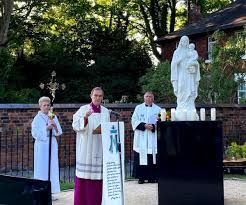 MORE INFORMATION
MORE INFORMATIONAn Informal Shrine in the care of the Diocese
St Mary's Priory, Brownedge Lane, Bamber Bridge PR5 6SP
Occupying a prominent location overlooking the busy junction between Brownedge Lane and Duddle Lane in Bamber Bridge, the shrine catches the eye and attention of the many people who walk or drive past each day.
The shrine takes the form of a statue of Our Lady, in reconstituted Carrara marble imported from Italy, holding the child Jesus in her arms, mounted on a block plinth encased in black granite. The statue is the same as that in the garden of the Venerable English College in Rome which has the title of ‘Our Lady of Consolation’. The statue was consecrated as ‘St Mary of Brownedge’.
The area around the new shrine has been landscaped and floodlights have been installed. Two black marble benches, complementing the plinth, have also been placed within the landscaped area, either side of, and facing, the shrine. The benches will provide the opportunity for people to rest and spend time in prayer and reflection before Our Lady.
The shrine provides a fitting focal point for the parish on those Marian feast days throughout the year which are associated with Our Lady, the patroness of the parish, including the traditional crowning of the statue of Our Lady, and procession, which normally takes place on the first Sunday in May.
Shrine prayer
Hail, Mary, full of grace,
the Lord is with thee.
Blessed art thou amongst women
and blessed is the fruit of thy womb, Jesus.
Holy Mary, Mother of God,
pray for us sinners,
now and at the hour of our death.
Amen.
Our Lady of Brownedge, Pray for us.
WALKING PILGRIMAGE TO THE SHRINE
The nearest Pilgrim Way to the Shrine is the Way of Our Lady of Fernyhalgh and St Alphonsa. More details here.
Salford: Our Lady of Manchester
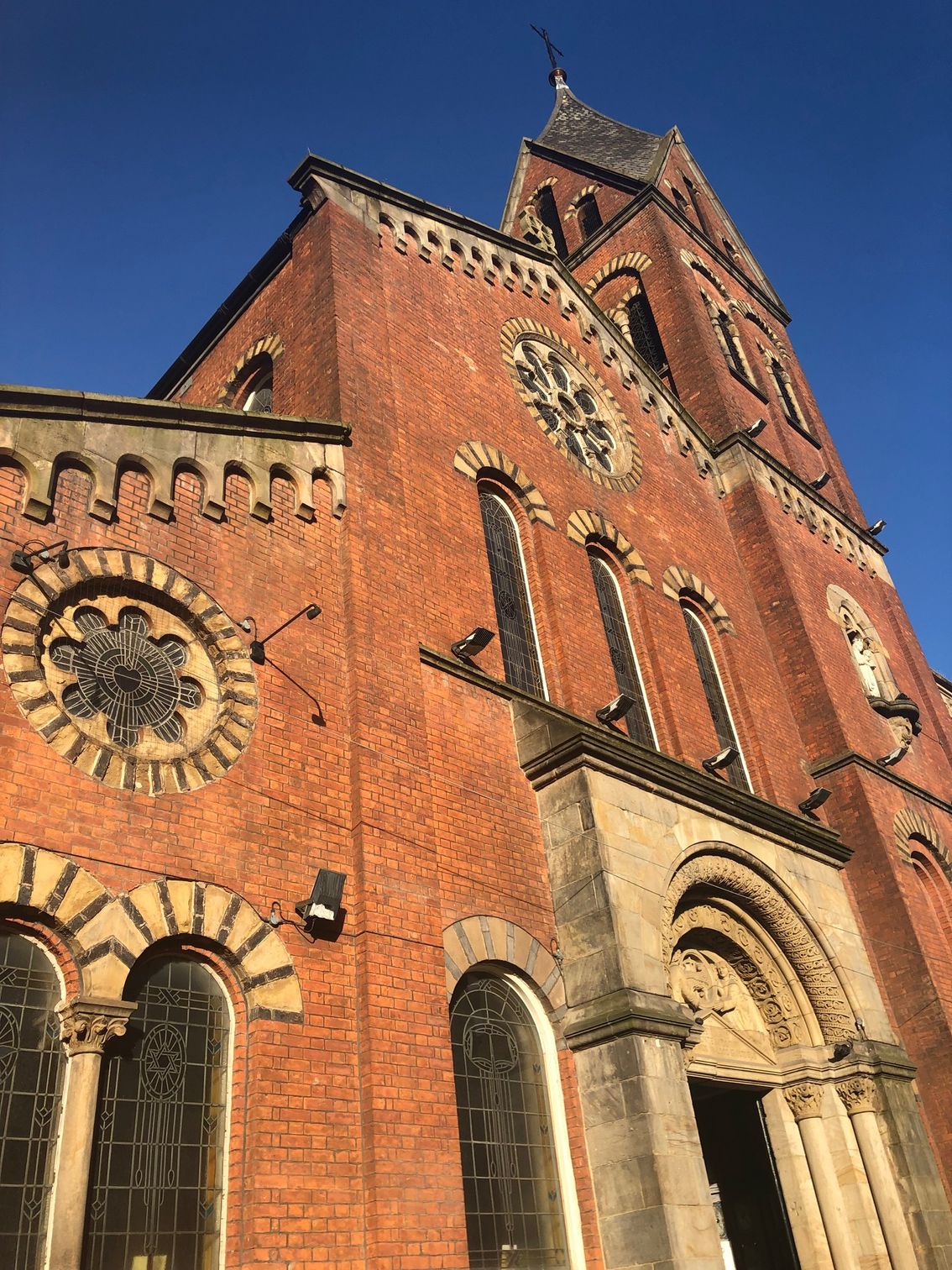 SHRINE WEBSITE
SHRINE WEBSITEAn Informal Shrine in the care of the Diocese
St. Mary’s (The Hidden Gem) Mulberry Street Manchester M2 6LN
Fr Broomhead purchased a plot of land in Mulberry street for the erection of a new church, dedicated to Our Lady’s Assumption into Heaven. The official opening of the church was on 30th November 1794. Along with the church, on the same plot of land, the presbytery stands next to it, and has been continuously occupied since 1794.
In 1833 Father Henry Gillow decided to re-roof and redecorate the church. However, the work was not overseen by a master builder and was therefore suspect. On 8th August 1835 most of the roof collapsed, causing significant interior damage. An outbreak of plague in Manchester around the time, and Father Gillow’s death from Typhus in 1837, made the search for a new site for St. Mary’s difficult. In the end, a decision was made to rebuild the church on the same site.
The High altar is surmounted by a reredos of Caen stone, on top of which are the figures of Angels. The life size figures of the reredos are (from left to right): Our Lady, St. Stephen, St. Patrick, St. Peter, above the tabernacle Our Lord, with his sacred heart, St John the apostle, St. Hilda of Whitby, St. Augustine of Canterbury and St. Joseph. On the left of the high altar, is a side altar of marble and Caen stone dominated by the life-size Pieta. Around the top are the figures of angels.
The shrine of Our Lady of Manchester is on the right of the high altar. The shrine also comprises the scene from Our Lord’s nativity on the left and the presentation in the Temple of Our Lady as a little girl by her parents, St. Joachim and St. Anne. In a wall to the right, is a stained glass window representing Our Lady and her prayer, the Magnificat.
Shrine prayer
Hail, Holy Queen, Mother of Mercy,
our life, our sweetness and our hope.
To you do we cry,
poor banished children of Eve.
To you do we send up our sighs,
mourning and weeping in this valley of tears
Turn then, most gracious advocate,
your eyes of mercy toward us,
and after this exile
show unto us the blessed fruit of thy womb,
Jesus.
O clement, O loving, O sweet Virgin Mary, pray for us, O holy Mother of God, that we may be made worthy of the promises of Christ.
Amen.
Our Lady of Manchester, Pray for us.
WALKING PILGRIMAGE TO THE SHRINE
The nearest Pilgrim Way to the Shrine is the Way of St Theodore. More details here.
Salford: The Schoenstatt Shrine
 SHRINE WEBSITE
SHRINE WEBSITEAn Informal Shrine in the care of the Schoenstatt Movement
Church of St John Fisher, Manchester Road, Kearsley, Bolton BL4 8QQ
The parish of St John Fisher was established in the early 1960s in anticipation of a large housing expansion into what was an area of coal mining and textile works. The current church was built in 1967-68. Closure of the pits and mills in the 1970s and 80s left the parish with a small population. Around this time the Apostolic Movement of Schoenstatt was looking for a site in the Bolton area to build a shrine, and the Right Rev. Terence John Brain, Bishop of Salford, offered land at St John Fisher’s for this purpose.
The Schoenstatt Movement is a Catholic Marian movement founded in Germany in 1914 by Fr Joseph Kentenich. The movement is named after the small locality of Schönstatt (which means "beautiful place") near Koblenz, in Germany. Schoenstatt works to revitalize the Church and society in the spirit of the Gospel. Its members seek to connect faith with daily life, especially through a deep love for Mary, who helps, educates and guides them in becoming better followers of Christ.
The shrine was opened on 1 October 2000. Like all 200 Schoenstatt shrines it is an exact replica of the original shrine. Since that time a retreat and pastoral centre has been established by the Movement.
Shrine Prayer
My Queen, my Mother,
I give myself entirely to you,
and to show my devotion to you,
I consecrate to you this day
my eyes, my ears, my mouth, my heart,
my entire self without reserve.
As I am your own, my good Mother,
guard me and defend me
as your property and possession.
Amen
Our Lady, Pray for us.
St John Fisher, Pray for us.
WALKING PILGRIMAGE TO THE SHRINE
The nearest Pilgrim Way to the Shrine is the Way of St Theodore. More details here.
Shrewsbury: SS Peter & Paul and St Philomena
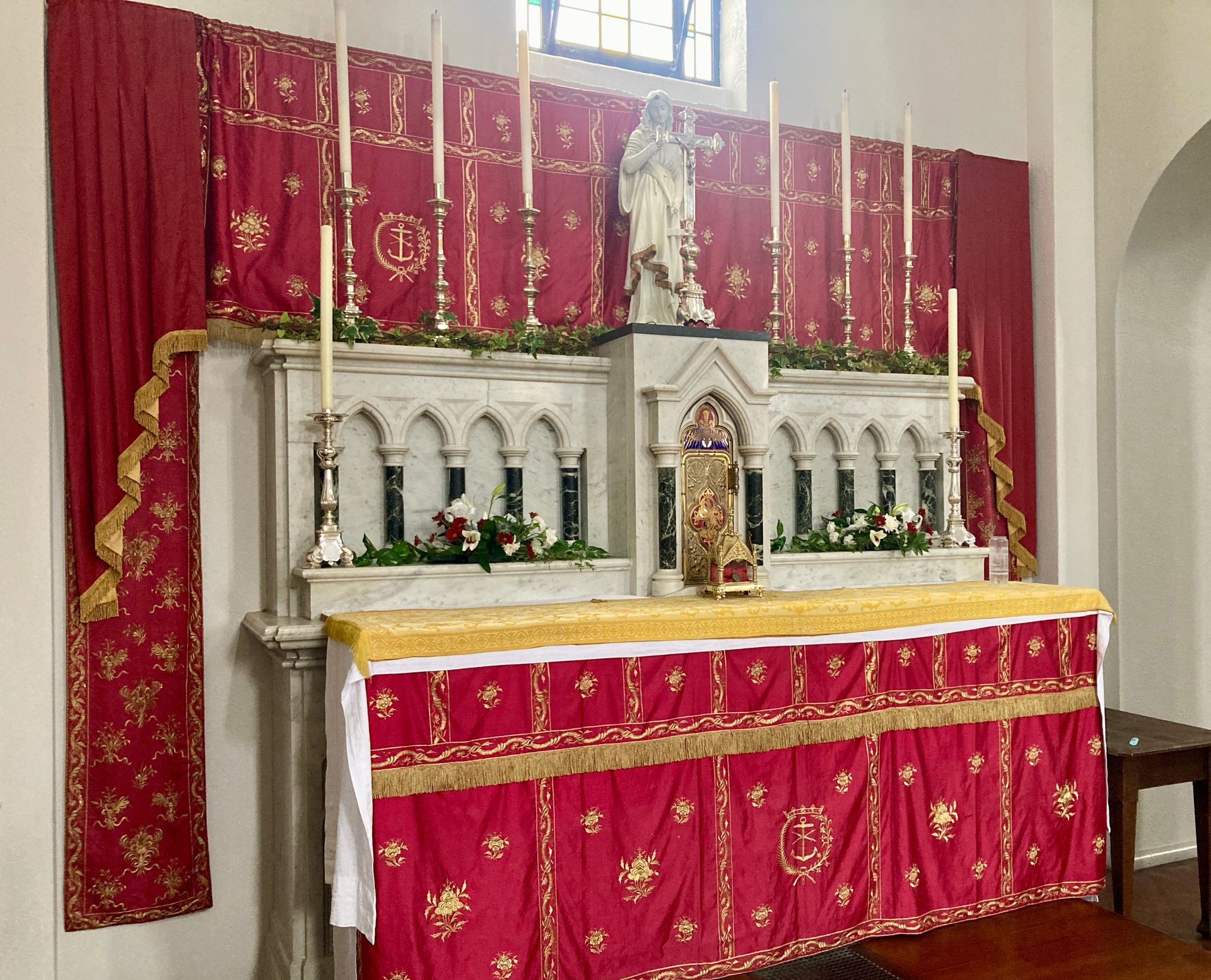 SHRINE WEBSITE
SHRINE WEBSITEA Diocesan Shrine in the care of the Institute of Christ the King
No 7 Atherton St, New Brighton, Wallasey, Merseyside CH45 9LT
The Shrine of Ss. Peter & Paul and St. Philomena has a green dome, from which it has gained the name "The Dome of Home" from local people. The origins of this nickname date back to the mid C20, when sailors would recognise they were close to Merseyside when they could see the church. the church.
The church opened in 1935. In 2006 the Shrine church united with 2 others, becoming the North Wallasey Catholic Community. In 2008, the church was closed by a decision of the local diocese.
In 2011 the church was re-opened for a weekly mass, and there was an expression of interest by a religious order, the Institute of Christ the King, to re-open the church fully and this was achieved in 2011.
The mission of the Institute of Christ the King is to spread the reign of Christ in all spheres of human life by drawing from the millennial treasury of the Roman Catholic Church, particularly her liturgical tradition, the unbroken line of spiritual thought and practice of her saints, and her cultural patrimony in music, art and architecture.
Shrine prayer
We beseech Thee, O Lord, to grant us the pardon of our sins by the intercession of Saint Philomena, virgin and martyr, who was always pleasing in Thy sight by her eminent chastity and by the profession of every virtue.
Amen.
St Peter, Pray for us.
St Paul, Pray for us,
St Philomena, Pray for us.
WALKING PILGRIMAGE TO THE SHRINE
The Way of St Philomena ends at the Shrine. More details here.
Southwark: Becket Shrine & Martyrs Chapel
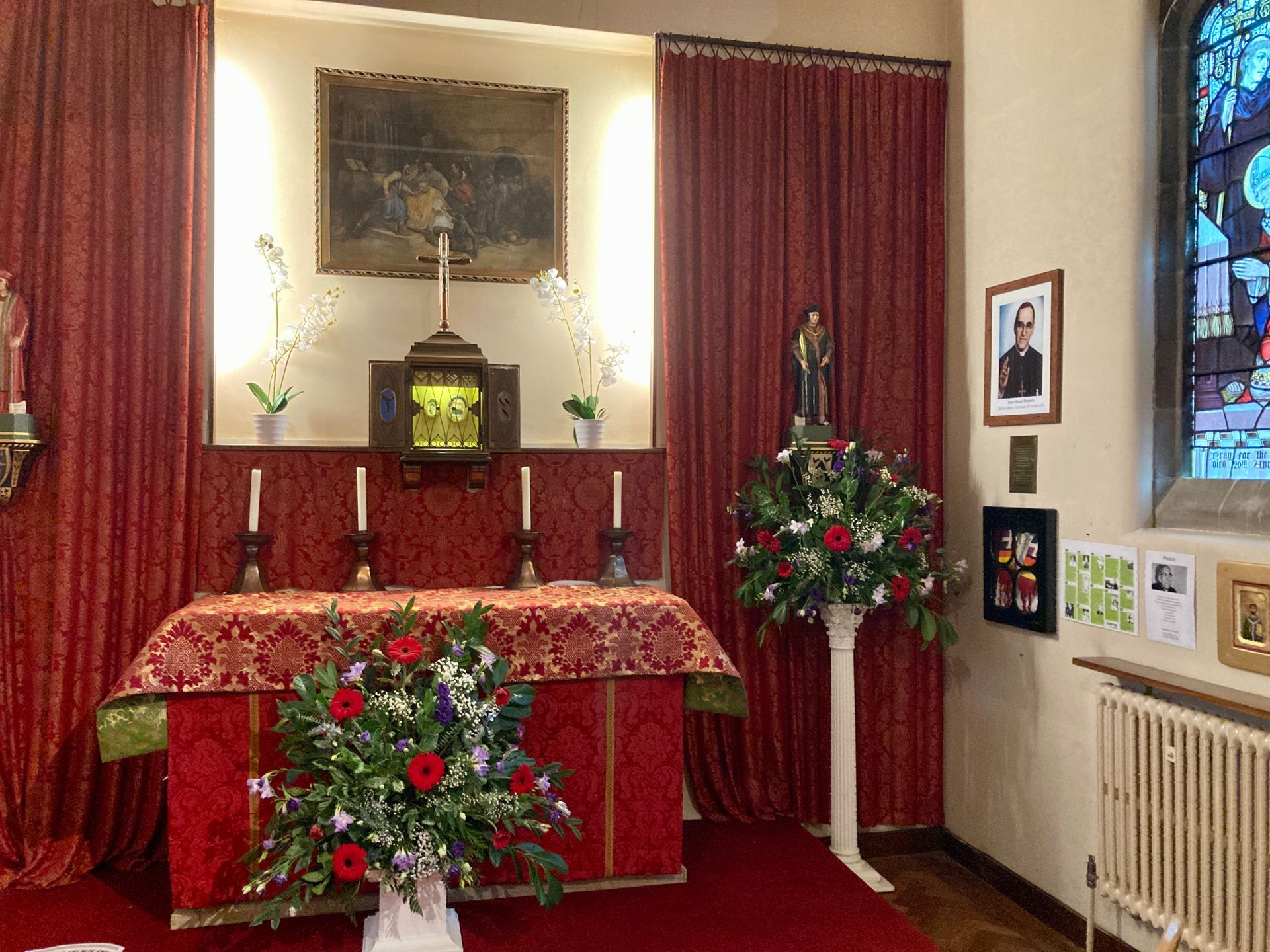 SHRINE WEBSITE
SHRINE WEBSITEA Diocesan Shrine in the care of the Archdiocese
The Church of St Thomas of Canterbury, 59 Burgate, Canterbury, Kent CT1 2HJ
The Church of St Thomas of Canterbury is within a 5-minute walk of Canterbury Cathedral. This charming gothic-style parish church has several fine stained-glass windows, Stations of the Cross which were once in Westminster Cathedral and a striking Canterbury Saints Chapel.
The church was designated as a Diocesan Shrine by Archbishop John Wilson in 2019. It is home to two relics of Becket; a finger bone and a piece of his vestment. The Martyrs Chapel houses a stole that once belonged to Saint Oscar Romero, and three major Reformation Martyrs, Saint John Fisher, Thomas More and John Stone, are also honoured.
Shrine prayer
God, for the sake of whose Church the glorious Bishop Thomas fell by the sword of ungodly men: grant, we beseech Thee, that all who implore his aid, may obtain the good fruit of his petition.
Through our Lord Jesus Christ, Who livest and reignest with Thee in the unity of the Holy Spirit, forever and ever.
Amen.
St Thomas Becket, Pray for us.
St Oscar Romero, Pray for us.
St John Fisher, Pray for us.
St Thomas More, Pray for us.
WALKING PILGRIMAGE TO THE SHRINE
The shrine is on the Becket Way (more details here) and the Augustine Camino (more details here).
Southwark: Our Lady of Hartley
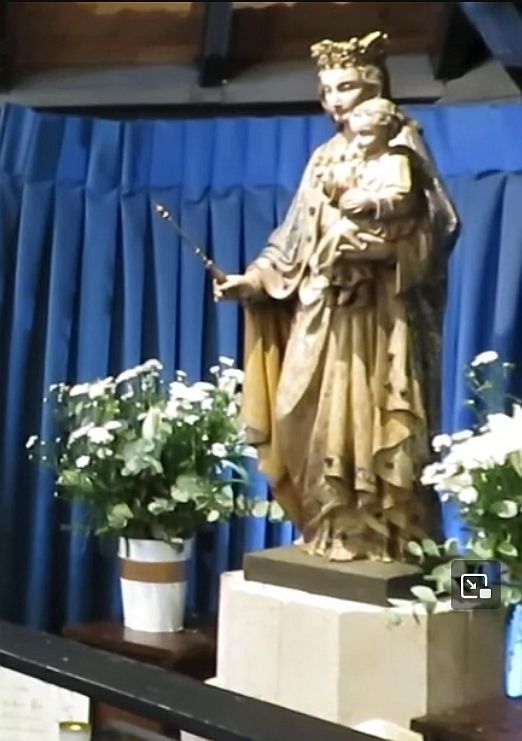 SHRINE WEBSITE
SHRINE WEBSITEA Diocesan Shrine in the care of the Archdiocese
The Oratory of St Francis de Sales, Hartley, Kent DA3 8DW
The parish owes its existence to Miss Beatrice Davies-Cooke, who was from an aristocratic family directly descended from the Plantagenets. The Church was established in 1913 following her wish to open a Catholic church where none existed, thus answering the needs of Catholics in a rural area. Beatrice bought one holding that contained a farmhouse and outbuildings including a thatched barn that was around 400 years old. This was duly adapted to serve as an oratory and for many years clergy visited from London to celebrate Mass. It was later served by the Carmelites for many decades from 1937 onwards.
A shrine to Our Lady was created to house a contemporary copy of an ancient carving of Our Lady in Flanders. Many miracles had been attributed to prayers made at this original statue, and it was not long after the replica had been installed at Hartley that reports began to emerge from parishioners to the effect that their prayers were also being answered. Later Hartley became a place of safety for many European refugees during WWI.
Impressed by the successful mission of the St Francis De Sales Oratory, Pope Benedict XV granted the formal title of 'Our Lady of Hartley' to the replica statue, thereby encouraging continued prayer to Our Blessed Lady. He also attached a plenary indulgence which can be gained by visiting the shrine and praying for peace in Europe. There is an annual pilgrimage on a Saturday in May.
Shrine prayer
Hail, Mary, full of grace,
the Lord is with thee.
Blessed art thou amongst women
and blessed is the fruit of thy womb, Jesus.
Holy Mary, Mother of God,
pray for us sinners,
now and at the hour of our death.
Amen.
Our Lady of Hartley, Pray for us.
St Francis de Sales, Pray for us.
WALKING PILGRIMAGE TO THE SHRINE
The nearest Pilgrim Way is the Becket Way. More details here.
Southwark: Our Lady of Mount Carmel & St Simon Stock
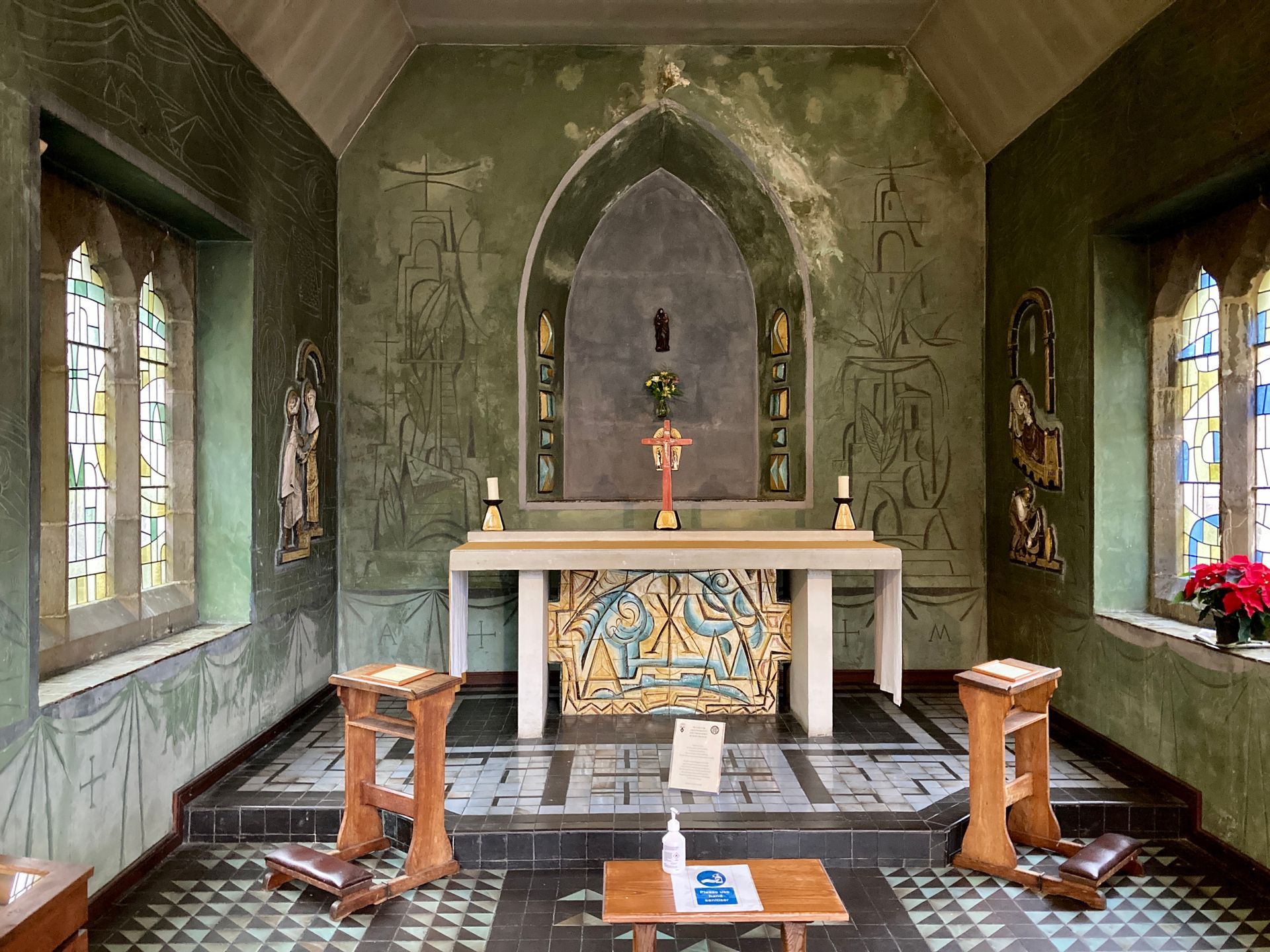 SHRINE WEBSITE
SHRINE WEBSITEA Diocesan Shrine in the care of the Carmelite Order
The Friars, Aylesford, Kent ME20 7BX
The Carmelite Order arrived in Kent in 1242. They were forced from their priory at Aylesford during the Dissolution of the Monasteries in 1538, and the buildings were put to various uses over the centuries.
In 1949 the Carmelites returned after an absence of over 400 years. They restored the tranquil gardens, built chapels and adorned them with fine ceramic artworks. Father Malachy Lynch who spearheaded the reconstruction, described the Friars as a “prayer in stone”.
The shrine at Aylesford is dedicated to Our Lady, and there are beautiful chapels dedicated to the saints of Carmel, notably St Simon Stock. Stock was an early Prior General of the Order who experienced a vision of Our Lady, perhaps at Aylesford. In the vison she gave him a scapula, two small pieces of brown cloth, joined together with cord, which is won over the shoulders. The scapular developed in the Renaissance as a miniature religious habit and became popular amongst lay people who want to have a discreet but visible sign of identifying with the Carmelite way of life. Stock died in 1261 and was buried in Bordeaux, but in 1951 some of his relics were brought to Aylesford and can be venerated in the Relic Chapel.
Shrine prayer
O most beautiful Flower of Mount Carmel, Fruitful Vine, Splendour of Heaven, Blessed Mother of the Son of God, Immaculate Virgin, assist me this my necessity.
O Star of the Sea, help me and show me herein you are my Mother.
O Holy Mary, Mother of God, Queen of Heaven and Earth, I humbly beseech you from the bottom of my heart, to succour me in this necessity; there are none that can withstand your power.
O, show me herein you are my Mother, O Mary, conceived without sin, pray for us who have recourse to thee. (3 times)
Sweet Mother, I place this cause in your hands. (3 times)
St Simon Stock, Pray for us.
WALKING PILGRIMAGE TO THE SHRINE
The Shrine is on the Augustine Camino (more details here) and the Becket Way (more details here).
Southwark: St Augustine & the National Pugin Centre
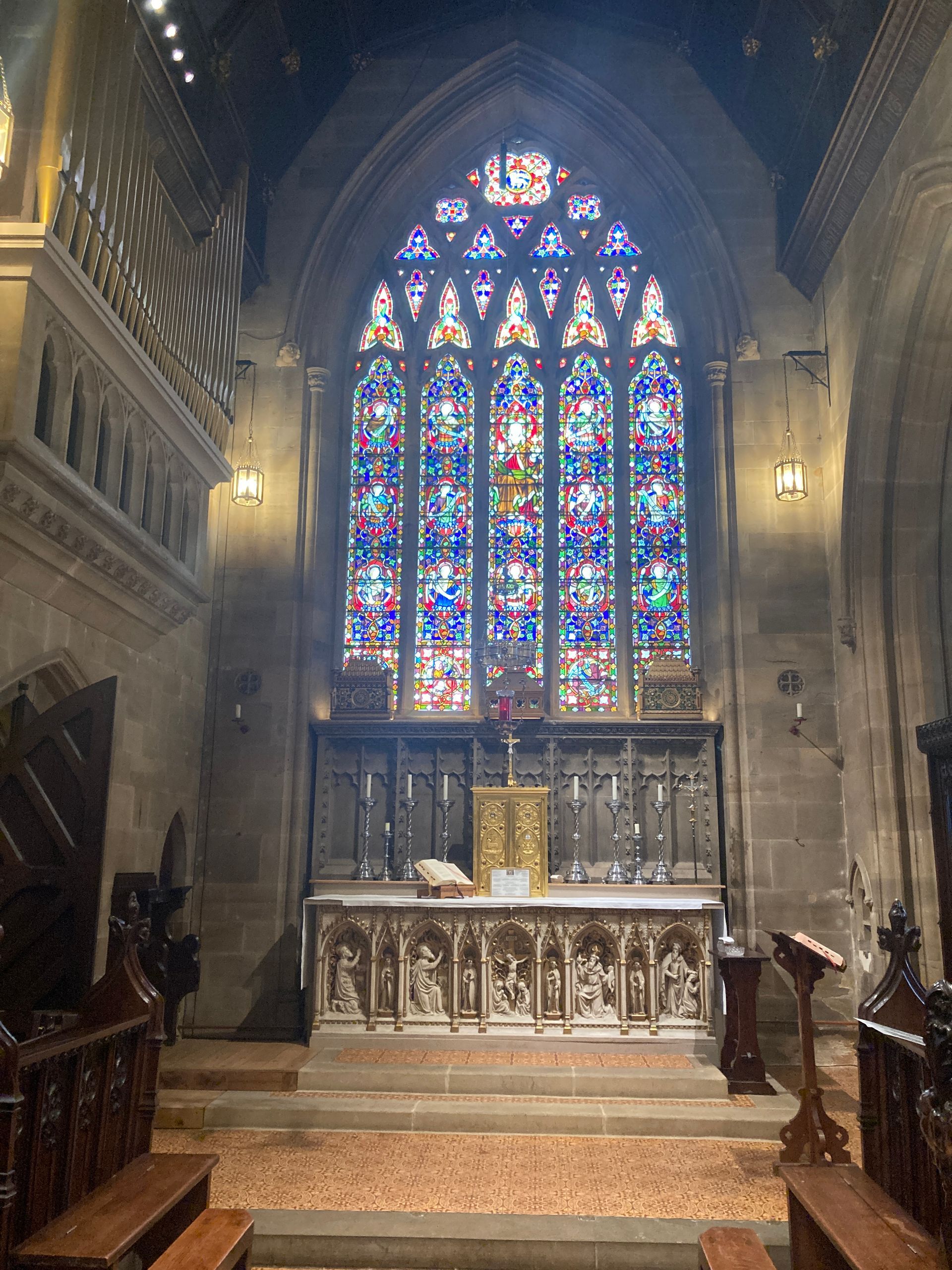 SHRINE WEBSITE
SHRINE WEBSITEA Diocesan Shrine in the care of the Archdiocese
St Augustine's Road, Ramsgate, Kent CT11 9NY
The Church of St Augustine houses the Southwark diocesan shrine to the 'Apostle to the English'. St Augustine brought the Christian faith to England following the collapse of the Roman Empire. He arrived from Rome in 597 AD with forty monks at nearby Pegwell Bay. He had baptised King Ethelbert of Kent and ten thousand of his subjects within the year.
The Church holds authenticated relics of St Augustine, St Gregory the Great, who was the pope who oversaw the mission to the English, and St Lawrence, who became archbishop of Canterbury after Augustine. They are housed in a modern reliquary within the church which was built by the renowned 19th Century architect and Catholic convert, Augustus Pugin, who lived next door.
The stories of Augustine and Augustus are told in the Visitor Centre.
Shrine prayer
O blessed Virgin Mary, Mother of God and our most gentle Queen and Mother, look down in mercy upon England thy "Dowry" and upon us all who greatly hope and trust in thee.
By thee it was that Jesus our Saviour and our hope was given unto the world; and He has given thee to us that we might hope still more.
Plead for us thy children, whom thou didst receive and accept at the foot of the Cross, O sorrowful Mother.
Intercede for our separated brethren, that with us in the one true fold they may be united to the supreme Shepherd, the Vicar of thy Son.
Pray for us all, dear Mother, that by faith fruitful in good works we may all deserve to see and praise God, together with thee, in our heavenly home.
Amen.
St Augustine of Canterbury, Pray for us.
St Gregory the Great, Pray for us.
WALKING PILGRIMAGE TO THE SHRINE
The Augustine Camino ends at the Shrine. Details here.
Southwark: St Jude
SHRINE WEBSITEA National Shrine in the care of the Carmelite Order
The Shrine of St Jude, 34 Tanners Street, Faversham, Kent ME13 7JW
The National Shrine of Saint Jude, Apostle and Martyr, is based in Faversham and is primarily a place of prayer. Saint Jude is best known as the patron of desperate or difficult cases and so he is a saint of hope.
In 1955, Fr Elias Lynch, a Carmelite friar, founded the Shrine for two reasons: first, because he was responding to the needs of the post-war generation who were looking for hope, and secondly because the Carmelite charism is so deeply rooted in the Word of God. Over the years it has been called “a jewel” and “a common meeting ground between Anglicans and Catholics”.
In 2020, the Shrine was given five stars by the new guide 'Britain's Pilgrim Places' produced by the British Pilgrimage Trust.
Shrine prayer
St. Jude, you witnessed the healing power of our Lord Jesus.
You saw His compassion for the sick and dying.
You yourself touched the sick, shared the sorrows of the mournful, and encouraged the despairing.
You received this authority and healing power to work wonders, to cure the incurable, to make people whole.
We ask you to intercede with our brother, Jesus,
to send His saving grace to heal the sickness and suffering of (name) to uplift his/her despondent spirit,
and to instill hope in his/her heart.
Amen.
St Jude, Pray for us.
WALKING PILGRIMAGE TO THE SHRINE
The Shrine is on the Augustine Camino. More details here.
Southwark: St Oscar Romero
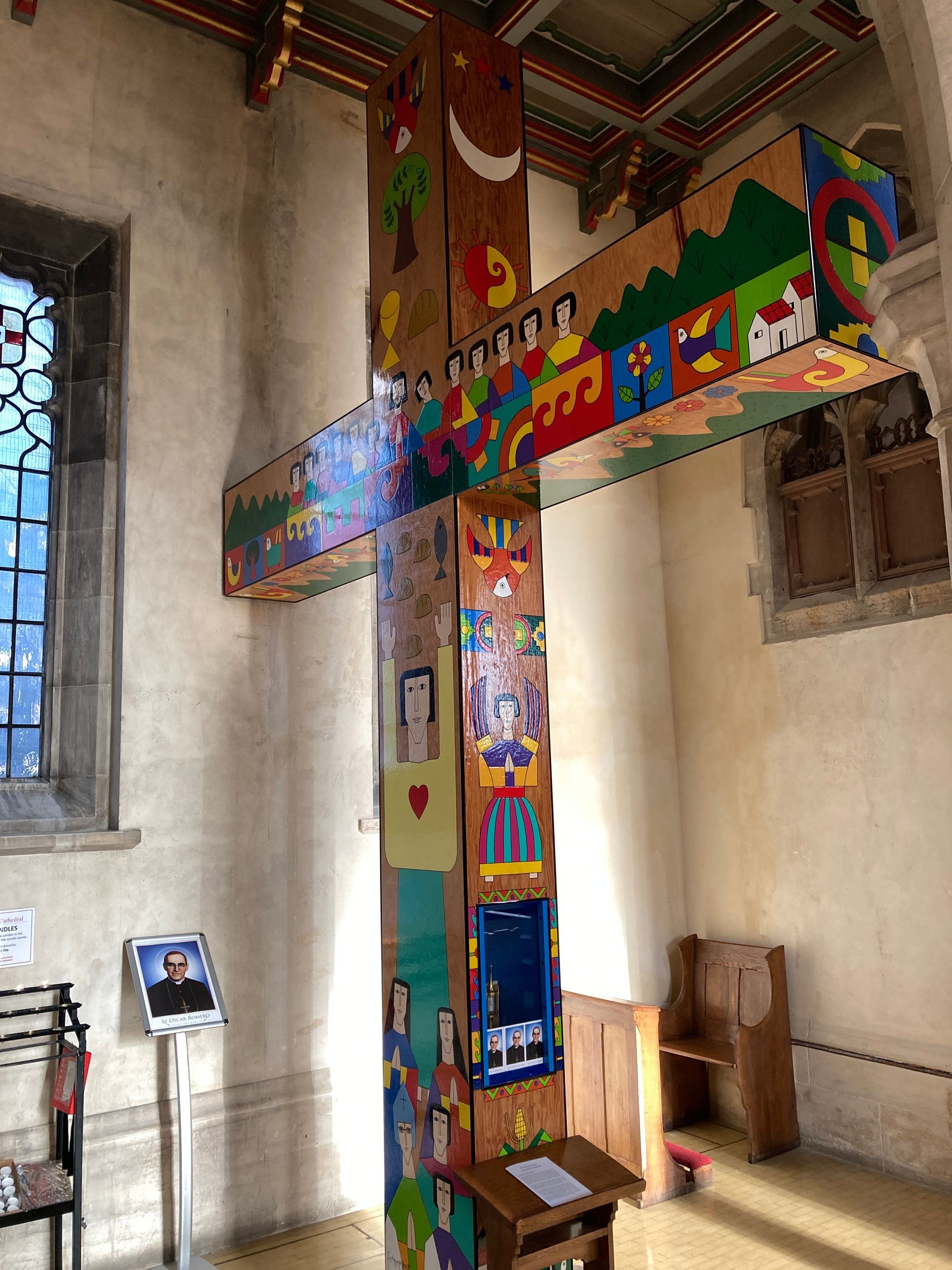 SHRINE WEBSITE
SHRINE WEBSITEA National Shrine in the care of the Archdiocese
St George's Cathedral, Westminster Bridge Road, London SE1 7HY
Óscar Romero (15.8.1917 – 24.3.1980) was a Catholic priest and bishop in El Salvador. He became Archbishop of San Salvador in 1977 and was regarded as a social conservative at the time. However he was deeply affected by the murder of his friend and fellow priest Rutilio Grande and became an outspoken critic of the military government of El Salvador. He spoke out bravely against social injustice and violence amid the escalating conflict between the government and left-wing insurgents that led to the Salvadoran Civil War.
In 1980, Romero was shot dead by an assassin while celebrating Mass. No one was ever convicted for the crime, but investigations by the UN-created Truth Commission for El Salvador concluded that the killing had been ordered by Major Roberto D'Aubuisson, a death squad leader and later founder of the right-wing Nationalist Republican Alliance political party.
Romero was declared a martyr by Pope Francis in 2015 and beatified on 23 May 2015. During his beatification, Pope Francis declared that his "ministry was distinguished by his particular attention to the most poor and marginalized." Pope Francis canonized Romero on 14 October 2018.
The Cathedral was originally built by A.W.N. Pugin in 1841-48 and at the time was the largest Catholic church in England, and the obvious choice of a cathedral for the new Diocese of Southwark, created in 1850. The cathedral contains several important furnishings by Pugin and his son Edward. The building was badly damaged by wartime bombing and rebuilt in a different form by Romilly Craze. The new design is impressive, but the non-completion of the tower diminishes the impact.
On the right side of the nave is the Archdiocesan Shrine to St Oscar Romero, a large and colourful reliquary cross, decorated in South American style. It holds relics belonging to Saint Oscar Romero, namely his skullcap (zuchetto) and a piece of the vestment that he was wearing when he was assassinated in 1980 whilst saying Mass in San Salvador. The shrine was blessed on 19th September 2013 by Archbishop Peter Smith and was elevated to a National Shrine by the Bishops of England & Wales in 2023.
Shrine prayer
O Lord Father of Mercy, who through Jesus Christ and the intercession of the Virgin Mary, Queen of Peace, and the action of the Holy Spirit, has bestowed on Saint Oscar Romero the grace of being an exemplary shepherd at the service of the Church, especially giving preference to the poor and needy.
Grant, Lord, that I may also learn to live according to the gospel of your Son, glorify your Saint Oscar Romero and concede, through his intercession, the favour I ask of you...
Amen.
St Oscar Romero, Pray for us.
St George, Pray for us.
WALKING PILGRIMAGE TO THE SHRINE
The Shrine is the start of the Romero Way. More details here.
Westminster: Blessed Sacrament
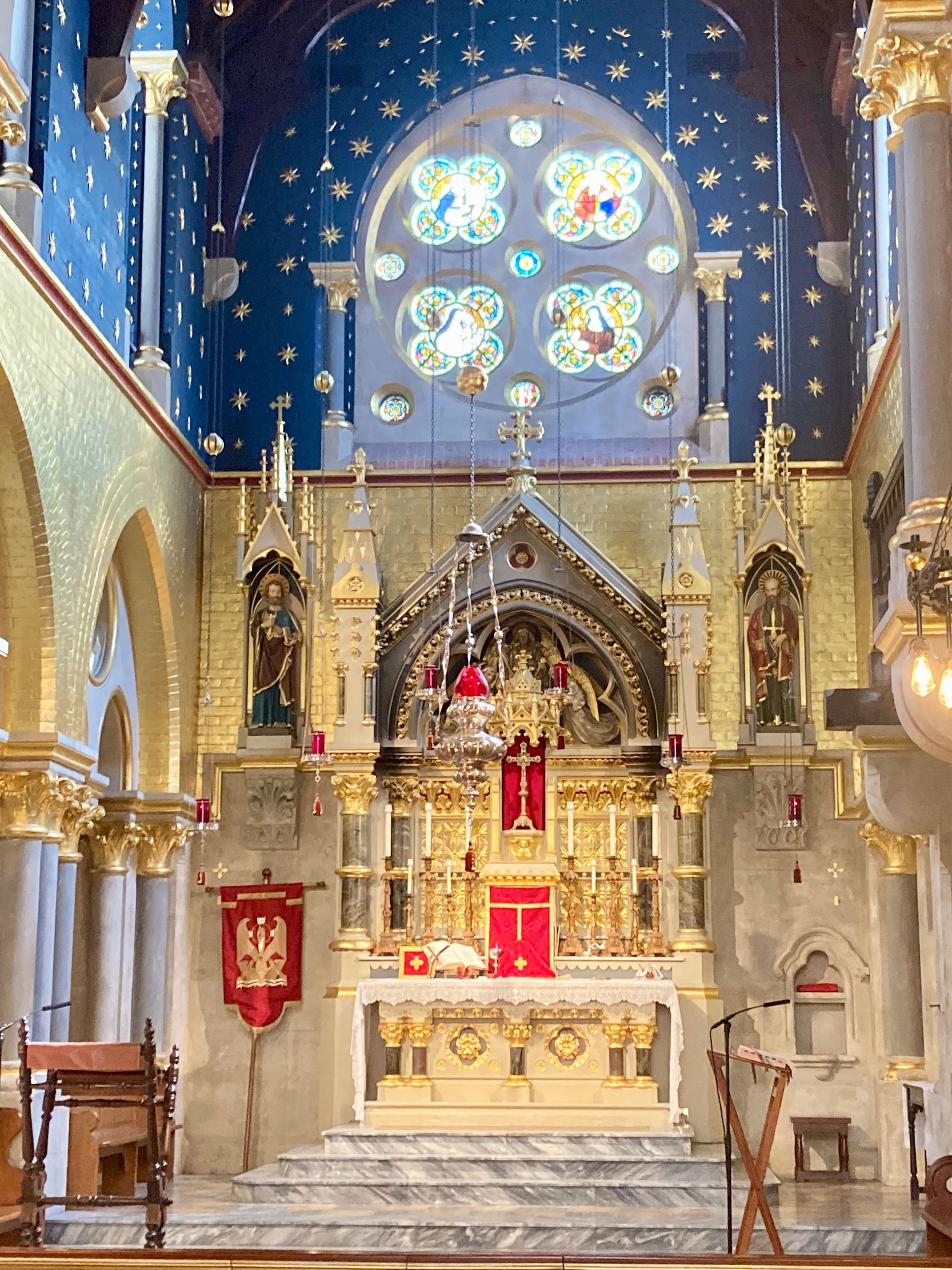 SHRINE CHAPEL
SHRINE CHAPELA Diocesan Shrine in the care of the Archdiocese
1-5 Maiden Lane, Covent Garden, London WC2E 7NB
The Church was designed in the 1870s to become the first church in England to be given the dedication of Corpus Christi since the Reformation. It was built ‘as an act of reparation for the indignities offered to the Blessed Sacrament in this country in the sixteenth century and since’.
The interior is quiet after the bustling surrounding streets. There are statues and images of saints who have particularly upheld the Church’s teaching of Christ’s real presence in the Eucharist. In 2018 Cardinal Vincent Nichols raised Corpus Christi to become the Diocesan Shrine of the Blessed Sacrament. The Church is the home of the Catholic Stage Guild.
Shrine prayer
O Jesus, present in the Sacrament of the Altar,
teach all nations to serve you with a willing heart,
knowing that to serve God is to reign.
May your sacrament, O Jesus,
be light to the mind,
strength to the will,
joy to the heart.
May it be the support for the weak,
the comfort for the suffering,
the wayfaring bread of salvation for the dying,
and, for all, the pledge of future glory.
Amen
(Pope John XXIII)
WALKING PILGRIMAGE TO THE SHRINE
The Shrine is on the Way of Two Cathedrals and Four Shrines. More details here.
Westminster: Our Lady of the Rosary
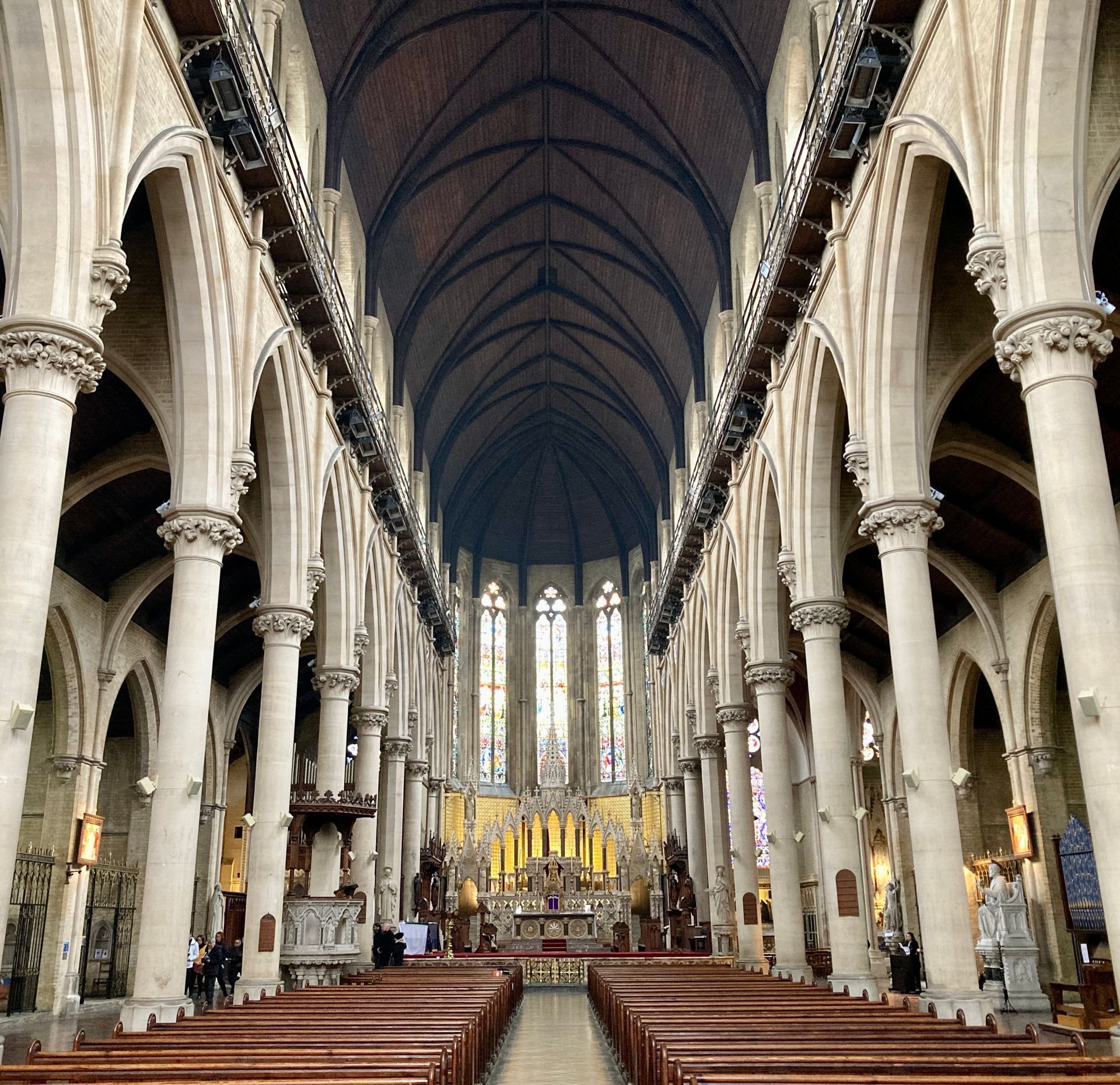 SHRINE WEBSITE
SHRINE WEBSITEA Diocesan Shrine in the care of the Order of Preachers (Dominicans)
St Dominic’s Priory, Southampton Road, Haverstock Hill, London NW5 4LB
This Church is one of the first in England to be built by the revived Dominican Order. In 1861 the Order were invited by Cardinal Wiseman to take over the Kentish Town mission and they purchased the site in 1862. The Church was completed in 1883. The long nave has fourteen side chapels which, with the window over the high altar, symbolise the fifteen Mysteries of the Rosary. This plan is unique in England.
The Shrine of Our Lady of Lourdes was added in 1912-14. It is a small replica of the grotto at Lourdes and was restored in 2002.
The Dominicans are still located in the priory, and there is a community of Dominican Sisters nearby in Constantine Road.
Shrine prayer
O Mary, turn down your eyes of pity towards us too and have mercy on us who are in such need of your help.
Show yourself to us also, as you showed yourself to so many, a true Mother of Mercy,
while from the bottom of our hearts we greet and invoke you as the Sovereign and Queen of the Most Holy Rosary.
Amen.
St Dominic, Pray for us.
WALKING PILGRIMAGE TO THE SHRINE
The Shrine is on the Way of Two Cathedrals and Four Shrines. More details here.
Westminster: Our Lady of Willesden
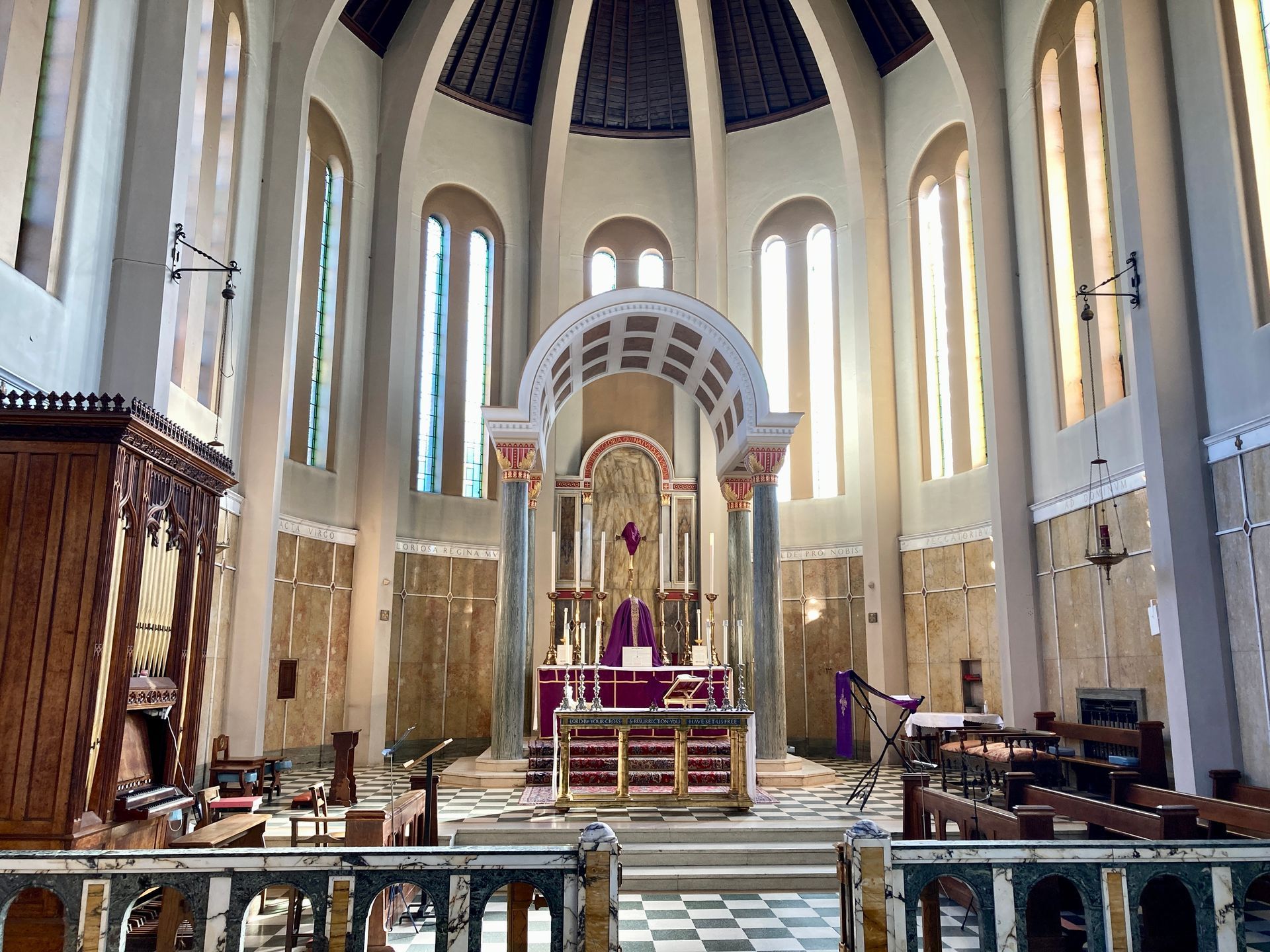 SHRINE WEBSITE
SHRINE WEBSITEA National Shrine in the care of the Archdiocese
1 Nicoll Road, Willesden, London NW10 9AX
According to tradition, Our Lady has for centuries graced this site with her presence and a holy well which was deemed to possess miraculous properties. A Visitation report of 1249 mentions the presence of two statues of Our Lady, one of which must have been the ‘Black Madonna’, probably adorned with precious metals and jewels.
The Shrine’s popularity reached its zenith at the turn of the sixteenth century, when it was frequented Queen Elizabeth of York and the future St Thomas More. A contemporary document in 1537 records that Our Lady appeared to Dr Crewkehorne, a priest devotee of the shrine, and said that she wished to be honoured at Willesden as she had in times past. Sadly in 1538 the ‘Black Madonna’ was burnt by order of Thomas Cromwell.
Mass was said again in the district in 1885. In the following year a temporary tin chapel was erected on a site in Manor Park Road. Dr Crewkehorne’s hope was fulfilled when the Shrine of Our Lady of Willesden was revived in the 1890s, and a new statue was blessed by Cardinal Vaughan. The current much larger church in modern Romanesque style was built in 1930. The shrine chapel was refurbished in 1995.
Shrine prayer (Cardinal Francis Bourne)
Oh Immaculate Queen, Our Lady of Willesden, we consecrate ourselves and all we have and are to you forever in your holy shrine.
Make this Shrine glorious as of old. Bring pilgrims to worship at it.
Convey their prayers to God in your own hands.
Pray for us all.
Pray for the conversion of all people to the religion of your Divine Son.
And obtain pardon and mercy for our beloved Dead who have gone before us with a sign of faith and sleep the sleep of peace.
Amen.
Our Lady of Willesden, Pray for us.
WALKING PILGRIMAGE TO THE SHRINE
The Shrine is on the Way of Two Cathedrals and Four Shrines. More details here.
Westminster: The Tyburn Martyrs
 SHRINE WEBSITE
SHRINE WEBSITEAn Informal Shrine in the care of the Tyburn Benedictine sisters
Tyburn Convent, 8 Hyde Park Place, London W2 2LJ
Tyburn Convent is situated near the site of the Tyburn Gallows where more than 100 Catholics were martyred during the Reformation. It is a cloistered community of Benedictine contemplative nuns who live by the ancient monastic Rule of St Benedict. The charism and work of the community is prayer. It is the Mother House of monasteries worldwide.
In 1901 the young community of Mother Marie Adèle Garnier fled to England on account of the laws of France against religious Orders. They took possession of Tyburn Convent in London in 1903 with the special mission of prayer for the people of England & Wales.
For more than a hundred years the Tyburn community has been a place of Perpetual Eucharistic Adoration. Anyone can pray in the chapel, and the Shrine, which holds relics of the martyrs, can be visited by prior appointment.
Shrine prayer
O God, in whom there is no change or shadow of alteration, you gave courage to the Holy Martyrs.
Grant unto us, we beseech you, through their intercession, the grace to always value the Holy Mass.
May we be strengthened to serve you in imitation of the courage of these Holy Martyrs.
We ask this through Jesus Christ, Your Son, who lives and reigns with You in the unity of the Holy Spirit, forever.
Amen.
All Tyburn Martyrs, Pray for us.
St Benedict, Pray for us.
WALKING PILGRIMAGE TO THE SHRINE
The Shrine is on the Way of Two Cathedrals and Four Shrines. More details here.
Wrexham: St Padre Pio
 SHRINE WEBSITE
SHRINE WEBSITEA national Shrine in the care of the Vincentian Congregation
Divine Retreat Centre, Monastery Rd, Pantasaph, Holywell, CH8 8PE
The Divine Retreat Centre was inaugurated in Pantasaph in 2022 by Rt Rev Peter Brignall, Bishop of the Wrexham. The centre is home to Calvary Hill, Marian grotto & Rosary Way and the national shrine of Padre Pio, which have become special places of prayer and pilgrimage. Thousands visit throughout the year. Before becoming a retreat centre, the grounds were home to a Franciscan community.
Shrine Prayer
O God, You gave St. Pio of Pietrelcina, the great privilege of participating in a unique way in the passion of Your Son.
Grant me through his intercession the grace of. . . (here state your petition) which I ardently desire;
and above all grant me the grace of living in conformity with the death of Jesus to arrive at the glory of the resurrection.
Glory be to the Father. . .(three times)
Amen
St Padre Pio, Pray for us
St Francis of Assisi, Pray for us
St Vincent, Pray for us
WALKING PILGRIMAGE TO THE SHRINE
The Shrine is on the North Wales Pilgrim Way and a short distance from the end of the Holywell Way. More details here.
Wrexham: St Winefride's Well
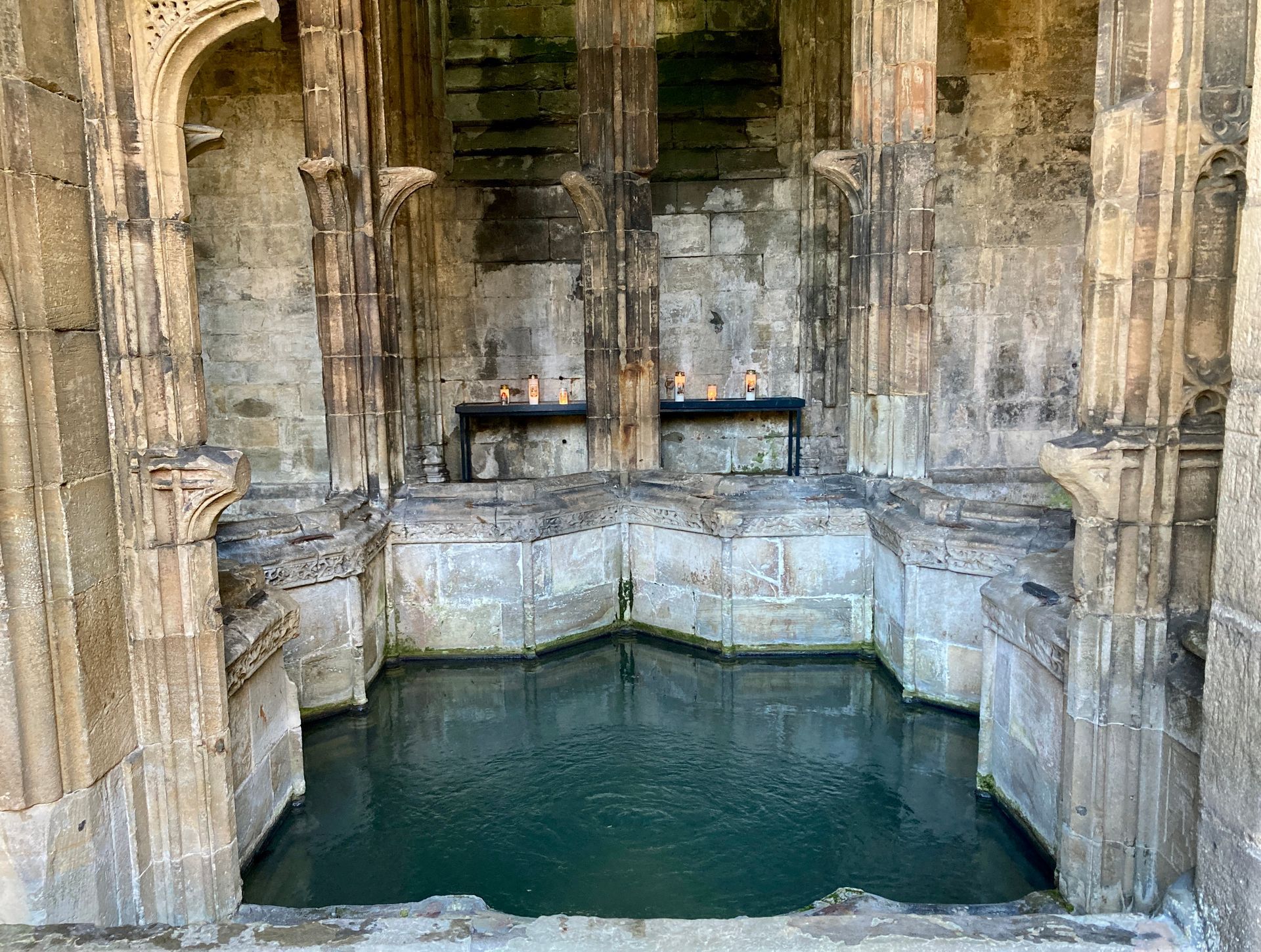 SHRINE WEBSITE
SHRINE WEBSITEA Welsh National Shrine in the care of the Diocese
Plessington House, Greenfield St, Holywell, Flintshire CH8 7PN
St Winefride’s Well is believed to be the only British shrine that has a history of uninterrupted pilgrimage from the Middle Ages, through the period of Catholic persecution, to the present day.
St Winefride was a C7 Christian martyr who, according to legend, was decapitated by a lustful prince and then miraculously restored to life. The well is said to have sprung up where her head hit the ground.
The first reference to Holywell as a place of pilgrimage is 1115. The well was granted to the Benedictine monks of Basingwerk Abbey in 1246, who held it until the suppression of the monasteries. Construction of the crypt is attributed to Margaret Beaufort, the mother of King Henry VII. After the Reformation several attempts were made by the authorities to prevent Catholic pilgrimage to the well, but devotions continued.
From the C18 the well attracted secular visitors because of the belief that the well-water had natural healing properties due to its mineral content. Two bathhouses were built in 1869. In 1917, the well dried up because of local mining operations and water had to be diverted from a new underground source.
In 2023 Holywell was accorded the status of a national shrine by the Catholic Bishops’ Conference of England & Wales.
Shrine prayer
O blessed Winefride,
pure virgin and glorious martyr,
so especially chosen, so divinely graced
and so wonderfully restored from death to life!
Hope of all that fly unto you with full confidence and humility!
We, though, unworthy, yet your devoted pilgrims, make our petitions to you.
Sanctuary of piety, look upon us with patient eyes;
receive our prayers, accept our offerings,
and present our supplications at the throne of mercy,
that through thy powerful intercessions
God may be pleased to bless our pilgrimage,
and to grant our requests and desires;
through Christ our Lord.
Amen.
St Winefride, Pray for us.
WALKING PILGRIMAGE TO THE SHRINE
The Shrine is on the Holywell Way. More details here.
